
- Item Drop Cats
- Anti-Red Cats
- Anti-Black Cats
- Anti-Angel Cats
- Cats with Strong ability
- Area Attack Cats
- Cats requiring Awakening for True Form

Catway (Super Rare Cat)
- View history
Catway is a Super Rare Cat that can be unlocked when beating the stage Clionel Ascendant appearing on the 7th , 8th , 21st and 22nd of every month. True Form increases health and attack power. This unit was later added into The Battle Cats Unite via the 1.0.7 September 15, 2023 Live Download Patch and the stage to unlock him is permanent.
- 1 Evolution
- 3.1 True Form
- 4 Cat Combos
- 5 Description
- 7 Upgrade Cost
- 9 Appearance
- 10 Animations
- 13 Reference
Evolution [ ]
Evolves into Drone Cat at level 10.
Evolves into Time Traveller Cat when obtained from A Cat Screaming Love (guaranteed to drop) and is level 20 or above.
Performance [ ]
+ Strong against Red , Black and Angel enemies
- Decent DPS, especially in True Form
- Below average health [Normal, Evolved]
Strategy/Usage [ ]
Catway shares range, attack frequency and recharge time with Figure Skating Cats , making this unit very similar, but with drastically worse stats, which make him replaceable, especially against traits he doesn't target. He is decent against his target traits, especially if you just don't have anything better to replace him with, which can remain true for Angel Enemies for a decent time.
True Form [ ]
Time Traveller Cat gains increased damage and health. With this, Time Traveller Cat can finally differentiate itself from Slapstick Cats by dealing significantly higher damage against the traits he targets.
Description [ ]
Switch EN/JP
- Chapter 1: 800¢
- Chapter 2: 1,200¢
- Chapter 3: 1,600¢
Upgrade Cost
- Level 30-59 upgrades cost Catseyes: 30-44 and 50-54 = 1 Catseye, 45-49 and 55-59 = 2 Catseyes
Multi Hit ( 200 200 {{{Normal Hit 1 Note}}} + 0 0 {{{Normal Hit 2 Note}}}) Strong against Red , Black , and Angel enemies
Multi Hit ( 265 265 {{{Evolved Hit 1 Note}}} + 0 0 {{{Evolved Hit 2 Note}}}) Strong against Red , Black , and Angel enemies
Multi Hit ( 395 395 {{{True Hit 1 Note}}} + 0 0 {{{True Hit 2 Note}}}) Strong against Red , Black , and Angel enemies
Multi Hit ( 395 395 {{{Ultra Hit 1 Note}}} + 0 0 {{{Ultra Hit 2 Note}}}) None
- HP = Health ; AP = Attack Power ; DPS = Damage Per Second ; 2 Movement Speed = 1 Range/f
- f = frame ; 30f = 1 second ; Attack Animation = Idle + Foreswing + Backswing (f)
- Catseye , User Rank and game progress are essential to achieving max level, see here for details.
- See here to understand Treasure effects.
Appearance [ ]
- Normal Form: A cat riding a Segway . A wave gun appears between its wheels when attacking.
- Evolved Form: A cat flying with four drone propellers extending from its sides. Four other little pegs are also attached as feet, supposedly for landing. A wave gun pops out of a hatch on its underside when attacking.
- True Form: A cat riding an extremely flat hovering vehicle with four glowing wheels pointed toward the ground and an inactive desk lamp pointed at the rider. The seat is attached by a spring which extends comically when knocked back. A wave gun pops out of a hatch on its underside when attacking.
- Time Traveller Cat is a reference to the Japanese anime series Doraemon , in which the titular protagonist is a robotic cat from the future. The vehicle looks similar to the time machine that Doraemon has hidden inside the drawer of Nobita's desk, and the Japanese description can be referring to the fact that the two characters often accidentally slip into Shizuka's bathroom when manipulating the gadgets.
- Catway is the first Advent unit to be released in The Battle Cats Unite.
Reference [ ]
- https://battlecats-db.com/unit/261.html
Units Release Order :
<< Radiant Aphrodite | Hayabusa >>
- 1 Cat Dictionary
- 2 Legend Stages
- 3 Tiny Meows (Deadly)
Travel Cat | Your Cat Backpack
- CAT BACKPACKS
- CAT HARNESSES
- ACCESSORIES
- TRAVEL TIPS & COMMUNITY
- BACKPACK & HARNESS TRAINING TIPS
- GET FEATURED
- PAWFILLIATE AMBASSADOR PROGRAM
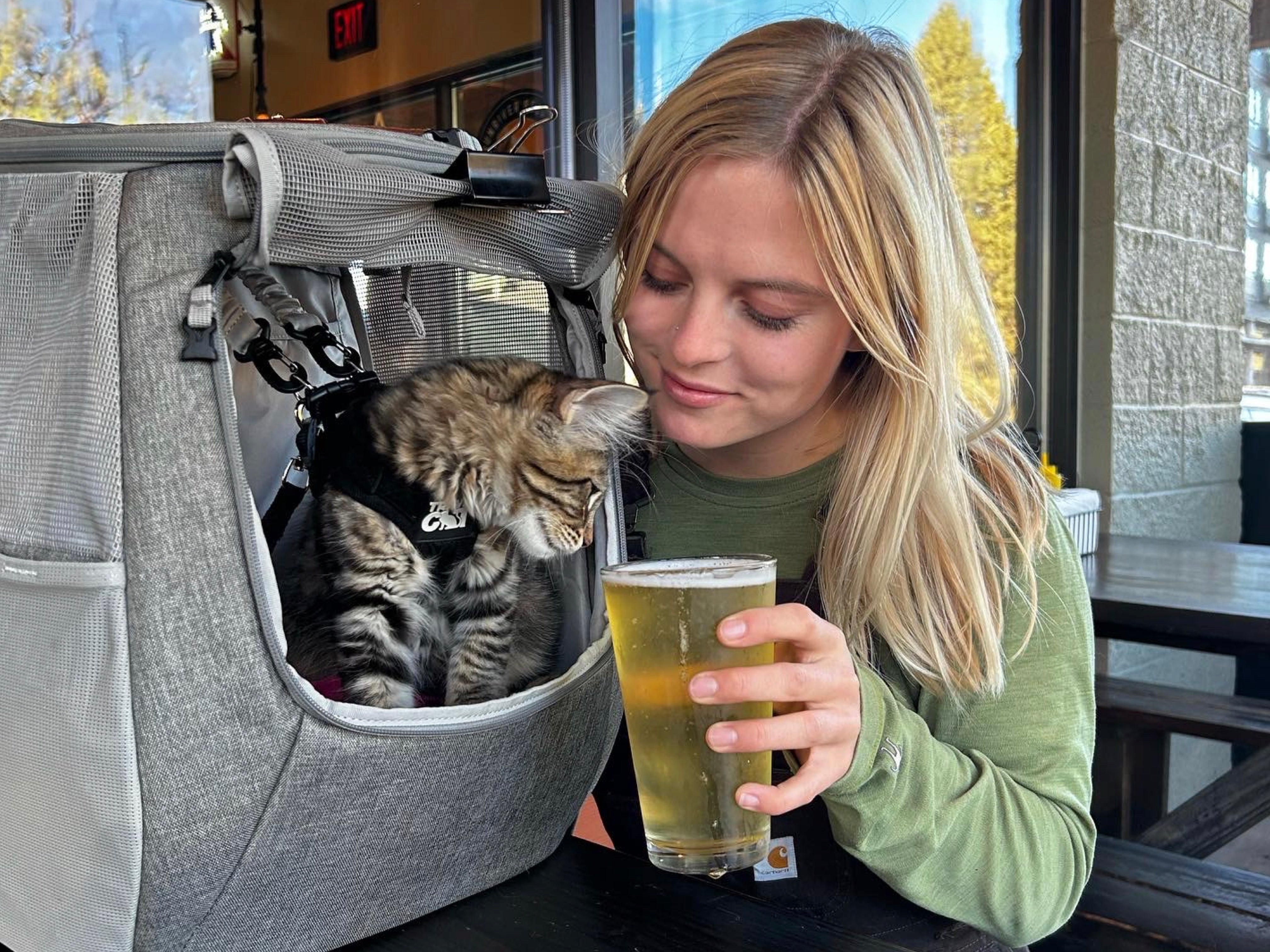
FUN PLACES TO TAKE YOUR CAT OUT

BACKPACK TRAINING ON-DEMAND
Your cart is empty

FREE U.S. SHIPPING ON ORDERS $89+
SHOP CUSTOMER FAVORITES

HARNESS STYLES FOR EVERY CAT

"The Odyssey" Soft Cat Carrier for Every Day and Air Travel

Cat Backpacks & Carriers

Harnesses & Leashes

Travel Supplies

Bandanas & Collars

"The Pathfinder" Cat Harness & Tractive GPS Device Bundle
3,000+ 5 star reviews.
"Plenty of air flow with the mesh sides and the bubble is hilarious. Never thought I'd be a crazy cat lady, but here I am killing it!"
"They love being in it, even when we aren't going on a walk. And it has held up very well against all their destruction attempts! Very happy!"
"We ABSOLUTELY LOVE IT...I promised my Little Girl daddy would NEVER leave her behind and now I DON'T have to. Thank you."
"We've been using the Fat Cat Backpack since this little booger was 10 weeks old, and he LOVES IT. He plays on and in it constantly."
"I took my Siamese cat out camping and this was absolutely perfect for transporting. It's a safe place for her to be while away from home."

Ultimate Calming Convertible Cat Carrier in Heather Grey
"THE TRANSPURRTER"
This cat carrier has it ALL. Designed with cat parent's convenience & kitty's safety as a top priority, this is the cat carrier that will go with you everywhere - plane, train, automobile, you name it.

COLLABS & PARTNERSHIPS

🚗 CAR & PLANE ✈️ TRAVEL SUPPLIES

CAT TRAVEL TIPS & RESOURCES

TIPS for Harness and Backpack TRAINING CATS at the Travel Cat Summit

How to Harness Train a Cat at the Travel Cat Summit

Train Your Cat to be a TRAILBLAZER | TIPS on Hiking and Water Sports at the Travel Cat Summit
CAT FUN & CUTENESS
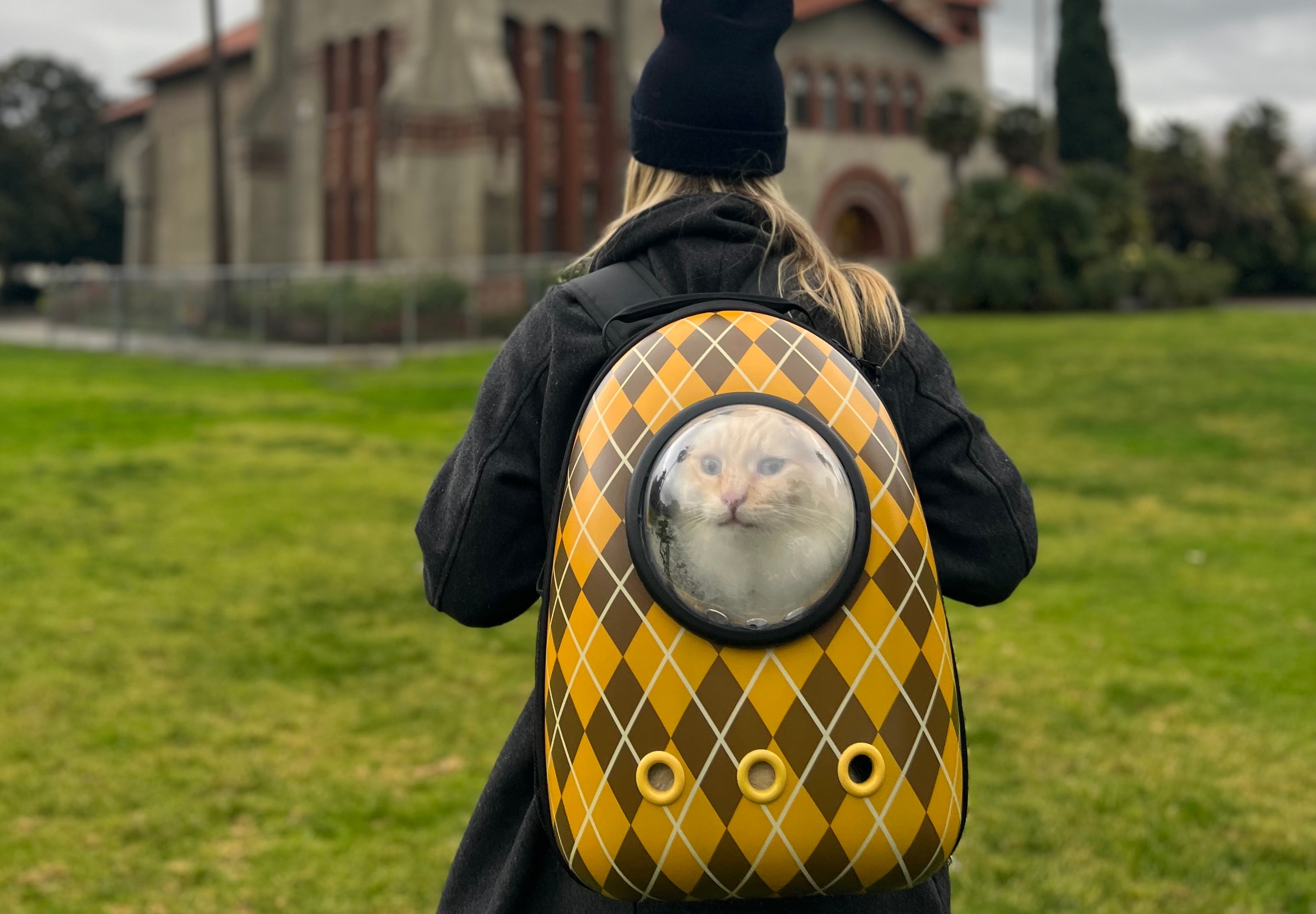
Argylle the Movie Meets Travel Cat

Feline Frenzy: 20+ of the Best Stores Across the World Devoted Exclusively to Cats & Cat Lovers
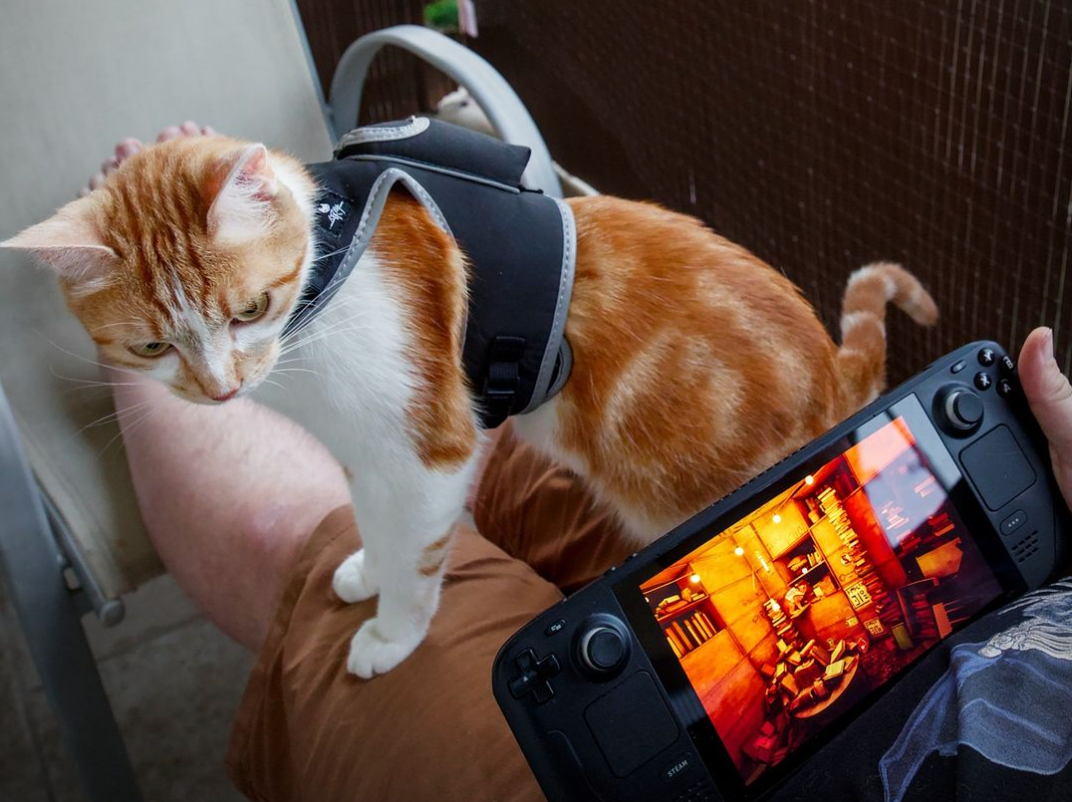
How to Kick Back and Relax With Your Cat
Description Toggle
Catway (Drone Cat) is a niche Midrange attacker with the Strong ability against Red, Black and Angel enemies. It has 1500 AoE DPS at 355 Range, 6200 HP with 3 KBs, a 7.9s Cooldown and 1200 cost. Against non-target traits it is a direct downgrade of Drama Cats, with less DPS and much worse HP for a higher cost and cooldown, making it not viable in general use. In particular, Drone's pitiful HP is not enough to keep a stack reliably alive in tricky stages. However, against Red, Black, and Angel its Strong-enhanced effective 2600 DPS and 15.5k HP make it a formidable, decently durable, and cost effective stackable attacker. Despite this, more dedicated specialists such as Pizza Cat against Black will often take care of these traits more effectively. Drone's ability to target multiple traits, at least, can still give it an advantage on stages like Pecking Order with a mixture of its target traits. It is also a member of the Research Up M combo Aerial Recon, which can be effective if you’re lacking better Research combos and bringing Drone anyway.
In True Form, Time Traveller Cat gains a more usable 10.6k HP (26.6k effective) and DPS of 2200 (3900 effective). Time Traveller is viable as a general attacker in midgame now, with durability on par with Drama and better DPS. In lategame, however, it falls behind again as Slapsticks becomes available with far superior general stats. Late game also presents stronger enemy threats which Time Traveller cannot keep up with, often even against his traits as they are paired with Curse-using Relics. Time Traveller is still therefore mainly used as AoE DPS solely against its traits where it comfortably outperforms generalists in its range class. A notable example is Aku Realms Mexico, where a stack of Time Travellers is a good way to cut through the spam of Gabriels.
To propose corrections to this description, please make your desired changes at GitHub and make a pull request (requires account).
Hypermax Priority Toggle
Combos toggle, xp cost curve toggle.

A time-traveling cat fantasy: Lloyd Alexander’s Time Cat
Figure 1: one of the cover designs for Time Cat
I’ve been threatening with a blog post about a time-traveling cat for a while now, so here it is! I’m giving you Lloyd Alexander’s children’s fantasy Time Cat: The Remarkable Journeys of Jason and Gareth , what we’d probably call a middle grade novel today, originally published in 1963, and very much still in print, though not as well-known in the UK as (I suspect) in the USA. This was an important book for Alexander’s career as a children’s fantasy author. It came before the Prydain books, and helped him find his voice and confidence to write for children. I got interested in this book while researching my latest monograph, Celtic Myth in Contemporary Children’s Fantasy , because of the way it paved the way for Prydain – but more on this below!
Time Cat is the story of a cat, Gareth, and his human, a boy named Jason. The “mythology” of this novel is that the human folk belief that cats have nine lives isn’t quite right. As Gareth explains:
“I only have one life. With a difference… I can visit nine different lives. Anywhere, any time, any country, any century.” (p. 3)
and Gareth justifies this in terms familiar to any cat owner:
“Where do you think cats go when you’re looking all over and can’t find them?… And have you ever noticed a cat suddenly appear in a room when you were sure the room was empty? Or disappear, and you can’t imagine where he went?” (p. 3)
And, as one would expect, Gareth and Jason depart on a time-travel journey to visit nine different historical moments all over the world, in a tour clearly curated by Gareth, as all the times and places they visit have a significance for feline-human relationships!
Figure 2: Bastet/Ubaste
The first place they visit is ancient Egypt, circa 2700 B.C., where cats are worshipped as part of the cult of Ubaste (or Bastet), who often appears iconographically as cat-headed. Ubaste’s symbols include the ankh, a hieroglyphic usually associated with word for “life”, which makes Gareth extra special – we learn right at the opening of the novel that Gareth is black, and that the only white spot on his chest is “a T-shaped mark with a loop over the crossbar” (p. 2), which is very clearly an ankh (see also Gareth as pictured in one of the book’s covers, Figure 1). Gareth and Jason are whisked away to King Neter-Khet, who has been looking for a special cat to please him. After some misunderstandings, they both end up teaching the king that “Not even a Pharaoh can give orders to a cat” (p. 21) – and rightly so!
Their next visit is to Rome and Britain, in 55 B.C. In Rome Gareth becomes the mascot of the “Old Cats Company” and with Jason and two Roman soldiers they sail to Gaul and from there to Britain. In the conflict between the Roman legions and the “shouting Britons” (p. 33) Gareth gets into a fight with a British wildcat and Jason is captured by a local tribe. They stay with them a while and after they educate the British to value, rather than fear, cats, the wild cat approaches the village with its kittens, one of which is clearly Gareth’s! This is the beginning of domesticated cats in Britain! (So an aetiological story, of sorts!)
Ireland in 411 A.D. is the setting of the next episode: Gareth and Jason meet Diahan, the daughter of a local king, and Sucat, the king’s herdsman. This is the episode mentioned in my book , because Sucat, a slave captured from Wales, and a Christian in a pagan land, is actually a young St Patrick!
Lloyd Alexander has originally planned a Welsh episode for this book, in which Jason and Gareth would meet St Patrick in his native Wales, before his kidnapping by Irish slave raiders. Alexander had been to Wales while serving in WWII and remembered it fondly. Also, while researching Time Cat , he had found out that St Patrick’s Welsh name meant “Good Cat” which tied up nicely with a feline-focused story. According to Alexander’s plan:
Jason and Gareth run across this young boy with a strange name, the future St. Patrick, of course. They meet him in Wales, probably in some spot where I had been myself. I can draw on my own sense of the country because I know it and am fond of it. What could be more natural than this?… They all get kidnapped by these Irishmen in a big dramatic scene… (cited in Jacobs, 1978, p. 264)
The “Welsh research” Alexander embarked upon to prepare this episode was somewhat overwhelming and brought back memories of his childhood reading and his own visit to Wales. As he noted in an interview:
something began stirring inside my head. Strange, personal stirrings began to happen to me. This was far too rich a thing to do in one chapter, so I changed my idea. Instead of having Jason and Gareth meet St. Patrick in Wales, they meet him in Ireland and it becomes an Irish episode. (Ibid., p. 265)
And, indeed, all of the rich Welsh legends Lloyd Alexander has suddenly remembered found their way into the Prydain books (more on which in my book ).
As for the name Sucat and its feline associations, in Time Cat St Patrick explains that:
“In Britain, they called me Patrick. But my real name is Sucat. It means ‘Good Cat’ – and it means ‘Good Warrior.’ For in my land, the land of Wales,” he added, “we call our warriors ‘Cats.’” (p. 53)
Figure 3: Margaret Cooper Gay’s How to Live with a Cat (first published in 1946)
“Succetus” is indeed recorded as one of St Patrick’s alternative names in Tírechán’s Collectanea (Account of St Patrick’s churches) from c. 670. The text itself translates what seems to be a British/Welsh name as “god of war” (see Dumville, 1993, p. 90). The somewhat fanciful translation of the name Patrick as “good cat” came from a book the name of which Alexander could no longer recall, but I’m now pretty sure it was Margaret Cooper Gay’s How to Live with a Cat (first published in 1946), in which she claims that St Patrick was originally “a Scottish monk named Su Cat” which may be translated as “Happy Warrior or the Good Cat” (Cooper Gay, 1969, p. 17). This example of Alexander repeating or adopting dubious research for “things Celtic” is something of a pattern that I’ve traced in detail in The Chronicles of Prydain in my book. [i]
Figure 4: Cat in kimono in modern Japan (click image for source and more pictures)
The Irish episode in Time Cat brings together St Patrick and his mission, the folk belief of Ireland overridden with snakes until St Patrick banishes them (there’s an excellent scene of Gareth fighting a snake), and an element of romance between Jason and Diahan. Diahan is actually very much a prototype for Eilonwy. She is feisty, strong-minded, has “red-gold hair tossed about her soldiers” (p. 49) and chastises Jason for being impolite, or talks to him only to tell him that she won’t talk to him – all staples of Eilonwy-Taran interactions in the Prydain books.
Next stop: Japan 998 A.D. during the reign of Emperor Ichigo, when cats were introduced to Japan from China. Gareth and Jason teach the boy-Emperor Ichigo not only that cats aren’t toys to be played with and admired (and that it’s definitely NOT appropriate to dress his kittens in tiny embroidered kimonos!) but also how to find his voice and strength and assert himself over his rather nasty uncle-regent.
The fifth life Gareth and Jason visit is that of another historical figure, but this is perhaps the best-known one in the book: Italy 1468 and a young Leonardo da Vinchi, who is yet to convince his father that he doesn’t want to be a notary (as per the family tradition) but an artist. And, of course, Gareth and Jason end up becoming the catalyst for this! Leonardo, who writes his name backwards on his bedroom room (Odranoel), ends up creating a painting of a hybrid cat creature so life-like, that his father sees at last his talent. The inspiration is Gareth’s magnificent movements and feline physique. While Leonard works on drafting his painting, we literally see him producing the famous “Study sheet with cats” (Figure 5), now in the Royal Collections:
Figure 5: Leonardo da Vinci, “Study sheet with cats, dragon and other animals” (click image to see larger version) The boy picked up a bit of charcoal and began sketching rapidly on the back of an old sheet of paper. “The thing about cats,” Leonardo said, working along until the paper was covered, “is the way they’re made. Those muscles in the back legs. Can you imagine how strong they must be? That’s why cats can jump so high. And the back, it can move almost any way, like a sword blade. “Everything is in balance,” Leonardo went on, “all the muscles and bones and joints. That’s what I want in the painting, too.” “Well, I hope you aren’t going to paint bones and muscles,” Jason said. “I don’t think anybody would like that.” “Of course I’m not going to paint just bones and muscles,” Leonardo said. “But I know where they are, even if nobody else sees them. And that’s bound to make the picture better.” (p. 112)
Next, Gareth and Jason move to 16th-century Peru (1555) and meet Diego Fernández, the man who soon after became the historian of Peru for the Viceroy (who ruled in the name of the King of Spain). Don Diego’s kind nature (clearly expressed by his fondness for cats) leads to an effort towards mutual understanding between the Incas and the Spanish conquistadors (I don’t know much at all about this era, but I wouldn’t be surprised at all if the story is a rather romanticised…)
Gareth and Jason next find themselves on the Isle of Mann in 1588, where they witness a cat (called Dulcinea) and her kittens arrive by sea in a barrel, having escaped a shipwreck. And, guess what? The cat is tailless, and therefore the originator of the famous Manx cats to come (so another aetiological story). Alexander is clearly here going with one of the popular beliefs about Manx cats: that they came from one of the ships of the Spanish Armada that sunk off the coast of the Isle of Man in 1588 (on exactly the date he chooses). There is no evidence for this and Manx cats, I understand, are now believed to be the product of a natural mutation that happened on the island (perhaps because of inbreeding). But the idea of the strange cat breed coming over the sea has its narrative uses, as Dulcinea, the kittens, Gareth, and Jason, now stick together and explore the island. The human story in this episode is about a young girl who thinks herself ugly because of her unusual eyes (one blue, one brown, like those of some cats, actually) who learns to appreciate that: “Beauty is inside, not on the face… If a person thinks he’s ugly, why then he begins to act in an ugly, cruel way” (pp. 152-3). Dulcinea and her kittens stay in the Isle of Man and become ship-cats, while Gareth and Jason move on to their next adventure.
Figure 6: one of the cover designs for Time Cat
This next episode is set in Germany in 1600, where things start feeling darker. Gareth and Jason find themselves in the midst of the witch-hunts of Early Modern Europe, when cats were equally persecuted as witches’ familiars, or demonic creatures. They manage to save an innocent woman who is falsely accused for witchcraft, but the end of this story doesn’t feel as neat and comfortable as previous ones. It looks like Jason is gradually coming to terms with more difficult moral questions, with Gareth as a wise guide.
And this emphasis on growing up and learning about things that may be more complex and less black-and-white continues in last episode, set in America in 1775, just as the American War of Independence is about to break out. Gareth and Jason meet a peddler-cum-teacher-cum-inventor who travels around Massachusetts selling “nature’s finest mousetraps”, i.e. kittens, while at the same time passes on messages to and from the Sons of Liberty and facilitates the forthcoming War of Independence. As Professor Parker aptly says: “countries are like cats. They like to settle down in their own ways. But they want their freedom, too. They’ll fight for it if they have to.” (p. 193).
The ending of this story is, again, a melancholy one, and the book then ends very quickly after that, with Jason back in his own home in the 20th century (I guess they’re in the USA anyway so this is only a travel in time, not time and place at the same time) and Gareth giving a rather didactic speech about everything Jason has learned in their time-traveling journey: how to grow up. (That’s the sort of thing modern children’s literature takes great pains to avoid announcing, but it remains a perennial theme, perhaps for inevitable reasons).
The novel includes some brilliant observations of cat appearance and behaviour – see, for example, the lovely opening of the novel:
Gareth was a black cat with orange eyes. Sometimes, when he hunched his shoulders and put down his ears, he looked like an owl. When he stretched, he looked like a trickle of oil or a pair of black silk pajamas. When he sat on a window ledge, his eyes half-shut and his tail curled around him, he looked like a secret. (p. 1)
Figure 7: one of the cover designs for Time Cat
There are numerous such scenes, like the demonstration of Gareth’s hunting “moves” in the Rome/Britain episode (again, beautifully observed and really well-rendered), and various moments of Gareth expressing affection by purring, and rubbing his head and tail against ankles.
There are also a number of “proverbial” phrases of feline nature, most of the time pronounced by Gareth, but also by Jason who really does know his cat! For example:
(Jason:) “A cat can belong to you, but you can’t own him. There’s a difference.” (p. 20) (Gareth:) “I enjoy a comfortable bed… but if there isn’t one around, it doesn’t matter. Any bed is soft to a cat.” (p. 28) (Gareth:) “The only thing a cat worries about is what’s happening right now. As we tell the kittens, you can only wash one paw at a time.” (p. 125) (Gareth:) “It takes patience. But that’s one thing cats have a lot of. Why, even a kitten knows if you wait long enough someone’s bound to open the door.” (p. 184)
And, at the same time, Alexander finds really apt moments to point to parallels between how people behave to cats and much larger themes such as power, faith and spirituality, self-belief and confidence, and duty and freedom.
I hope more people will discover this book. It doesn’t only fall within the sub-category of time-travel children’s fantasy, but also fits with some aspects of animal fantasy. And, as one would expect, there was a real cat which gave Alexander the inspiration for the adventures of Gareth and Jason: his cat (one of many), Solomon, who was good at appearing and disappearing as if by magic.
Let me close with Jason’s words to Gareth, which feel like an appropriate ending to this post:
“In Egypt they thought you were a god. Here [Germany during the witch-hunts] they think you’re a demon. Won’t anyone ever understand you’re a cat?”
Figure 8: one of the cover designs for Time Cat
[i] There are a number of issues in Alexander’s portrayal of “Celtic” Britain and Ireland in Time Cat too, but that deserves an entire blog post in and of itself. I might write it one day, and I might call it “Of Celts and Cats”!
Alexander , Lloyd. Time Cat: The Remarkable Journeys of Jason and Gareth . New York: Puffin Books, 1996 [1963].
Cooper Gay, Margaret. How to Live with a Cat . [S.l.]: Simon & Schuster, 1969[1946].
Dumville, David N. Saint Patrick A.D. 493–1993 . Woodbridge: Boydell Press, 1993.
Jacobs, James S. “Lloyd Alexander : A Critical Biography.” EdD diss., University of Georgia, 1978.
- ← Demiurgic Beings: A Platonic word in Tolkien
- TLS review of Dome Karukoski biopic “Tolkien” →
Leave a Reply Cancel reply
Your email address will not be published. Required fields are marked *
Save my name, email, and website in this browser for the next time I comment.

Download the free Kindle app and start reading Kindle books instantly on your smartphone, tablet, or computer - no Kindle device required .
Read instantly on your browser with Kindle for Web.
Using your mobile phone camera - scan the code below and download the Kindle app.

Image Unavailable

- To view this video download Flash Player
Follow the author

The Time-Travelling Cat and the Egyptian Goddess (Time-Travelling Cat series) Paperback – September 1, 2007
- Reading age 9 - 12 years
- Part of series Time-Travelling Cat
- Print length 128 pages
- Language English
- Grade level 4 - 7
- Dimensions 5 x 0.5 x 7.75 inches
- Publisher Andersen Press
- Publication date September 1, 2007
- ISBN-10 1842705210
- ISBN-13 978-1842705216
- See all details

Popular titles by this author

Editorial Reviews
About the author, product details.
- Publisher : Andersen Press; New edition (September 1, 2007)
- Language : English
- Paperback : 128 pages
- ISBN-10 : 1842705210
- ISBN-13 : 978-1842705216
- Reading age : 9 - 12 years
- Grade level : 4 - 7
- Item Weight : 2.4 ounces
- Dimensions : 5 x 0.5 x 7.75 inches
- #478 in General Egypt Travel Guides
- #7,249 in Children's Cat Books (Books)
- #37,891 in Children's Fantasy & Magic Books
About the author
Julia jarman.
Born talking - well, that's what my mum says - I was soon telling stories and never stopped. For the last forty years I have been a writer of books for children. The stories I wrote were always for and about the children in my life, my son and two daughters, my grandchildren and young readers in schools and libraries, which I loved visiting.
That was fine till lock-down when suddenly life became a bit less fun.
I live alone and with no one to talk to, except my cat, it felt a bit lonely. But there was a plus. I picked up a novel I’d started writing when my husband died several years ago - and I finished it. I’m thrilled to say that THE WIDOWS' WINE CLUB, was published by Boldwood Books in August 2023, and the reviews have been great. Do take a look.
Lots of readers are enjoying the company of my three widows, sweary Viv, straight-laced Janet, and glamorous Zelda, who are unlikely friends till they bond over a bottle of wine, shared experience and a determination to enjoy life. I’m delighted to say that the sequel, WIDOWS ON THE WINE PATH, is coming out in April 2024, and there’s another one on the way, tentatively called WIDOWS WAIVE THE RULES. They’re off on a cruise. I feel a series coming on!
I am still writing for children and a new picture-book CHEEKY CHICK will be published by Boxer Books in January 2024. Lots more picture- books, including BIG RED BATH and CLASS TWO AT THE ZOO, are available from Amazon, as are five titles in my TIME TRAVELLING CAT series where Topher and Ka the time-travelling cat explore life in Egyptian, Roman, Aztec, Tudor, Viking and Victorian times. You’ll also find HANGMAN a novel for teenagers, based on real life, posing the question: What do you do when you know someone is being bullied? - and several more ‘chapter books’.
I write to entertain and to empower. That’s true of my stories for children and adults. I agree with Dr Samuel Johnson who said, ‘The only end of writing is to enable readers better to enjoy life - or endure it.’ Is that Dr J’s way of recommending ‘feel-good fiction’? I hope so because that’s what I write!
I love most aspects of writing, even the stuck-at-homeness. I love my house and garden and my cat. But I am perhaps more extrovert than most writers, so I love being invited to talk about my work. I’ll travel far and wide to meet readers so please invite me if you’d like to know more about me and my books. Or talk to me on Zoom.
Or virtually visit me on my website.
Customer reviews
Customer Reviews, including Product Star Ratings help customers to learn more about the product and decide whether it is the right product for them.
To calculate the overall star rating and percentage breakdown by star, we don’t use a simple average. Instead, our system considers things like how recent a review is and if the reviewer bought the item on Amazon. It also analyzed reviews to verify trustworthiness.
- Sort reviews by Top reviews Most recent Top reviews
Top reviews from the United States
There was a problem filtering reviews right now. please try again later..
Top reviews from other countries
- Amazon Newsletter
- About Amazon
- Accessibility
- Sustainability
- Press Center
- Investor Relations
- Amazon Devices
- Amazon Science
- Sell on Amazon
- Sell apps on Amazon
- Supply to Amazon
- Protect & Build Your Brand
- Become an Affiliate
- Become a Delivery Driver
- Start a Package Delivery Business
- Advertise Your Products
- Self-Publish with Us
- Become an Amazon Hub Partner
- › See More Ways to Make Money
- Amazon Visa
- Amazon Store Card
- Amazon Secured Card
- Amazon Business Card
- Shop with Points
- Credit Card Marketplace
- Reload Your Balance
- Amazon Currency Converter
- Your Account
- Your Orders
- Shipping Rates & Policies
- Amazon Prime
- Returns & Replacements
- Manage Your Content and Devices
- Recalls and Product Safety Alerts
- Conditions of Use
- Privacy Notice
- Consumer Health Data Privacy Disclosure
- Your Ads Privacy Choices
Time travel, hyperspace and Cheshire Cats
- Open access
- Published: 01 June 2017
- Volume 195 , pages 5037–5058, ( 2018 )
Cite this article
You have full access to this open access article

- Alasdair Richmond ORCID: orcid.org/0000-0002-9480-4370 1
4968 Accesses
4 Altmetric
Explore all metrics
H. G. Wells’ Time Traveller inhabits uniform Newtonian time. Where relativistic/quantum travelers into the past follow spacetime curvatures, past-bound Wellsians must reverse their direction of travel relative to absolute time. William Grey and Robin Le Poidevin claim reversing Wellsians must overlap with themselves or fade away piecemeal like the Cheshire Cat. Self-overlap is physically impossible but ‘Cheshire Cat’ fades destroy Wellsians’ causal continuity and breed bizarre fusions of traveler-stages with opposed time-directions. However, Wellsians who rotate in higher-dimensional space can reverse temporal direction without self-overlap, Cheshire Cats or mereological monstrosities. Alas, hyper-rotation in Newtonian space poses dynamic and biological problems, (e.g. gravitational/electrostatic singularities and catastrophic blood-loss). Controllable and survivable Wellsian travel needs topologically-variable spaces. Newtonian space, not Newtonian time, is Wellsians’ real enemy.
Similar content being viewed by others
Time travel and coincidence-free local dynamical theories.

Hegel’s Theory of Space-Time (No, Not That Space-Time)
Timelines and quantum time operators.
Avoid common mistakes on your manuscript.
1 Introduction
Physical travelers into the past must be Gödelians or Wellsians . The former follow spacetime curvatures; the latter reverse temporal direction relative to absolute time. Footnote 1 Newtonian and relativistic physics seemingly forbid Gödelians and Wellsians respectively. Can absolute time admit backward time travel or is curved spacetime required? Grey ( 1999 ), Le Poidevin ( 2005 ) claim reversing extended Wellsians must overlap with themselves or fade away piecemeal like the Cheshire Cat. Either way, traveler-continuity fails and Wellsian reversals are physically impossible.
However, Wellsians have options besides self-overlap or fades, which reveal surprising links between time travel, spatial topology and biology. Pace Grey ( 1999 ), Le Poidevin ( 2005 ), absolute-time travel is possible if space is sufficiently accommodating. Wellsians can reverse without discontinuity or overlap if they rotate in higher-dimensional space. However, rotation in Newtonian hyperspace is neither (humanly) controllable nor survivable. Controllable, survivable Wellsian travel requires dynamic, variable-topology spaces. Wellsian time can be Newtonian, absolute and uniform; Wellsian space cannot. Wellsian travel requires that space itself be plastic.
2 Lewisian time travel
Time travel has been variously defined but David Lewis ( 1976 : p. 145) defined it best:
Inevitably, it involves discrepancy between time and time. Any traveler departs and then arrives at his destination; the time elapsed from departure to arrival (positive, or perhaps zero) is the duration of the journey. But if he is a time traveler, the separation in time between departure and arrival does not equal the duration of the journey.
Discrepancies separate external and personal time. External time is time in a suitably-inclusive reference frame. (E.g. a galaxy’s center of mass.) Personal time is traveler-time, not a “further temporal dimension, but rather the way in which time is registered by a given object: a heart beating, hair growing, a minute hand moving, a candle burning”, (Le Poidevin 2005 : p. 339). Travelers’ memories, watches, digestion, (etc.) register personal time but none individually constitutes it. (Watch malfunctions or hibernation are not time travel.) Time travel affects everything in travelers’ reference frames.
Following Lewis ( 1976 ), traveler identity and personal time require correct causal continuity between traveler-stages, and dissolve if inter-stage continuity fails. Whatever their relations to external time, genuine travelers are personal continuants:
For time travel requires personal identity—he who arrives must be the same person who departed. That requires causal continuity, in which causation runs from earlier to later stages in the order of personal time (Lewis 1976 : p. 148).
If the usual causal connections underlying traveler-identity and personal time fail en route , the process isn’t travel. Stages of genuine travelers are not joined merely by (e.g.) coincidental likenesses, spatiotemporal proximity or accidentally-shared purposes, howsoever close. Footnote 2 Inter-stage qualitative similarity alone cannot make just any stage-aggregate into a traveler if correct inter-stage causal links are lacking:
... What unites the stages (or segments) of a time traveler is the same sort of mental, or mostly mental, continuity and connectedness that unites anyone else. The only difference is that whereas a common person is connected and continuous with respect to external time, the time traveler is connected and continuous only with respect to his own personal time ( Ibid. ).
Furthermore, if travelers are normal concrete things, their constitutive links should be spatiotemporally local. Any process that requires spatiotemporally discontinuous inter-stage links arguably does not involve bona fide travel. This papers argues that extended Wellsians cannot maintain correct inter-stage causal links (and hence personal time) unless space has extra dimensions or (preferably) variable structure.
3 Gödelians and Wellsians
Wells ( 1895 ) has a thoroughly Newtonian background. Newtonian space and time are mutually independent, eternal substances. Newtonian time is absolute and uniform—passing everywhere in the same direction, at the same rate. Newtonian worlds as a whole possess unambiguous time functions and absolute simultaneity, i.e. have a universal ‘now’. In relativity, space and time are not independent existents but twin aspects of spacetime. General relativity predicts matter’s presence affects spacetime itself and allows time (in effect) to ‘curve’. Gödel ( 1949 ) describes spacetimes so curved as to allow ‘closed timelike curves’ (CTCs): journeys that are always (locally) future-directed yet eventually rendezvous with their own spatiotemporal starting points. Parts of Gödel universes (e.g. galaxies) can have well-defined time-functions but Gödel universes in toto cannot: they have no universal ‘now’. (Simultaneity relations cannot be defined for their entirety.) Gödel universes neither begin nor end but simply are : infinite, four-dimensional blocks with strange geometrical ‘twists’ that let travelers visit any (externally) earlier or later times. Wellsians take peculiar journeys in otherwise conventional universes; Gödelians are otherwise conventional travelers in strangely-structured spacetimes. Wellsians actively go against time’s local flow; Gödelians passively follow time’s local direction. (Wellsians resemble helicopters in a uniform breeze; Gödelians, balloons in a cyclone.) In effect, Gödelians merely persist in idiosyncratic directions. Gödelians thus don’t much resemble time travelers in fiction, who can generally go anywhere in history. Indeed, some (notably Le Poidevin 2005 ) think Gödelians’ relative lack of room for maneuver means they cannot genuinely time-travel. If so, problems for Wellsians doom physical time travel.
Newtonian worlds are temporally well-behaved. Gödel ( 1949 ) universes have CTCs through every point. CTCs have well-defined past and future directions locally (in the traveler’s vicinity) but not globally (viewed as a whole). Gödelians can re-encounter their own pasts by traveling into their local future. Past and future are only relatively distinct on CTCs, rather as ‘up’ and ‘down’ are not absolute distinctions but relative to the Earth’s center. (Similarly, clock-faces have well-defined clockwise and anti-clockwise directions at every point yet a sufficiently prolonged clockwise journey revisits its starting point.) Reversing direction against external time gives Wellsian travel clear start- and end-points. Such reversals present the problems which are the main focus here. Starts and finishes for Gödelian travel are less clear, as temporal oddities show up only for the whole journey: “In Gödel’s space-time the local temporal and causal order will not differ from the one we are familiar with in our world; deviations can only occur for global distances”, (Pfarr 1981 : p. 1090, emphasis original).
Wells ( 1895 ) features no processes recognized by relativity. Relativistic time travel (time dilation or CTCs) requires movement and/or gravitational differences between personal and external reference frames. However, Wells’ ( 1895 ) Traveller sits at rest (relative to the Earth) with his personal time varying in direction and/or rate of travel relative to all surrounding objects. Everything outside Wells’ ( 1895 ) machine registers one external time, while the machine enjoys a unique personal time without motion or gravitational differences relative to its surroundings. During backward time-travel, Wells’ ( 1895 ) Traveller sees everything outside the Machine seemingly go into reverse. Unlike Wellsians, Gödelians see no apparent failures of entropy (or other temporal anomalies) in their immediate extra-vehicular surroundings. Wellsian travel requires locally and globally backward causation; Gödel travel requires only the latter.
Below are depicted one Gödelian and seven Wellsians in various one-dimensional and two-dimensional spaces, (‘Linelands’ and ‘Flatlands’ respectively). Footnote 3 All illustrations have one time-dimension. Footnote 4 \(\hbox {Wellsian}_\mathrm{(a)}\) is an unextended (point-like) object which reverses temporal direction twice (first at \(\upphi \) and then at \(\upomega \) ) but otherwise persists normally (Fig. 1 ).
Gödelian and Wellsian
External time increases and personal time decreases \(\upomega \) -to- \(\upphi \) . Each personal moment holds one Wellsian. Each external moment \(\upomega \) -to- \(\upphi \) (e.g. m 1) holds three Wellsians, the midmost growing younger as external time increases. Viewed externally, two Wellsians seem to converge on \(\upphi \) and disappear, while two seemingly appear ex nihilo at \(\upomega \) and diverge. If these phases form parts of one history, physical continuity (and personal time) must survive \(\upphi \) and \(\upomega \) —otherwise, they are three separate objects and not one continuant. Wellsian round-trips require both \(\upphi \) -style and \(\upomega \) -style reversals. Wells’ ( 1895 ) Traveller departs from/returns to external times around 10 am and 7.30 pm respectively on one day early in 1894. Meantime, he spends eight personal days visiting 802,701 AD and then c. thirty million AD. He presumably reverses \(\upphi \) -style leaving the future and then \(\upomega \) -style re-entering 1894. Footnote 5
Wellsian reversals seem temporally peculiar but spatially benign—at least for unextended objects. However, extended Wellsians risk overlapping later and earlier selves. What Grey ( 1999 : pp. 60–61) baptizes double occupancy looms pre- \(\upphi \) and post- \(\upomega \) , with “not one but two machines—one going backwards and the other forwards—each apparently occupying (or attempting to occupy) the same location”. Wellsians face identical difficulties at \(\upphi \) -style ‘apex-instants’ or \(\upomega \) -style ‘nadir-instants’—it’s changing direction that poses problems. Can extended concrete objects make such transitions?
Dowe ( 2000 : p. 446) suggests reversing Wellsians avoid self-overlap if they also move in space: “To do this sort of time travel you have to take a run up”. Passers-by might see a departing Wellsian machine “moving across a field, and ... its reversed later self moving towards it ( perhaps an antimatter time machine, perhaps not )”, until “the two collide, apparently annihilating both”, ( ibid. , emphasis added). However, as Le Poidevin ( 2005 : p. 344) shows and Fig. 2 illustrates, movement during reversal still leaves some overlap inevitable. (At least movement at finite velocity. Infinite velocity, even if coherent, threatens discontinuous existence or multiple overlapping stages.) Moving is not enough.
Double occupancy
Stationary \(\hbox {Wellsian}_\mathrm{(b)}\) reverses once at \(t_{2}\) so two copies overlap completely at every moment shown. Co-occupancy is more localized and transitory for moving \(\hbox {Wellsian}_\mathrm{(c)}\) . The leading and trailing edges of \(\hbox {Wellsian}_\mathrm{(c)}\) are ‘B’ and ‘A’ respectively. In external time, two of \(\hbox {Wellsian}_\mathrm{(c)}\) first meet at \(t_{1}\) , when the forward phase’s edge B meets the backward phase’s edge A. These two \(\hbox {Wellsians}_\mathrm{(c)}\) then progressively overlap until they coincide at \(t_{2}\) and vanish thereafter. \(\hbox {Wellsians}_\mathrm{(b, c)}\) are extended objects which multiply occupy the same spaces for extended periods. If one Wellsian can’t exclude another from its space \(t_{1}-t_{2}\) , is it still concrete at such times? Genuine solutions to double occupancy must at least let Wellsians behave like concrete objects that have continuous histories.
Time travelers who are Gödelian, unextended or spatiotemporally discontinuous all evade double occupancy. Likewise, diverse tropes, universals, fields or sortals Footnote 6 can co-occupy. However, “two [concrete] objects of the same kind (persons, chairs, iron spheres)”, (Le Poidevin 2005 : pp. 336–337) cannot co-occupy. Napoleon and his dress-sense can co-occupy but Napoleon and Wellington cannot, and nor can two Napoleons.
Interestingly, Le Poidevin ( 2005 : p. 350) thinks backward time travel should be something travelers do (or initiate), and should proceed against time’s global direction:
It is, I think, a moot point whether simply following a closed time-like curve in worlds where there is no global earlier-later direction constitutes genuine time-travel. Arguably, time travel is something that, as we might put it, goes against the grain of space-time, rather than simply following it.
If Gödelians are mere slaves of curved spacetimes (with no global time direction to buck), only Wellsians could truly time-travel. (For similar sentiments, see Torretti 1999 : p. 79, n. 20.) Even Gödel thought Gödelians weren’t strictly time travelers. He thought the possibility of CTCs proved that dynamic time has no objective analogue, therefore our temporal experience tracks only an ‘ideal’ (apparent or non-objective) time and relativity’s ‘t’ co-ordinate is not truly timelike. (See Yourgrau 1999 ). Hence a dilemma: without global time, Gödelians can’t time-travel; Wellsians could ( per impossibile ) time-travel but spatial problems (e.g. co-occupancy) foil them.
But must time travel be Wellsian? Lewis’s ( 1976 ) necessary and sufficient condition for time travel, i.e. discrepancy between external and personal time- registers , covers Wellsian and Gödelian alike. Lewis ( 1976 ) defines time travel by outcomes, not topologies or methods, and leaves unspecified how discrepancies arise. Pace Gödel, suppose a wormhole takes your (apparent) personal history from 2045 to execution for witchcraft in 1645. If so, being told you hadn’t really time-traveled (and/or time is ideal) seems cold comfort. However, Le Poidevin ( 2005 ) raises relevant issues even if Gödelians truly time-travel. Gödel universes may lack universal times but other relativistic models permit them. Footnote 7 If future physics restores global times, only Wellsian travel remains. Sections 1 – 3 surveyed Lewisian time travel, Gödelian/Wellsian differences and double occupancy. Next, Sect. 4 differentiates double occupancy from bilocation and persistence problems. Sections 5 – 11 outline and refine candidate answers to double occupancy.
4 Two things double occupancy is not
(1) Bilocation bilocated time-travelers occupy two distinct places at the same external time and look like two different people, with different personal ages. Bilocation arises if (e.g.) a traveler meets her earlier self. However, double-occupying objects multiply occupy the same place at the same external time. Wellsians or Gödelians can bilocate but only Wellsians double-occupy. Spatially stationary Wellsians co-occupy without bilocation. Time travelers who meet but don’t overlap with themselves bilocate without co-occupancy. \(\hbox {Wellsian}_\mathrm{(b)}\) only co-occupies; \(\hbox {Wellsian}_\mathrm{(c)}\) co-occupies and bilocates.
(2) A persistence problem the two chief philosophies of persistence, endurantism and perdurantism, characterize co-occupancy differently but neither evades it, (cf. Le Poidevin 2005 : pp. 337–338). For endurantists, persisting objects are wholly present at a time; for perdurantists, objects extend across time. Endurantism implies Wellsians must wholly and simultaneously occupy the same space more than once. Perdurantism implies distinct temporal parts of Wellsians must co-occupy. Either way, each temporal part (or version) is a spatially-extended concretum with its own associated mass and shape.
Note Wellsians’ spatial problems are not truly solved by letting Wellsians (e.g.):
exist discontinuously in space or time,
become impalpable, abstract or ghostly,
have identity-conditions supervening on non-causal facts,
utilize some form of (quasi-Newtonian or quantum) nonlocality,
have different haecceities for forward- and backward-travelling phases,
lack well-defined spatial relations with other simultaneously-existing objects,
bear different (temporal parts of) instantiation relations to identical regions etc.
All such exotica seem ad hoc . Worse, they simply grant (Grey 1999 ; Le Poidevin 2005 ) that reversing Wellsians can’t behave like classical concrete objects. Wellsians’ problems are spatial and only spatial solutions appear herein. To summarize the problem:
At most one (stage or version of a) concrete object of a given kind can occupy an extended spatial region at a time.
Reversing Wellsians change temporal direction relative to their surroundings.
Wellsians are spatiotemporally-continuous extended concrete objects.
Following sections aim to show that these attributes are jointly achievable but that no proper solution to Wellsian problems has appeared hitherto. Sections 5 – 6 criticize previous solutions. Sections 7 – 9 explore new, if unsuccessful, solutions. Adapting Sect. 8 ‘hyperspace’ model, Sects. 10 , 11 propose a true solution involving altering space itself.
5 Wells on double occupancy
Wells himself variously considered co-occupancy—albeit between travelers and other objects, and not between different stages/versions of travelers. Wells ( 1895 ) compares time travelers whizzing through history at different ‘speeds’ to objects crossing space at differing speeds (see Le Poidevin 2005 : pp. 338–340). Wellsians who traverse (e.g.) 50 external seconds per personal second travel 50 times ‘faster’ and make 1/50th of their ‘stationary’ impression compared to normally-persisting objects, just as bullets make attenuated visual impressions to observers they pass. However, stationary observers see past speeding bullets and not through them, i.e. derive visual impressions primarily from whichever background the passing bullets briefly obscure. An observer who co-moves with a bullet should see it obscure its background just like any other object. Similarly, anybody shot will find high velocity exacerbates bullets’ impact rather than diminishes it. Why should perceptual attenuation make objects less present at places they occupy? Physical presence is the problem, not perception of it.
Wells’ ( 1894 ) serial version of The Time Machine at least treats co-occupancy physically as well as perceptually. Once Wells’ ( 1894 ) ‘Philosophical Inventor’ has described traveling to and from A.D. 12,203, one of his auditors asks why no future people noticed him while he occupied the same (relative) place for millennia. At first, the Inventor waxes analogical in reply, invoking perception like his ( 1895 ) successor:
Suppose, for instance, you put some red pigment on a sheet of paper, it excites a certain visual sensation, does it not? Now halve the amount of pigment, the sensation diminishes. Halve it again, the impression of red is still weaker. Continue the process. Clearly there will always be some pigment left, but a time will speedily arrive when the eye will refuse to follow the dilution, when the stimulus will be insufficient to excite the sensation of red. The presentation of red pigment to the senses is then said to be “below the threshold.” Similarly my rapid passage through time, traversing a day in a minute fraction of a second, diluted the stimulus I offered to the perception of these excellent people of futurity ... (Geduld 1987 : p. 159)
Note Wells’ ( 1894 ) Inventor glosses machine ‘speed’ using personal/external time: in ‘rapid passage’, fractional personal seconds encompass external days. Conceding the perceptual point (maybe prematurely), the questioner then raises physical co-occupancy:
I suppose while you were slipping thus invisibly through the ages, people walked about in the space you occupied. They may have pulled down your house about your head and built a brick wall in your substance. And yet, you know, it is generally believed that two bodies cannot occupy the same space (Geduld 1987 : p. 159).
Here, the Philosophical Inventor replies with a non sequitur about molecular diffusion:
Don’t you know that every body, solid, liquid, or gaseous, is made up of molecules with empty spaces between them? That leaves plenty of room to slip through a brick wall, if you only have momentum enough. A slight rise of temperature would be all one would notice and of course if the wall lasted too long and the warmth became uncomfortable one could shift the apparatus a little in space and get out of the inconvenience ( Ibid. ).
But varying personal/external time shouldn’t mitigate spatial co-occupancy. Why can’t any solids interpenetrate given sufficient relative momentum? Anyway, gas-molecules slipping through membranes move relative to whatever they permeate; Wells’ machines hold stationary relative to any co-occupied objects. Interpenetration is nothing to the purpose: gaseous diffusion never involves multiple extended concreta simultaneously occupying numerically the same space. (Anyway, as Wells’ 1894/95 travelers can see external events, neither is really impalpable while traveling.) While Wells’ attempts fail, other options have been proposed. Section 6 surveys Le Poidevin’s ( 2005 ) suggestions, whereby reversing Wellsians perforce disintegrate (and re-integrate) en route . While Le Poidevin ( 2005 ) is clear that such solutions themselves fail, his critique is instructive.
6 Cheshire Cats and chimeras
Le Poidevin ( 2005 : p. 345 ff.) suggests Wellsians can avoid self-overlap by departing ‘Cheshire Cat’ fashion, each part having a separate departure-time. \(\hbox {Wellsian}_\mathrm{(d)}\) departs piecemeal: edge B leaves at \(t_{1}\) and edge A at \(t_{2}\) . Self-overlap is avoided because each part reverses at a different apex-instant. However, the need to maintain continuity makes travelers’ forward and backward phases peculiarly contiguous. Henceforth fusions of contiguous temporally-opposed masses are ‘chimeras’ and two-headed chimeras ‘Pushmi-Pullyus’. Footnote 8 Above right, a reversing astronaut’s two phases meet toe-to-toe at \(t_{1}\) and fuse without overlap. Nearing \(t_{2}\) , our astronaut’s remains have dwindled to two contiguous copies of a scalp. This twin-scalped chimera diminishes until vanishing at \(t_{2}\) (Fig. 3 ).
Cheshire Cat
Chimeras and Pushmi-Pullyus can last arbitrarily long, depending on their parent phases’ size and velocity. Traveler-orientation determines chimeras’ shape. (Their phases needn’t be mirror-images, e.g. if travelers rotate while reversing.) Head-first travelers vanish feet-last, their headless chimeras “too horrible to contemplate”, (Le Poidevin 2005 : p. 346). A four-limbed, back-first, traveler yields four chimeras—one per limb. Whither the traveler in this four-way fission? That traveler identity could supervene purely on said traveler’s scalp seems implausible but still more so is a traveler surviving for unspecified periods as four spatially-disjoint objects, (none of them containing a brain). Can physical travelers who lack brains have psychological states?
\(\hbox {Wellsian}_\mathrm{(c)}\) departs in one piece at \(t_{2}\) . \(\hbox {Wellsian}_\mathrm{(d)}\) has no clear departure-time: its front (B) reverses at \(t_{1}\) and its back (A) at \(t_{2}\) . \(\hbox {Wellsian}_\mathrm{(d)}\) is all gone by \(t_{2}\) but \(t_{2}\) isn’t the departure-time. Continuity and identity fail if Wellsians and their spatial parts cannot attend all external times in their careers: “How can something continue to exist if there are (external) times when only a spatial part of it does so?”, (Le Poidevin 2005 : p. 345). Cheshire Cat fades destroy travelers and are not mere interludes in their careers. ‘Cheshire Cat’ solutions must let all a Wellsian’s spatial parts visit all times in its career and retain normal causal powers. Travel shouldn’t oblige travelers to shed themselves.
Co-occupancy, Cheshire Cats and chimeras all imperil personal time. For the Janus-like Pushmi-Pullyu at \(t_{1}\) , \(t_{2}\) is in its left head’s personal future but its right head’s personal past—it also registers \(t_{1}\) twice in experience (once per head) and once in memory (right head only). However, if Cheshire Cats destroy traveler-identity, personal time fails for Pushmi-Pullyus and memories don’t survive head-to-head.
Chimeras have problematic personal time even if causal links survive Cheshire Cat fades. Figure 4 left-hand traveler is pushed rightward at \(t_{1}\) . All its personally subsequent stages are displaced rightward, whether externally later or earlier. Figure 4 right-hand traveler is pushed leftward at \(t_{1}\) . This push affects only externally-earlier stages with \(t_{1}\) twice in their personal past. Leftward pushing has direct effects externally later and earlier; rightward pushing has direct effects only externally earlier. When the leftmost traveler revisits \(t_{1}\) , where it re-intersects \(t_{1}\) is largely determined by influences exerted at that very (external) time. Even if causal continuity survives reversal, chimeras allow effectively instantaneous causal transmission along a timeslice and hence their inter-stage causal connections aren’t linearly ordered even in personal time, (cf. Le Poidevin 2005 , p. 348). So phases of Cheshire Cats can’t comprise genuine travelers because they lack correct inter-stage links. However, chimeras’ contiguous masses can’t comprise genuine travelers either because of their surfeit of inter-stage links. Again, traveler-identity requires that “causation runs from earlier to later stages in the order of personal time,” (Lewis 1976 : p. 148).
‘Push’ aymmetry
Mereological universalists Footnote 9 think that any sum of temporal parts composes an object but yet insist that genuinely salient continuants only fall under certain sortals (e.g. ‘person’) and embody correct causal links. Mereological universalism alone can’t save Wellsians because chimeras’ salience-criteria are problematic and their personal time ill-ordered. Fusions of causally-disjoint stages are not persons even if made of persons. The Cheshire Cat diachronic question is ‘When does this thing depart?’; the Pushmi-Pullyu synchronic questions are ‘What is this thing?’ and ‘Is this one thing?’.
Also, electrostatic problems loom as chimera-phases get arbitrarily close together:
How close do the series get to each other? The answer is that they actually make contact, before converging on a single temporal part. This is genuine contact, not the mere close proximity that passes for contact in everyday situations. The sub-atomic structure of matter imposes limits on how close atoms can get to each other. But [a reversing Wellsian] transcends those limits (Le Poidevin 2005 : p. 349).
A reversing hydrogen atom would see its two phases’ nuclei fuse into a single proton while their electronic orbits overlap. Discrete (i.e. only finitely-decomposable) space might alleviate unphysical proximity but Newtonian space is supposed to be continuous. ‘Forward’ charged particles should repel their own ‘backward’ counterparts if they retain constant charge through reversal. Coulomb’s inverse-square law implies arbitrarily-small separations of like charges require unbounded energy: their mutual repulsion blows up arbitrarily as their separation approaches zero. The closer they get, the harder getting them any closer becomes and the more readily they spring apart. Fusing like charges strictly governed by Coulomb’s law is physically prohibitive.
What if a reversing particle’s phases have opposite charges? Famously, Wheeler–Feynman theory says “positrons can be represented as electrons with proper time reversed relative to true time”. Footnote 10 If so, the two phases’ charged particles attract their opposite numbers but their backward-traveling phases are antimatter. In which case, oppositely-directed phases cannot form chimeras without mutual annihilation. (As Grey ( 1999 : p. 62) notes, Wheeler–Feynman reversals should be highly energetic.) An electrostatic dilemma: reversing constant charges requires unbounded energy but reversing opposed charges threatens mutual annihilation. Physics aside, logic forbids mutual annihilation between an object’s earlier and later phases. An earlier phase can destroy a later without inconsistency. However, a later phase destroying an earlier yields a ‘Grandfather’ (strictly ‘Autoinfanticide’) Paradox. At least Wheeler–Feynman theory suggests how Wellsian reversal might occur: if backward-matter is antimatter, inverting a particle’s charge should induce Wellsian reversal. However, it remains unclear what could switch charges or reverse uncharged particles. (Section 10 revisits and addresses Wheeler–Feynman issues for Wellsians.) Clearly, appeals to motion, perception, interpenetration or disintegration alone cannot solve double occupancy. Section 7 considers new ‘solutions’, wherein travelers can radically change shape.
7 Singularity Wellsians
Sections 2 – 6 suggest some lessons: To avoid co-occupancy and chimeras, Wellsians’ stages must never overlap or form contiguous masses. To avoid Cheshire Cats, all a Wellsian’s spatial parts should be able to visit all external times in its career. Sections 7 – 11 consider new therapies for co-occupancy, Cheshire Cats and chimeras. Those of Sect. 7 involve radical shape-changes and arbitrarily-dense matter. Those of Sections 8 – 11 allow constant shape and density but require extra spatial dimensions (Sects. 8 , 9 ) or variable topology (Sects. 10 , 11 ). \(\hbox {Wellsians}_\mathrm{(a-c)}\) reverse intact while \(\hbox {Wellsian}_\mathrm{(d)}\) decomposes into particles. Spatially two-dimensional \(\hbox {Wellsian}_\mathrm{(e)}\) begins circular but drastically changes shape: its x -extremities (A, B) get arbitrarily close and its z -extremities (C, D) arbitrarily separated at \(t_{1}\) . \(\hbox {Wellsian}_\mathrm{(e)}\) ’s cross-section is ill-defined at \(t_{1}\) but otherwise constant (Figs. 5 , 6 ).
Singularity (T/x plane)
Singularity (x-plane)
All of \(\hbox {Wellsian}_\mathrm{(e)}\) registers completely at least once on every global timeslice. Its phases also only meet along a line—so no overlapping parts, Cheshire Cat fades or chimeras.
Problem solved? Alas, no: consider what happens at \(t_1\) . Completely avoiding overlap while keeping cross-sectional area constant drives \(\hbox {Wellsian}_\mathrm{(e)}\) towards nil length and unbounded breadth at \(t_1\) : \(\hbox {Wellsian}_\mathrm{(e)}\) ’s shrinking towards nil x -length must compensatingly drive it towards unbounded size in the y -direction. So \(\hbox {Wellsian}_\mathrm{(f)}\) must go from finite area and breadth to (effectively) zero area and infinite breadth, and back again, in finite time. Since Newtonian physics sets no theoretical limit on how fast objects can travel, at least Newtonian spacetimes permit the arbitrarily-large velocities such ‘Singularity’ Wellsians need. However, letting parts of Singularity Wellsians proceed to (and from) arbitrary distances arbitrarily fast also needs remarkable scarcity of other objects around \(t_1\) if catastrophic collisions are to be avoided. If \(\hbox {Wellsian}_\mathrm{(f)}\) ’s cross-sectional area can vary arbitrarily, then at least its z-extremities can be finitely far apart traveling through \(t_1\) . Even so, \(\hbox {Wellsian}_\mathrm{(f)}\) still hits a linear singularity of zero area and unbounded density at \(t_1\) .
One help for ‘Singularity’ solutions is that Newtonian physics allows arbitrarily-divisible matter. However, can objects survive being compressed to infinitesimal length? Real matter has sharply differentiated structure at sub-atomic, atomic and molecular levels. ‘Infinitesimal’ stages of Singularity Wellsians must have components arbitrarily smaller than (e.g.) any electron. If no physical structure survives reversal, causal continuity fails and \(\hbox {Wellsian}_\mathrm{(f)}\) ’s forward/backward phases are distinct continuants. Also, as Singularity Wellsians become arbitrarily dense around \(t_1\) , their resulting runaway gravitation should make them ‘dark stars’: classical bodies whose gravitation is so intense no physical object traveling slower than light can escape from their vicinity. Footnote 11 Such Wellsians would be invisible to outside observers when reversing but have large gravitational effects on their surroundings. A dilemma looms: restoring ‘dark star’ travelers to finite density/size after reversal seems difficult even if their causal continuity survives the ‘Singularity’, but double occupancy recurs if any finite x -extension survives through \(t_1\) . Neither option makes ‘Singularities’ survivable.
Coulomb’s law poses problems here too: arbitrarily-compressing multiple like charges requires unbounded energy. (Although electrostatic repulsion might explain how arbitrarily-compressed travelers regain normal size post-reversal.) Preserving Wellsians’ causal continuity requires more than spatiotemporal proximity and continuity for their parts. (Parts of exploding objects retain continuous trajectories yet being exploded destroys objects nonetheless.) Bouncing through \((n-1)\) -dimensional singularities would destroy n -dimensional Wellsians. Cheshire Cat solutions cannot merely let each Wellsian-part have a continuous trajectory; Wellsians (and their parts) must also retain:
Presence on all global times in their histories,
Finite size and density,
Continuous trajectories,
Constant shape.
Singularity Wellsians can observe (1) while their parts can observe (1) and (3). But neither Singularity Wellsians nor their parts can observe (2) or (4). ‘Singularity’ solutions fail. Section 8 considers a better option: allowing Wellsian space extra dimensions.
8 Hyper-rotation
While unsuccessful, Singularity solutions have instructive features, e.g. phases meeting along a frontier with one fewer dimension than their surrounding space. \(\hbox {Wellsian}_\mathrm{(d)}\) ’s leading edge is B in forward travel but A in backward. So \(\hbox {Wellsian}_\mathrm{(d)}\) also changes chirality; its phases incongruent counterparts. Double-occupancy and Singularity Wellsians maintain congruency but Cheshire Cats resemble another Wellsian protagonist, that of Wells’ ( 1896 ) ‘The Plattner Story’. Footnote 12 A mysterious explosive blows schoolmaster Plattner into another realm, where he spends 9 days before dropping back into earthly life. On return, Plattner’s body has seemingly swapped left and right sides. As rotation in \((n+)\) -dimensions makes orientable n -dimensional shapes non-orientable, Wells’ ( 1896 ) narrator wonders if Plattner has been rotated in four-dimensional space.
Abbott’s ( 1884 ) two-dimensional protagonist, ‘A. Square’, visits one-dimensional Lineland in a dream. A. Square imagines trying to persuade Lineland’s King that Flatland exists by speaking to His Linear Majesty from His insides. Lindgren and Banchoff ( 2010 : p. 135) suggest a better demonstration, i.e. A. Square ‘Plattnerizing’ Lineland’s King by rotating His Linear Majesty through \(180^{\circ }\) in Flatland. (Lineland’s King has two voices, bass and tenor, one at each end. Hyper-rotating the King should make His tenor voice emanate whence His bass voice came and vice versa.)
If Cheshire Cat phases form a single continuant (and so merely change chirality rather than lose identity), their constituent causal connections must survive. Plattner’s alteration involves only spatial movement, i.e. no time travel occurs and no instant holds multiple Plattners or Plattner-stages. Plattner’s chirality alters but his causal continuity survives. What if Wellsians can also rotate Plattner-fashion? \(\hbox {Wellsian}_\mathrm{(f)}\) from a Newtonian ‘Lineland’ reverses in time while rotating in \((x-z)\) Flatland ‘hyperspace’. Footnote 13 \(\hbox {Wellsian}_\mathrm{(f)}\) rotates through \(90^{\circ }\,t_{1}\hbox {-to-}t_{2}\) and (personally later) rotates another \(90^{\circ }\,t_2\hbox {-to-}t_1\) . At \(t_2\) , \(\hbox {Wellsian}_{\mathrm{(f)}}\) is instantaneously orthogonal to Lineland. Hyper-rotation also ‘Plattnerizes’ \(\hbox {Wellsian}_\mathrm{(f)}\) , making forward and backward phases into enantiomorphic counterparts (Figs. 7 , 8 ).
Hyper-rotation in T/x plane
Hyper-rotation in x/z plane
\(\hbox {Wellsian}_\mathrm{(f)}\) starts rotating at \(t_{1}\) but begins backward travel ( en bloc ) at \(t_{2}\) . As rotation begins, \(\hbox {Wellsian}_\mathrm{(f)}\) seems to dwindle to a point, apparently leaving only a dimensionless cross-section of itself in Lineland. (Likewise hyper-rotating Flatlanders should present linear cross-sections to Flatland observers and hyper-rotating three-dimensional travelers in turn should leave planar cross-sections in Spaceland.) All such hyper-rotating travelers would appear to lose a spatial dimension when viewed from within their native spaces.
However, unlike Singularity Wellsians’ genuine dimension-loss, these snap-fades and dimensional losses are only apparent. In \((x-z)\) Flatland, \(\hbox {Wellsian}_\mathrm{(f)}\) retains constant extension and shape. \(\hbox {Wellsian}_\mathrm{(f)}\) has nil x -extension when its phases meet at \(t_2\) so no parts overlap and yet all its spatial parts register (in their correct relative places) on every global time-slice. A rotational Wellsian’s stage-sum has one more spatial dimension than any individual stage; n -dimensional Wellsians forming \((n+)\) -dimensional stage-aggregates. Each stage has a unique spatiotemporal location without co-occupancy, Cheshire Cats, chimeras, shape-changes or runaway density. Rotating Wellsians change chirality when reversing but otherwise maintain continuity. Hyper-rotation meets all four desiderata for Cheshire Cat solutions while avoiding unphysical proximity (and electron overlap) without finitely-sized spatial atoms. It isn’t clear how electromagnetic fields from an n -dimensional object would propagate if that object were translated into \((n+)\) -dimensional space. However, at least if n -dimensional charges generate n -dimensional charge-fronts and Wellsians’ phases meet obliquely in \((n+)\) -space, then their phases don’t overlap ‘field-to-field’. (Consider how two planes that meet obliquely in three dimensions will overlap only at a line and not at a surface.) Hyper-rotating travelers’ phases will only meet at apex-instants and along an axis where they are themselves extensionless. Apex-instants hold only one traveler-stage and hence threaten no multiple contiguous or overlapping stages. Hyper-rotation allows Wellsians sufficient physical continuity for their personal time to be defined without ambiguity or circularity.
Apex instants have ancestors and (distinct) successors at externally-earlier times. But what temporal directions have travelers at apex instants? Presumably, forward or backward yet there seems no basis to assign either. Does hyper-rotation make a single traveler-stage (instantaneously) temporally bidirectional and dissolve double occupancy only to yield paradox? Not necessarily: apex instants can be finessed by adapting ‘at-at’ theories of motion often invoked to address Zeno’s ‘Arrow’ and ‘Stadium’. ‘At-at’ theories of motion can treat instantaneous velocities as ill-defined or as limit-values; instantaneous temporal directions could be treated likewise.
Wellsians approaching apex instants occupy certain places at certain times. Their personal and external time increase during approach. They then occupy certain places at apex instants. Personally thereafter (but earlier externally), they occupy other places. If travelers lose well-defined time-directions at instants where they also cease bilocation, this isn’t necessarily problematic. If Wellsians exhibit neither bilocation nor chimeras at apex instants, where might a physical basis for attributing opposed time-directions reside? Perhaps reversing Wellsians have well-defined time-directions over any finite period but lack time-direction at an (apex or other) instant . Regardless of what happens at apex-instants, co-occupancy and chimeras yield multiple phases with opposed time-directions which (respectively) overlap or fuse for extended periods. ‘At-at’ views of time-direction alone won’t banish double occupancy. Even if (e.g.) \(\hbox {Wellsian}_\mathrm{(c)}\) has one temporally directionless stage at \(t_2\) , its phases protractedly overlap approaching \(t_2\) .
Hyper-rotation means Wellsians’ forward and backward phases join via a single spatially-complete phase which instantaneously lacks time-direction. (Nowhere do oppositely-oriented phases overlap or fuse over extended periods.) If time is continuous, there will be no well-defined last instant where two stages exist but apex instants can still be defined, i.e. as instants whose causal ancestors and (distinct) causal successors occupy numerically the same externally earlier times. Apex instants are junctures between externally-increasing and externally-decreasing times, visited in that personal order; nadir instants are junctures between externally-decreasing and externally-increasing times, visited in that personal order. The best joint spatial therapy thus far for co-occupancy, Cheshire Cats and chimeras involves reversing Wellsians simultaneously moving and rotating out of local space. Is Wellsian travel saved? Well, progress has been made but, as Sect. 9 shows, hyper-rotation seems little real help if (e.g.) rotation is uncontrollable and/or only available to non-living things. Only Sects. 10 , 11 truly dissolve Wellsians’ problems.
9 Dynamic and biological hyper-rotation problems
Even if hyper-rotation avoids co-occupancy and chimeras, new problems arise. How might n -dimensional objects rotate/translate into \((n+)\) -dimensional space? In Wells ( 1896 ), the explosion of a mysterious powder triggers Plattner’s rotation but how a (presumably) 3-space explosive could rotate Plattner through one more dimension than the explosive itself enjoys seems unclear. If the explosive changes Plattner’s momentum orthogonally to the direction of any exerted force, it violates Newton’s second law. But if the explosive is spatially four-dimensional, Plattner can only handle an infinitesimal cross-section of its true hyperspatial extent. It’s also unclear how the explosive makes Plattner rotate, since any hyperspatial blast-front centered in, and propagated through, 3-space would push Plattner through his center of gravity. Maybe Plattner’s transition is dynamically possible if the explosive impinges on him obliquely from outside 3-space. Perhaps something four-dimensional ‘peels’ Plattner from 3-space, spins him through \(180^{\circ }\) in 3-space about an area (i.e. not an axis) internal to him and then drops him back into 3-space as his own earlier self’s enantiomorph. However, Platter (like any 3-space creature) seems powerless to initiate or control ‘hyperspatial’ (4-space) journeys.
Likewise in Abbott ( 1884 ), rather than lower-dimensional spaces pushing their occupants forth into hyperspace, higher-dimensional creatures reach down and abstract creatures from lower-dimensional spaces. (A visiting Sphere translates Abbot’s Square into 3-dimensional Spaceland.) If hyper-rotation requires help from higher-dimensional life, controllable travel for n -dimensional Wellsians requires not only the existence of, but communications with, amenable \((n+)\) -dimensional beings. Spacelanders could assist Flatlanders (or Linelanders), and Flatlanders could assist Linelanders, but no realm can facilitate Wellsian travel for its indigenous life unassisted.
Spaces with \((n > 3)\) are usually thought possible. However, James van Cleve disagrees: “for my part, the intuition that three mutually perpendicular lines leave no room for a fourth, or that a sphere intercepts all paths from inside to outside, is as compelling as the intuition that red excludes blue from the same surface”. Footnote 14 If so, the maximally-dimensioned possible Wellsians are Flatlanders and humans are too ‘deep’ for hyper-rotation. Even allowing \((n >3)\) spaces, maybe only \((n = 3)\) spaces permit life, e.g. if \((n \ne 3)\) spaces forbid functional nervous systems, digestive tracts or stable planetary orbits. (Cf. Whitrow 1955 .) If so, no \((n \ne 3)\) life can help 3-space Wellsians or receive their help.
How might n -dimensional objects interact in \((n+)\) -dimensional spaces? Perhaps n -dimensional objects seem insubstantial to \((n+)\) -dimensional ones: “If the Flatlanders are truly two-dimensional, with no thickness at all, then they will be as immaterial as shadows or patches of light”, (Rucker 1986 : p. 19). However, if n -dimensional objects retain finite mass in \((n+)\) -dimensions, n -dimensional bodies might strike other objects like perfectly sharp blades or prove insusceptible to manipulation against a fixed \((n+)\) -dimensional spatial background. Rather than shadows, finite-mass Flatlanders might resemble planar ‘dark stars’ in Spaceland. Likewise, Plattner or A. Square might grievously slice or puncture anything they strike during their hyperspatial sojourns.
Hyper-rotating humans poses biological problems too. Enclosed ( n )-dimensional cavities become open in \((n+)\) -dimensions. Hyper-rotating any enclosing vessel while it translates whisks away the enclosure. Forces rotating human bodies in 4-space must act orthogonally to (e.g.) van der Waals forces, contact forces and surface-adhesion forces that normally hold those bodies’ fluid contents in. Travelers’ blood will tend to retain its original state of motion and thus escape as all but a cross-section of its containing vessels gets rotated into hyperspace. Hyper-rotated travelers would presumably die if they shed most, if not all, of their blood, breath, lymph, cerebrospinal fluid etc. ‘Plattner’ hyper-rotation relative to (or out of) local space, i.e. travelers’ immediate surroundings, seems highly injurious to anything like anthropomorphic life. (Assuming inter-molecular bonds cannot be extended at will, so each traveler effectively becomes one giant molecule. However, this too would be disastrous for life as we know it: a body formed of one giant molecule would be ill-equipped to absorb nutrients and lose wastes.)
Could n -dimensional Wellsians avoid fluid-losses by traveling shielded by other n -dimensional objects? Alas, keeping n -dimensional bodies completely fluid-tight using n -dimensional shielding seems a tall order, since the bodies and shields seem obliged to be perfectly contiguous, i.e. with no finite-sized gaps at all. (Imagine fluid-filled Flatlanders rotating while sandwiched between two planar shields.) In any event, shielding necessarily interposes other solid objects between traveler-phases, yielding another kind of discontinuity. Hyper-rotation might be survivable for ‘solid-state’ Wellsians lacking fluid-filled cavities or Wellsians who upload their conscious functions onto non-biological vehicles before rotation and retrieve them afterwards. (Maybe Wellsians could rotate while cryogenically frozen—although freezing must completely immobilize all their fluid contents, gaseous and liquid.) Even allowing \((n >3)\) spaces ( pace van Cleve 1987), hyper-rotated humans seem doomed to die and leave messy residues behind. Section 10 . shows how hyper-rotation can be controllable and survivable, inspired by William Kingdon Clifford ( 1886 : p. 224 ff.) on spatial structure. Only here are double occupancy and Cheshire Cat problems dissolved, and Wellsian travel vindicated.
10 Cliffordian and neo-Cliffordian space
Cavity-filled n -dimensional objects open catastrophically if rotated/translated in flat \((n+)\) -dimensional spaces. What about more complex topologies? Suitable topologies might let Wellsians take their local n -dimensional surroundings with them. Suppose space is not uniform and immutable as Newton assumed but flexible, much as ‘rubber sheet’ models of gravitation depict spacetime.
Newton accepted only separate, flat space and time. General relativity postulates curved spacetime. However, William Kingdon Clifford (1845–1879) imagined locally-curved spaces, intermediate between Newtonian space and Einsteinian spacetime. Specifically, Clifford considered the dynamic implications of spatial curvature varying across places and times. Such spaces can also solve Wellsians’ problems. Inspired by Riemann, Clifford wondered if local spatial curvatures cause apparent force phenomena. Perhaps we treat “merely as physical variations effects which are really due to changes in the curvature of our space; [perhaps] some or all of those causes which we term physical may not be due to the geometrical construction of our space”, (Clifford 1886 : p. 224). Cliffordian space and matter relate asymmetrically: topology dictates matter-distribution but not vice versa. Adapting John Wheeler’s summary of general relativity: Cliffordian space tells matter how to move, but matter cannot tell Cliffordian space how to curve. Footnote 15
Clifford also postulated that “degree of curvature may change as a whole with the time [and] change of curvature might produce in space a succession of apparent physical changes” (1886: p. 225). If n -dimensional space can bulge like a rubber sheet, portions of it can (effectively) rotate in \((n+)\) -dimensional space, carrying traveler phases along with them so they meet without overlapping. Such Wellsians wouldn’t rotate relative to local space but instead travel with local space as it ‘rotates’. \(\hbox {Wellsian}_\mathrm{(g)}\) ’s Lineland can form branch loops that smoothly diverge from, and reconnect with, their parent space.
Topological looping
Points \(\hbox {A}_{1}\) , \(\hbox {B}_{1}\) , \(\hbox {A}_{1}^{\prime }\) and \(\hbox {B}_{1}^{\prime }\) all lie in Lineland. Extremities A and B intersect \(t_{1}\) at \(\hbox {A}_{1}\) and \(\hbox {B}_{1}\) when \(\hbox {Wellsian}_\mathrm{(g)}\) travels forward in time and at \(\hbox {A}_{1}^{\prime }\) and \(\hbox {B}_{1}^{\prime }\) when \(\hbox {Wellsian}_\mathrm{(g)}\) travels backward. \(\hbox {A}_{2}\) and \(\hbox {B}_{2}\) are where extremities A and B lie at \(t_{2}\) , i.e. the instant when \(\hbox {Wellsian}_\mathrm{(g)}\) proceeds neither forward nor backward in time. A occupies \(\hbox {A}_{1}\) , \(\hbox {A}_{2}\) and \(\hbox {A}_{1}^{\prime }\) in that personal order; B occupies \(\hbox {B}_{1}\) , \(\hbox {B}_{2}\) and \(\hbox {B}_{1}^{\prime }\) in that personal order. \(\hbox {Wellsian}_\mathrm{(g)}\) effectively leaves Lineland at \(t_{1}\) then loops back to re-join Lineland at \(t_{1}\) in another place.
\(\hbox {Wellsian}_\mathrm{(g)}\) escapes both stage-overlap and Cheshire Cat fades but never changes chirality or leaves its local linear space. (Figure 9 shows two space dimensions but \(\hbox {Wellsian}_\mathrm{(g)}\) stays in its local linear space throughout.) \(\hbox {Wellsian}_\mathrm{(g)}\) need not even move, but can merely persist forward \(t_{1}\) -to- \(t_{2}\) , and backward \(t_{2}\hbox {-to-}t_{1}\) . Given correct topology (plus ability to move back in time), \(\hbox {Wellsian}_\mathrm{(g)}\) presents no dynamic, spatial or biological difficulties. Figure 9 loop is only spatial – external time increases \(t_{1}\hbox {-to-}t_{2}\) along both arms. What happens at \(t_{2}\) ? In external time, the loop ceases to exist or runs out of space.
\(\hbox {Wellsian}_\mathrm{(g)}\) ’s loop only exists for finite external time \(t_{1}\) -to- \(t_{2}\) , and only twice that interval of personal time (i.e. \(t_{1}\) -to- \(t_{2}\) then \(t_{2}\) -to- \(t_{1}\) ). \(\hbox {Wellsian}_\mathrm{(g)}\) ’s reversal needs precise timing: if reversal begins (externally) before \(t_{2}\) , \(\hbox {Wellsian}_\mathrm{(g)}\) double-occupies; however, reversal later than \(t_{2}\) is impossible because the loop doesn’t exist (externally) later than \(t_{2}\) . If entered by an object unable to reverse temporal direction, the loop is a blind alley.
The need for ‘loops’ confines Wellsian travel to spaces where topologically-suitable connections exist naturally or can be made. Newtonian space is independent of matter. It affects matter (e.g. dictating matter’s degrees of movement) but cannot be affected by it. Newtonian space is multiply hostile to topological-rotation Wellsian travel. Tridimensionality is neither necessary nor sufficient for space being Newtonian. However, Newtonian space is essentially time/matter-independent and flat. (See e.g. Maudlin 1993 .) Rotating Wellsians require either flat \((n+)\) -dimensional space or curved n -dimensional space. Varying curvature needs non-uniform space; creating curvature needs mutable space. If space cannot be curved to order, Wellsian travel needs pre-existing spatial curvatures. Wells’ ( 1895 ) Traveler can go anywhere in history; Cliffordian Wellsians are restricted by available spatial curvatures and so stand to space rather as Gödelians do to spacetime.
Clifford’s time-evolving, locally-curved space remains Newtonian qua being absolute, unaffectable by matter and substantival. Letting space and matter-distribution interact reciprocally comes closer to general relativity. Call matter-affectable , locally-curved, absolute space ‘neo-Cliffordian’. Neo-Cliffordian spaces allow the local topological (e.g. ‘loop’) connections requisite for survivable reversals. Such spaces can also remain time-independent substances even if their structures vary over time. (Neo-)Cliffordian time can remain Newtonian, i.e. uniform, independent of space and matter, unaffectable by matter and (crucially) possessing global timeslices.
Controllable Wellsian travel needs plastic neo-Cliffordian spatial structure. Such permits topological connections that let travelers rotate relative to global space but retain constant orientation relative to their local space. This in turn requires suitably-large (and enduring) curved regions that join smoothly to otherwise uniform space. Given natural correctly-configured regions, Cliffordian universes could permit Wellsian travel even if spatial structure was immune from human control. Admittedly such regions would need to be comparatively common, accommodating and easy to locate if Wellsian travel were to be easy, frequent or regular. Also, even given free ingress/egress to topologically-suitable regions, some additional mechanism seems required for triggering Wellsians’ temporal reversals. If such ‘looped’ regions temporally reverse their contents automatically, the process risks being involuntary (if not de facto Gödelian) and restricted. In contrast, Wells’ ( 1895 ) Traveler can theoretically visit all time and space.
An electrostatic puzzle remains to be addressed. If Wheeler–Feynman backward-matter is antimatter, what prevents even neo-Cliffordian Wellsians suffering mutual annihilation when their phases connect? Perhaps any requisite ‘warping’ should also affect local time-direction, so rotating Wellsians hold constant orientation relative to local space and time . But if warping means travelers also share time’s local (i.e. not global) direction, any resulting travel is Gödelian, i.e. not Wellsian at all. However, phases of hyper-rotating Wellsians meet only as unextended objects at instants and not as extended objects over extended times. The mutual annihilation problem vanishes if ‘at-at’ temporal direction theories mean objects are strictly chargeless at any instant, apex or otherwise. So ‘at-at’ temporal directionality means reversing Wellsians need not become anti-matter, while neo-Cliffordian travel dissolves double occupancy.
11 Conclusions
Although such was perhaps not their aim, Grey ( 1999 ), Le Poidevin ( 2005 ) show continuous, controllable and survivable backward Wellsian travel can’t occur in strictly Newtonian space . Newtonian spaces threaten time travelers with metaphysical, physical and biological challenges, including discontinuities, co-occupancy, Cheshire Cats, chimeras, singularities and fluid-loss. These problems are no respecters of size—Wellsian atoms face discontinuity/co-occupancy dilemmas as much as humans.
Some problems (e.g. discontinuity and co-occupancy) are mutually exclusive but solving some generates others, (e.g. Cheshire Cat fades as solutions to co-occupancy). However, pace Grey ( 1999 ), Le Poidevin ( 2005 ), extended Wellsians can reverse temporal direction, granted space has extra dimensions or (preferably) variable topology. Wellsians fare best in warped space but do not require Gödelian ‘warped’ time. Hence even if Gödel travel is not time travel, absolute time need not forbid time travel.
So time travel can occur even if Gödel travel is either impossible or not true time travel. Physical objects can reverse in Newtonian time. While Clifford ( 1886 ) suggests some spatial resources for Wellsians, Wellsians’ best bet are flexible ‘neo-Cliffordian’ worlds. In such worlds, time and space remain separate substances yet matter and space can reciprocally affect each other and create local topological identifications. Unlike Newtonian space, Wellsian (neo-Cliffordian) space must be mutable and curved. Hence Newtonian space poses greater hazards for aspirant Wellsians than Newtonian time. To enjoy unrestricted time-travel, Wellsians must be able to change space itself.
After (respectively) Gödel ( 1949 ), Wells ( 1895 )—see also Earman ( 1995 : pp. 160–163).
Nor can they be joined solely by copying—which at least is a causal relationship but not of the right kind. Cf. Lewis ( 1976 : p. 148) on ‘counterfeit time travel’ achieved via (demon-managed) copying.
After the linear and planar kingdoms in Abbott ( 1884 ). See also Rucker ( 1986 : p. 19 ff).
Le Poidevin ( 2005 : pp. 340–342) discounts extra temporal dimensions as solutions for double occupancy and follows Lewis ( 1976 : p. 145) in doubting that travel in multi-dimensional time is genuine time travel. Cf. Richmond ( 2000 ): pp. 269–270.
For probable dates, times and durations of the Traveller’s adventures, see Geduld 1987 : p. 40, 48 and 94 n. 14. In discarded 1894 drafts, the Traveller overshoots on his journey home, lands first in a prehistoric swamp and then nearly gets shot as a warlock on New Year’s Eve 1645, ( ibid . pp. 187–188).
Cf. the co-occupying (but sortally distinct) ‘Lumpl’ the clay and ‘Goliath’ the statue in Gibbard ( 1975 ).
See e.g. Bourne ( 2006 : pp. 160–203). Even Gödel’s universe loses its (otherwise ubiquitous) CTCs if modeled in string theory. Cf. Barrow and Dąbrowski ( 1998 ).
After the antelope with a head at each end in Lofting ( 1920 ). Dramatizations often portray the Pushmi-Pullyu as a bicephalous llama.
E.g. “I claim that mereological composition is unrestricted: any old class of things has a mereological sum”, Lewis ( 1986 : p. 211).
Feynman ( 1949 ): p. 753, n. 7. What Feynman calls ‘proper’ and ‘true’ time are effectively Lewisian personal and external time respectively.
Dark stars were first discussed in Reverend John Michell’s letter to Henry Cavendish, see Michell ( 1784 ).
Discussed in Lindgren and Banchoff ( 2010 : p. 153). Lindgren and Banchoff ( 2010 : p. 171) also discuss Abbott ( 1884 ) as a source for Wells’ fourth-dimensional interests. For more on Plattner and time, see Richmond ( 2000 ).
While this paper was in progress, a very interesting, rather different, set of spatial solutions to double occupancy (et al.) were proposed in Bernstein ( 2015 ), especially 3.1 (‘Personal Space and External Space’, pp. 165–166). One difference between this paper and Bernstein ( 2015 ) is the focus herein on how much of Newtonian space can be preserved in allowing Wellsian reversals; if the arguments herein work, Bernstein’s ( 2015 ) ‘personal spaces’ must have certain features (e.g. be dynamic and non-uniform) if Wellsians’ spatial problems are not to resurface in personal space. While nothing herein aims to criticise Bernstein ( 2015 ), this paper might help explore how such ‘personal spaces’ could (or should) be structured.
van Cleve ( 1987 ): p. 64. Lindgren and Banchoff ( 2010 : p. 232) claim Aristotle’s On The Heavens (268 ab) implies no \((n > 3)\) space is possible by denying “the possibility of extending the derivation sequence beyond the third dimension”.
Russell rejected variably-curved (e.g. Clifford) space as “logically unsound and impossible to know, and therefore to be condemned à priori ”, (1897), (1996 edition: p. 118). Later Russell ruefully admitted “The geometry in Einstein’s General Theory of Relativity is such as I had declared to be impossible”, (Russell 1959 ), (1997 edition: p. 31). For Russell on Clifford, see (Nickerson and Griffin 2008 ). If Russell’s ( 1897 ) argument worked, it would banish both Wellsian and Gödelian travel a priori but without invoking either the ‘Grandfather Paradox’ or ‘causal loop’ objections definitively defused in Lewis ( 1976 ).
Abbott, A. (1884). Flatland: A romance of many dimensions . Cambridge: Cambridge University Press.
Google Scholar
Barrow, J. D., & Dąbrowski, M. P. (1998). Gödel universes in string theory. Physical Review D , 58 , 1–5.
Article Google Scholar
Bernstein, S. (2015). Nowhere man: Time travel and spatial location. Midwest Studies in Philosophy , 39 , 158–168.
Bourne, C. (2006). A future for presentism . Oxford: Oxford University Press.
Book Google Scholar
Clifford, W. (1886). The common sense of the exact sciences . London: Kegan Paul. Ed. Karl Pearson.
Dowe, P. (2000). The case for time travel. Philosophy , 75 , 441–451.
Earman, J. (1995). Bangs, crunches, whimpers and shrieks, singularities and acausalities in relativistic spacetimes . Oxford: Oxford University Press.
Feynman, R. (1949). The theory of positrons. Physical Review , 76 , 749–759.
Geduld, H. (1987). The definitive time machine: A critical edition of H. G. Wells’s scientific romance with introduction and notes . Bloomington: Indiana University Press.
Gibbard, A. (1975). Contingent identity. Journal of Philosophical Logic , 1975 , 187–221.
Gödel, K. (1949). An example of a new type of cosmological solutions of Einstein’s field equations of gravitation. Reviews of Modern Physics , 21 , 447–450.
Grey, W. (1999). Troubles with time travel. Philosophy , 74 , 55–70.
Le Poidevin, R. (2005). The Cheshire Cat problem and other spatial obstacles to backwards time travel. The Monist , 88 , 336–352.
Lewis, D. (1976). The paradoxes of time travel. American Philosophical Quarterly , 13 , 145–152.
Lewis, D. (1986). On the plurality of worlds . Oxford: Blackwell.
Lindgren, W., & Banchoff, T. (2010). Flatland by Edwin A. Abbott: An edition with notes and commentary . Cambridge: Cambridge University Press.
Lofting, H. (1920). The story of Doctor Dolittle . London: Frederick A. Stokes.
Maudlin, T. (1993). Buckets of water and waves of space: Why space-time is (probably) a substance. Philosophy of Science , 27 , 183–203.
Michell, J. (1784). On the means of discovering the distance, magnitude,&c. of the fixed stars, in consequence of the diminution of the velocity of their light. Philosophical Transactions of the Royal Society of London , 74 , 35–57.
Nickerson, S., & Griffin, N. (2008). Russell, Clifford, Whitehead and differential geometry. Russell: The Journal of Bertrand Russell Studies , 28 , 20–38.
Pfarr, J. (1981). Time travel in Gödel space. General Relativity and Gravitation , 13 , 1073–1091.
Richmond, A. (2000). Plattner’s arrow: Science and multi-dimensional time. Ratio , 13 , 256–274.
Rucker, R. (1986). The fourth dimension, and how to get there . Harmondsworth: Penguin.
Russell, B. (1897). An essay on the foundations of geometry. Reprinted 1996 . London: Routledge.
Russell, B. (1959). My philosophical development. Reprinted 1997 . London: Routledge.
Torretti, R. (1999). Relativity, time reckoning and time series. In J. Butterfield (Ed.), The arguments of time (pp. 65–82). Oxford: Oxford University Press.
van Cleve, J. (1987). Right, left, and the fourth dimension. The Philosophical Review , 96 , 33–68.
Wells, H. G. (1894). The national observer time machine. In Harry M. Geduld (Ed.), The definitive time machine (pp. 154–174). Bloomington: Indiana University Press.
Well, H. G. (1895). The time machine . London: Heinemann. (cited here from Geduld (1987)).
Wells, H. G. (1896). The plattner story. The complete short stories of H. G. Wells . London: Ernest Benn Ltd.
Whitrow, G. J. (1955). Why physical space has three dimensions. The Brittish Journal of Philosophical Science , 6 , 13–31.
Yourgrau, P. (1999). Gödel meets Einstein . La Salle: Open Court.
Download references
Acknowledgements
Many thanks to two anonymous Synthese referees for helpful comments on earlier drafts of this paper. Many thanks too to my ‘Philosophy of Time Travel’ students over the years for entertaining and informative discussions—in particular Cat Mcdonald-Wade, Emily Paul and Vivek Santayana. A special mention too to Oliver Lunel for the ‘cryogenics’ suggestion. I first encountered the idea of rotating a three-dimensional time traveler through four-dimensional space in Grant Morrison’s The Invisibles , (New York: Vertigo/D.C. Comics, 1994–2000)
Author information
Authors and affiliations.
Philosophy, University of Edinburgh, Dugald Stewart Building, 3 Charles Street, Edinburgh, EH8 9AD, UK
Alasdair Richmond
You can also search for this author in PubMed Google Scholar
Corresponding author
Correspondence to Alasdair Richmond .
Rights and permissions
Open Access This article is distributed under the terms of the Creative Commons Attribution 4.0 International License ( http://creativecommons.org/licenses/by/4.0 /), which permits unrestricted use, distribution, and reproduction in any medium, provided you give appropriate credit to the original author(s) and the source, provide a link to the Creative Commons license, and indicate if changes were made.
Reprints and permissions
About this article
Richmond, A. Time travel, hyperspace and Cheshire Cats. Synthese 195 , 5037–5058 (2018). https://doi.org/10.1007/s11229-017-1448-2
Download citation
Received : 23 September 2016
Accepted : 17 May 2017
Published : 01 June 2017
Issue Date : 15 November 2018
DOI : https://doi.org/10.1007/s11229-017-1448-2
Share this article
Anyone you share the following link with will be able to read this content:
Sorry, a shareable link is not currently available for this article.
Provided by the Springer Nature SharedIt content-sharing initiative
- Time travel
- Dimensionality
- Incongruence
- Find a journal
- Publish with us
- Track your research
Back to main course page
Time Travels with Schrödinger's Cat
John D. Norton Department of History and Philosophy of Science University of Pittsburgh
The Benevolent Grandfather Paradox
Only one thing can happen at a time, the quantum benevolent grandfather process.
- How to Add Up the Evolutions in Time of the Benevolent Grandfather Paradox
Green and Red Lights
Paradox resolved.
- Less than it Seems
We Are No Better Off.
- We Have New Problems .
- What You Should Know
In past chapters we have seen how unusual spacetimes can permit time travelers to travel back in time and visit their past and their ancestors. We have also seen how quantum mechanics opens the possibility of superpositions of incompatible states. We have seen cats that are both alive and dead at the same time. This chapter explores a way that both of these oddities can be combined into a single problem. It's "time travels with Schrödinger's cat."
Let us recall briefly the grandfather paradox from an earlier chapter. A time traveler goes back in time and kills his own grandfather. A contradiction ensues. For if the grandfather is killed; the grandson is never born; there is no time traveler and the grandfather is not killed.

The earlier chapter outlined what seemed to be the only possible solution. Since a successful assassination leads to a contradiction and contradictory situations are impossible, the assassination cannot succeed. The assassin must fail.
Here we will see if there is a way to make sense of what would happen in a universe in which the grandson assassin succeeds.
The standard form of the grandfather paradox is both macabre and ill-suited to the sort of analysis that will follow. In its place, we will proceed with a benevolent version of the grandfather paradox. Instead of the time traveling grandson trying to kill the grandfather, he seeks to convince him to undertake a life of celibacy, devoted to good works of charity benefiting all people.
A paradox will still ensue if we assume that the grandson succeeds in his persuasion. For if the grandfather adopts a life of celibacy, he will have no children and no grandchildren. There will no time traveler and thus no one to persuade him to adopt a life of celibacy. As before we have:
Once again, it seems that the only escape from the paradox is conclude that the time traveling grandson must fail to convince the grandfather to adopt a life of celibate benevolence.
This escape is based on a presumption that one would normally never think to challenge:
At any one time, only one thing can happen.
That is, at the time of their meeting, the grandfather either adopts a life of celibacy or a life of procreation. He can do only one of these. And the only one that leads to overall consistency is that he adopts a life of procreation. Then his time traveling grandson can appear, but the time traveling grandson must fail to convince him to adopt celibacy. For only one thing can happen; and that failure has already happened.
Quantum mechanics leads us to think of things that are not normal. The problem of Schrödinger's cat leads us to entertain seriously that a cat can evolve into a single state in which it is both alive and dead. The state is a superposition of the live and dead states.
The notion of a superposition is a technical notion in quantum mechanics. In the theory, the states of the cat form a vector space, something like the space of directions mapped out by a compass. Typical directions include NORTH and EAST. We find nothing remarkable in forming a sum--a superposition--of the two:
NORTHEAST = NORTH + EAST
It is equal parts NORTH and EAST.
The superposition of live and dead states is, in quantum terms, no more remarkable. We can add the states to produce a superposition. We will write it as:
| cat > = | live > + | dead >
The "-ket" notation "| something >" was introduced by a founding figure of modern quantum theory, Paul Dirac. It tells us that the "something" state is a vector in the sort of vector space employed by quantum theory.
Let us treat the states in the benevolent grandfather paradox as quantum states . We hope the paradox will be resolved, so we will not call it a paradox but a process. We will consider two possible states at the time that the time traveling grandson meets his grandfather:
| celibate > = the grandfather is convinced to adopt a life of benevolent celibacy
| procreative > = the grandfather lives an ordinary life in which he has children and grandchildren.
We will assume the interesting case in which the time traveling grandson convinces his grandfather to adopt a celibate life. In this case, a contradiction arises in the non-quantum case since each of these states evolves in time into the other.
Let us try to implement these states in a time travel universe. We will consider the " cylinder universe " described earlier. In it, one can travel in time merely by living long enough. Eventually, someone who lives long enough will completely traverse all time and end up at their starting event.
For the implementation of the quantum benevolent grandfather process to succeed in this universe, we assume that the time traveling grandson survives long enough to meet his grandfather.
If we treat the two states individually, the paradox remains. The initial state "| procreative >" evolves through time to become "| celibate >". For the arrival of the grandson leads the grandfather to adopt a life of celibacy.
(1) | procreative > -----> | celibate >
However that evolved state | celibate > fails to match the initializing state | procreative >.
Correspondingly, if we start with the initial state "| celibate >", it will evolve in time to become | procreative >. For now there is no time traveling grandson to lead the grandfather to a life of celibacy.
(2) | celibate > -----> | procreative >
Once again the evolved state fails to match its initializing state.
If these were the ordinary states of classical physics, we would be trapped in a contradiction. However since these are by supposition quantum states, we can form a superposition :
| procreative > + | celibate >
How will this superposition evolve in time? Under the natural assumption that the essential physics of the time evolution is captured by the simple green-red oscillator model below, this superposition can evolve in time back to itself .
(3) | procreative > + | celibate > -----> | procreative > + | celibate >
The linearity of quantum theory allows us to pass from time evolutions (1) and (2) to (3) merely by "adding them up." The linearity of the theory permits us to form new states by adding them together. That same linearity permits us to add their time evolutions as well. There is a complication however that means that we need several steps to complete the adding up. For those who are interested in the details, they are described below in the section " How to Add Up the Evolutions in Time of the Benevolent Grandfather Process ."
We now have a consistent physics in which the present state | procreative > + | celibate > evolves in time to a state that matches its initial state after it travels through all of time to return to the initialing moment.
How to Add Up the Evolutions in Time of the Benevolent Grandfather Process
Fussy details, for those who want them.
There is complication in adding up the time evolutions (1) and (2) to arrive at (3). The complication is that the two evolutions (1) and (2) will, in general, take different amounts of time . (We can see this effect is the simplified example of green and red lights below.) If the processes start at the same time, their end states will arise at different times. That means that the end states cannot be summed to give a single end state at one time.
The problem is resolved by paying a little more attention to the timing. Let us say that time evolutions (1) and (2) need times σ and τ , respectively, where σ + τ are, in general, unequal. We will write this as:
| procreative > --- σ ---> | celibate > | celibate > ------ τ ---> | procreative >
Since the first process ends in the start state of the second; and the second process ends in the start state of the first, we can extend each with the subsequent steps to recover:
| procreative > --- σ ---> | celibate > ------ τ ---> | procreative > | celibate > ------ τ ---> | procreative > --- σ ---> | celibate >
In each of these two extended processes, the intermediate states arise at different times. For the first, the intermediate state | celibate > arises after time σ. For the second process, the intermediate state | procreative > arises after a different time τ. However the end states of both processes arise at the same time
σ + τ = τ + σ
We can simplify our description of these two extended processes by omitting mention of the intermediate states. We have two processes that take the same time σ + τ:
| procreative > --- σ + τ ---> | procreative > | celibate > -------- τ + σ ---> | celibate >
Since they take the same time, the linearity of quantum theory does allow us to add them up. We then get the result (3) sought :
| procreative > + | celibate > --- σ + τ ---> | procreative > + | celibate >
A weakness of this last analysis is that the systems involved are extremely complicated. We are tracking the evolution in time of human beings in human environments. How exactly are we to imagine that the totality of the human society presumed can be wrapped around a cylinder universe so that its evolved state matches its initial state? Might there be some sticking point in the analysis that we overlook simply because these systems are too complicated to fully comprehend?
A standard way to alleviate this concern is to devise a " toy model " whose physics is fully comprehensible, but which still manifests the effect of interest. I will describe such a model here.
The model is a very simple quantum system that has just two states . We will picture them as lights. The system in state | green > lights as a green light; and the system in state | red > lights as a red light. Superpositions of these states are possible (and essential for what is to follow).
We can define a simple dynamics in which the system oscillates between the two states | green > and | red >. This is achieved by supposing that the two states interact as follows:
| green > "on" tends to suppress | red >
| red > "on" tends to suppress | green >
If we set up these suppression processes appropriately, the system will oscillate indefinitely between the two states | green > and | red >.
In the analysis in the linked document (for experts!), A Simple Quantum Mechanical Oscillator , it turns out that the time period needed for this oscillation to complete depends upon the energy associated with the interaction. The greater the energy, the smaller the period and the faster the oscillations. (Generating Word doc linked here .)
If you care to see it, there is a simple relationship that connects the period "T" of oscillation and the energy:
T = h / energy
where h is just Planck's constant of quantum theory.
There is a simple way to visualize the states and also the dynamics of the oscillator. The two states | green > and | red > form a vector space, something like the vector space of directions formed by NORTH and EAST.
The superposition | green > + | red > occupies the intermediate position corresponding to Northeast.
To employ this system in our efforts to address the time travel paradox, we need first to find a time travel cylinder universe tuned to the dynamics of the two state quantum system. Each cylinder universe will have a recurrence time, the time that elapses for a being in the universe while completing one full cycle and returning to its initial state. The tuning requires that this recurrence time match exactly the time of process of interest. Those times will differ from case to case and thus require different universes. The process times considered below are: time for | green > to evolve to | red >, time for | red > to evolve to | green > and finally the time T for the superposition to evolve back to itself. With that match achieved, we can explore which initial conditions will yield non-contradictory time evolutions in the time travel universe.
If the initial state is | green > , the oscillator evolves to | red > in completing one cycle of time in the cylinder universe. We have a failure of the evolved state to match the initial state.
If the initial state is | red > , the oscillator evolves to | green > in completing one cycle of time in the cylinder universe. We have a failure of the evolved state to match the initial state.
However, if the initial state is the superposition | green > + | red >, then over time T the initial state evolves back into itself. The evolved state matches its initial state. We have a consistent time evolution with the time travel universe.
Paradox resolved!
Less Than It Seems
Paradox resolved? Or is it? Below I sketch problems whose import is that we have gained little , but have raised a host more of problems
1. Global Constraints Persist
Recall the original problem. We chafed under the imposition of global constraints. They meant that the assassinating grandson must fail; or the pleading grandson of the benevolent version of the paradox must fail. Yet the reasons for the failures are invisible locally. We can only understand them by recalling the global circumstances of the time travel.
We will have that same problem. The time to traverse the cylinder universe must match exactly the period of oscillation of the two state oscillator. The slightest mismatch of the two times and the evolved state will no longer coincide with the initial state. Yet there will be no reason visible locally for why we must have an oscillator whose period matches some constant value with no local meaning.
To get a sense of how awkward that is, imagine that we have two oscillators side by side. The period T of the first, we suppose, matches the cosmic recurrence time. A very slight variation in the manufacture of the second oscillator, we now suppose, means that its recurrence time is 1% longer, that is, 1.01T. After time T, the first oscillator will have evolved to match its original state as it completes one cosmic cycle. The second however will not have completely returned to its original state. We will have a contradictory mismatch of the initial and evolved state of the second oscillator. The slightest mismatch of oscillator period and cosmic recurrence time is fatal to the quantum resolution, which now fails.
We are still in the malign grip of global constraints.
2. Most Quantum Systems are not Exactly Periodic in Time
The green-red oscillator is a simple quantum system whose state recurs exactly with period T. This exact recurrence is exceptional. Most quantum systems of any complexity might come arbitrarily close to recurrence if we wait a very, very long time. However most will never return exactly to their original states. Hence most superpositions cannot be used in the resolution of the paradoxes proposed.
To get a sense of how this comes about, consider the two oscillators above with periods T and 1.01T. If we find a universe with recurrence time 101T, then the pair of oscillators will return to their original states in completing once cosmic cycle.
• The first oscillator with period T will complete 101T/T = 101 of its cycles. • The second oscillator with period 1.01T will complete 101T/1.01T = 100 of its cycles.
It might seem, then, that just waiting long enough will always secure exact periodicity. That is not so. This last case is special. T and 1.01T are rational multiples of each other: 100:101. If the ratio of periods were irrational , then, no matter how long we wait, exact periodicity would never arise.
( For experts. ) These last considerations are close to those that apply quite generally to the recurrence of quantum system. If a system is in an energy eigenstate with energy E, then it evolves with a unitary time evolution operator U(t) = exp(iEt/ℏ). This system will recur after Et/ℏ = 2π, that is, t = h/E. Generic systems will be in a superposition of energy eigenstates, with energies E 1 , E 2 , E 3 , ... Each will cycle with a period t 1 = h/E 1 , t 2 = h/E 2 , t 3 = h/E 3 , ... Exact recurrence of the superposition can only come about if all these periods are rational multiples of one another. That is a circumstance that will not arise generically. It will appear only in highly contrived special cases.
The benevolent grandfather process has been set up above to be one of the exceptional cases that are exactly periodic in time. That it is periodic is enforced by the assumptions of the time evolution (1) and (2). If we chain them together, we see that, over time, each of the states | procreative > and | celibate > evolve back into themselves exactly.
It is easy to see that this exact periodicity is exceptional even among benevolent grandfather processes. To see why, imagine that there are many variant ways , differing only in tiny details, that a grandfather can be in the procreative state and the celibate state. Call them
| procreative 1 >, | procreative 2 >, | procreative 3 >, ... | celibate 1 >, | celibate 2 >, | celibate 3 >, ...
Then we implement the essential narrative for the benevolent grandfather process if we have time evolutions:
| procreative 1 > -----> | celibate 1 > -----> | procreative 2 > -----> | celibate 2 > -----> ...
However this evolution will not in general admit any periodicity .
There will be exceptional cases in which periodicity is recoverable. I believe that such periodicity can arise only if eventually one of the states repeats. For example, periodicity is restored if, say, | procreative 1 > = | procreative 100 >.
We Have New Problems.
3. Why Can We Replace a Macroscopic Contradiction with a Quantum Superposition?
The quantum solution to the time travel paradoxes depends on a supposition: that the contradiction of a grandfather in two incompatible states can be replaced by a quantum superposition of these two states.
Quantum theory is a physical theory whose laws tell us when superpositions arise. The do so often at the atomic scale. A particle momentarily localized in space rapidly evolves to a state that is a superposition of many positions. That is just the evolution of the particle under the Schrödinger equation.
Now we have a time traveling grandson seeking to convince his grandfather to adopt a life of celibacy. As far as we know, the grandfather may adopt one of the two courses. What specifically in the laws of quantum theory tells us that this particular interaction is somehow to be associated with a superposition? The interaction is macroscopic and, it would seem, covered by non-quantum physics. There is nothing specifically quantum mechanical about these two possibilities that would require us to represent the two possibilities as a quantum superposition.
To sharpen the last worry, imagine that the grandfather and son are not human systems but intricate mechanical robots , governed by ordinary Newtonian mechanics. Then there is nothing in the interaction of the robotic grandfather and the robotic son that would call for quantum superpositions.
4. Are there Macroscopic Quantum Superpositions?
Of course all these systems are ultimately quantum systems in the sense that they are composed of atoms and the like. However we have to suppose that the peculiar linear superpositions of quantum scales persists without the slightest alteration when we deal with macroscopic systems. That is, we have to assume that there really is a superposition of dead and alive cat in Schrödinger's famous thought experiment. To accept this possibility, we have to explain away why it is that we macroscopic humans do not see these superpositions at the macroscopic scale. Were we to do the macabre experiment, we would open the box to find either a live cat or a dead cat. If one imagines that our observing the cat is sufficient to collapse the superposition, then the same must happen to the grandfather superposition when someone happens to glance at it. That glance would destroy the quantum resolution of the paradox.
5. What is it to Experience a Superposition?
Set these last two worries aside. Without them we still have to make assumptions about what it is like to be in a superposition. In the narrative, the grandfather is in both the procreative and celibate states. We might just accept that, if he adopts this intermediate state, he would know it. He would sense that he is somehow both and neither at the same time. Analogously, if our course in space is Northeast, we know that it is neither purely North nor East but something that has elements of both.
If this conception is unappealing, we might ask for some account of a superposition in which each component of the superposed grandfather state would be unaware of the other component . Such an account is offered by the Everett "many worlds" interpretation of quantum theory through the process of decoherence. This account remains under debate in the philosophy of physics community. I side with the skeptics. If we accept the account, however, we find that it still provides little comfort for the resolution of the time travel paradoxes. We saw above that the quantum resolution can only succeed with systems that are exactly periodic. This interpretation makes it even harder to secure such systems. The decoherence mechanism that isolates the components of a superposition disrupts the periodicity of even the simple green-red oscillator.
( For the more expert. ) The issues are technically messy, so they are relegated here to smaller type. In the Everett "many worlds" interpretation, each component of the superposition becomes entangled quantum mechanically with the many degrees of freedom of the environment. The procreative grandfather becomes entangled with his environment. The celibate grandfather becomes entangled with his environment. The key fact is that these two environments are almost completely disjoint from one another. The outcome is that each component of the grandfather superposition evolves "for all practical purpose," that is "very nearly enough," as if it were independent of the other component.
If we now assume that the consciousness of the grandfather is fully fixed by his physical state, it is plausible that whatever slight residual entanglement one component has with the other becomes invisible to the consciousness of the component. That is, one component grandfather is not conscious of the other and so experiences the superposition state as if it were just one of the components in isolation.
Recurrence is now all but impossible to secure for all practical purposes. This happens even in the simple case of the green-red oscillator. Once we assume that the component green or red states of the superposition become entangled with their environments, they no longer revert to their initial superposition after the time period T. Instead the best we can hope for is recurrence in the combined system of oscillator and its hugely complicated environment. For reasons given in 2. above, this rarely happens.
( Proponents of the Everett interpretation will have to forgive me for interjecting a note of incredulity. Our goal is to provide an understanding of the quantum character of the world. It is a fundamental physical theory grounded in the behavior of atoms, particles and radiation. We now find that, to ensure the viability of this particular interpretation of the theory, we have to venture into speculation about our consciousness. We must do that in human systems that are at a scale many orders of magnitude larger than those in which quantum theory was established. Worse, we have to find reasons in those ventures for why the vast majority of all that exists is invisible to our consciousness. What is invisible are not benign things like atoms too small to see or radio waves outside the visible spectrum. The invisible existents are duplicates of ourselves, all the people and objects around us, the buildings that house them, the buses, trains, and planes we travel in, moons, planets, stars, galaxies, and so on; and all that in an unimaginably complicated myriad of variant forms. What requires all these existents is not the quite reasonable assumption that quantum theory applies to macroscopic systems in some good approximation. It is that a particular feature of quantum theory, its linearity, persists for all interactions without the slightest modification as we migrate from atomic to macroscopic scales.)
The idea the quantum mechanics can alleviate the paradoxes of time travel is best known from work by David Deutsch. See: David Deutsch and Michael Lockwood, "The Quantum Physics of Time Travel," Scientific American , March 1994, pp. 68-74.
Their construction involves a worm hole . That is, instead of wrapping the totality of spacetime back onto itself, the traveler falls into a hole in spacetime that wraps back in time to deliver the traveler at an earlier time. This construction raises many more technical issues than the simpler construction used above.
With the wormhole construction we are left uncertain of just what the character of space and time is around the tears . How do they come about? How does matter behave in their vicinity?
With the simpler construction used here of the cylinder universe , these issues do not arise. We simply take the physics of an ordinary Minkowski spacetime of special relativity and wrap it up.
Deutsch's proposal has been subject to telling criticism by Frank Arntzenius and Tim Maudlin. See Section 9 of:
Arntzenius, Frank and Maudlin, Tim, " Time Travel and Modern Physics ", The Stanford Encyclopedia of Philosophy (Winter 2013 Edition), Edward N. Zalta (ed.), URL = < https://plato.stanford.edu/archives/win2013/entries/time-travel-phys/ >.
More recently, Seth Lloyd and his collaborators have devised a variation that employs quantum teleportation . See Seth Lloyd et al., "The quantum mechanics of time travel through post-selected teleportation," https://arxiv.org/abs/1007.2615 Their exposition is quite technical and forbidding to non-experts.
What you should know
- How a quantum superposition can alleviate the grandfather paradox of time travel.
- Ways that the remedy is less successful that we might hope.
Copyright John D. Norton. September 3, 5, 7, 2018.
- TV & Film
- Say Maaate to a Mate
- First Impressions - The Game
- Daily Ladness
- Citizen Reef
To make sure you never miss out on your favourite NEW stories , we're happy to send you some reminders
Click ' OK ' then ' Allow ' to enable notifications
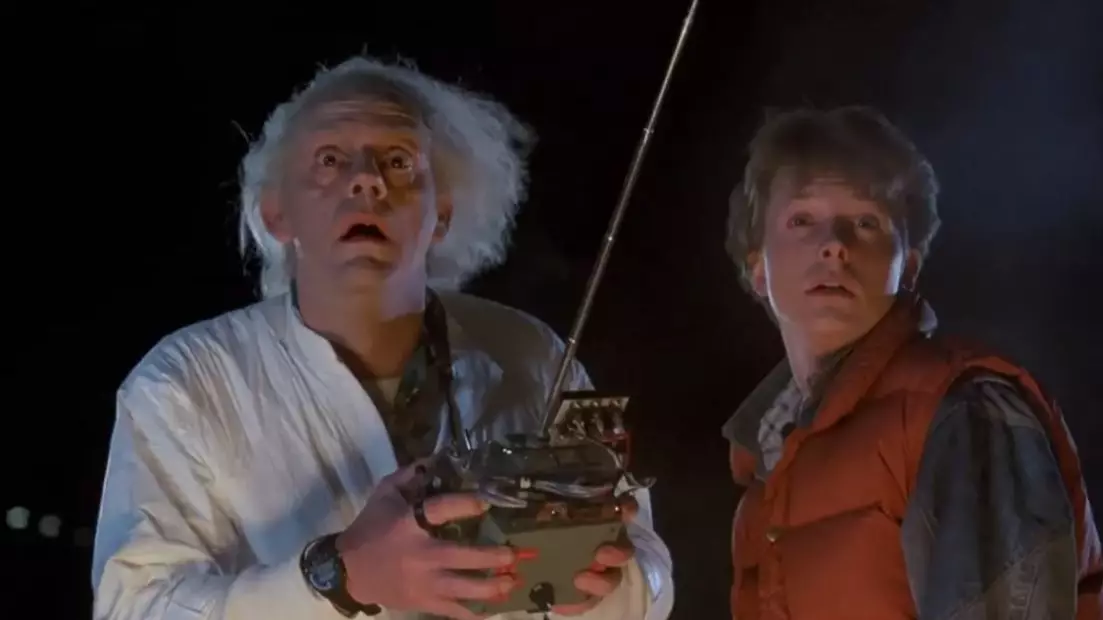
TikTok ‘Time Traveller’ Reveals Five Upcoming Dates To Be Prepared For
The first of these cataclysmic events is due next month.
A TikTok 'time traveller' said to be sent back from the future has informed us of five important dates to put in our calendars. To see the dates, watch video below:
The self-proclaimed 'Time Traveller', @aesthetictimewarper , captioned the TikTok video: "Amazing things to come..."
With over 500,000 likes and 15,000 comments, the post has gained some momentum.
The footage shown is of a time lapse with, what appears to be, a skyline overlooking a city. On top of that are subtitles in which the TikToker makes his bold claims.

Firstly @aesthetictimewarper says: "Many of you still don't believe I am a real time traveler, so remember these five dates."
Shortly after that, a first date and event are given (in US format so month/date/year): "8/3/21: Nasa finds a mirrored Earth, opposite gravity, physics, motion."
We shall look forward to that one, it's supposed to be coming next month.
After comes a more specific event: "9/14/21: A Category 6 hurricane hits South Carolina, the worst in history."
It's not all depressing, as the time traveller's next event could be quite cool.

"10/20/21: 8 humans receive superpowers from extreme energy of the Sun."
Now that I wouldn't mind seeing, of course, as long as they use their powers for good. No Thanoses please.
Next up is one for all you dinosaur fanatics/wannabe Ross Gellers.
"12/14/21: 3 Teenagers find a T-Rex egg and a device to open a portal to an alternate universe."
Lastly, this event is predicted to happen next year and it could be a big one.
"2/2/2022: Atlantis is found in the Atlantic Ocean, housing human-fish life."
As one might imagine, the comments section was full of questions and observations.
One user from South Carolina was very concerned and asked: "Um I am very nervous about to hurricane in SC that is where I am. What part of SC?"
Whilst another 'time traveller' was quick to point something out: "I'm a time traveler too and I don't see you at the meetings."
A third user threatened to take legal action if events were proved to be wrong.
The comment read: "OK 'Mr. time traveler' if that is your real name, I saved this vid and these dates so if this don't happen I'm suing, I want my superpowers!"
The 'time traveller' has over 1.4 million likes and 230,000 followers on TikTok and according to the bio, wants 'to help humanity' and 'there is a lot you need to know'.
Topics: time travel , TikTok
Choose your content:

Apple declares one of its popular iPhones is now ‘obsolete’ which is bad news if you own it
It might be time to upgrade your old apple device.

Inmate 'Eastside' from hit Netflix jail experiment series dies aged 29
He was known for appearing on netflix's unlocked: a jail experiment.

Popular UK crisp flavour is being banned across Europe over worrying health concerns
It's bad news if this is your snack of choice on the hotel balcony.

Remote tribe was given internet for the first time and their reaction was incredibly surprising
The tribe received internet from elon musk's starlink satellites last year.
- Wowcher mystery holidays explained as women win £99 trip to New York for 'best time of their lives'
- Man claiming to be 'last human' drives Lamborghini through town to 'prove he is time traveller'
- £99 Wowcher mystery holiday sends women to New York City for 'best time of their lives'
- Millionaire praised for how he prepared kids to be successful
Periodic Special Offers
New Collection Every Quarter
30-Day Free Return Policy
Safe Online Payment
Time Travel Tower
Couldn't load pickup availability
The Tower of Time is a building that allows cats to feel the building where time flows, with flowing line structures dotting the landscape: When the sunlight shines into the open space of the upper spiral. Feel the flow of time in the changing light and shadow.
Sleek and sinuous curves Creating the beauty of organic living Semi-enclosed structure to create a quiet and comfortable space for your beloved pets Catering to Cats Decorate your home space Simple and elegant shape, high-class and elegant color scheme. Like a piece of furniture appearing in your life without disturbing spontaneous elegance. Vertical space is good for hiding and climbing 40cm in diameter and does not take up much space Vertical shape for cats to climb and hide. 40cm in diameter. Comfortable to place anywhere in the room. Safe and secure Stable base without shaking Scientific center of gravity sinking, multi-point support. Climbing and stabilizing without tipping over, playing and messing around without worry. High-density woven fabric Fine hand feel and durability Polyester + Cotton blended fabrics scientific ratio collocation. In breathable, wear-resistant, anti-wrinkle have better performance.
Packaging Size:
41*14*132cm
- New Arrivals
- TREES & SCRATCHERS
Learn More About Our Policies
We take our customers’ needs very seriously. Our team works tirelessly to craft fresh new designs and the quality of goods meets high standards. At the same time with us you can expect low prices on a wide variety of exciting items.
If you’re not totally satisfied with your purchase you can return unopened products within 3 days, together with your proof of purchase, for a full refund.
- Open featured media in gallery view
- Open media 1 in gallery view
- Open media 2 in gallery view
- Open media 3 in gallery view
- Open media 4 in gallery view
- Open media 5 in gallery view
- Open media 6 in gallery view
- Open media 7 in gallery view
- Open media 8 in gallery view
- Open media 10 in gallery view
You may also like
Subscribe to our newsletter.
By pressing the button “Subscribe”, you confirm that you have read and are agreeing to our Terms of Use regarding the storage of the data submitted through this form.
Items in your cart
Your cart is empty
- Choosing a selection results in a full page refresh.
- Anime Search
- Seasonal Anime
- Recommendations
- 2024 Challenge
- Fantasy Anime League
- Manga Search
- Manga Store
- Interest Stacks
- Featured Articles
- Episode Videos
- Anime Trailers
- Advertising
- MAL Supporter
Time Travel Anime
Action (5,127)
Adventure (4,058)
Avant Garde (894)
Award Winning (248)
Boys Love (179)
Comedy (7,325)
Drama (2,926)
Fantasy (5,783)
Girls Love (109)
Gourmet (177)
Horror (557)
Mystery (922)
Romance (2,020)
Sci-Fi (3,276)
Slice of Life (1,634)
Sports (770)
Supernatural (1,504)
Suspense (391)
Ecchi (806)
Erotica (76)
Hentai (1,526)
Adult Cast (621)
Anthropomorphic (1,007)
CGDCT (245)
Childcare (69)
Combat Sports (91)
Crossdressing (51)
Delinquents (71)
Detective (305)
Educational (280)
Gag Humor (246)
Harem (473)
High Stakes Game (50)
Historical (1,566)
Idols (Female) (323)
Idols (Male) (176)
Isekai (368)
Iyashikei (174)
Love Polygon (98)
Magical Sex Shift (30)
Mahou Shoujo (337)
Martial Arts (629)
Mecha (1,269)
Medical (49)
Military (712)
Music (4,445)
Mythology (649)
Organized Crime (95)
Otaku Culture (103)
Parody (772)
Performing Arts (117)
Psychological (427)
Racing (254)
Reincarnation (134)
Reverse Harem (77)
Romantic Subtext (54)
Samurai (240)
School (2,076)
Showbiz (44)
Space (637)
Strategy Game (329)
Super Power (718)
Survival (73)
Team Sports (312)
Time Travel (140)
Vampire (168)
Video Game (151)
Visual Arts (91)
Workplace (204)
Josei (155)
Kids (6,502)
Seinen (1,018)
Shoujo (490)
Shounen (1,964)
- Not In My List
- Plan to Watch
Members Score Newest Title
Steins;Gate
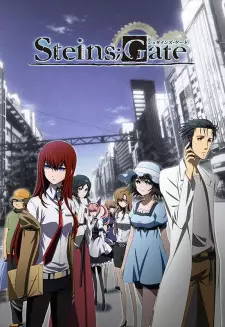
Eccentric scientist Rintarou Okabe has a never-ending thirst for scientific exploration. Together with his ditzy but well-meaning friend Mayuri Shiina and his roommate Itaru Hashida, Okabe founds the Future Gadget Laboratory in the hopes of creating technological innovations that baffle the human psyche. Despite claims of grandeur, the only notable "gadget" the trio have created is a microwave that has the mystifying power to turn bananas into green goo. However, when Okabe attends a conference on time travel, he experiences a series of strange events that lead him to believe that there is more to the "Phone Microwave" gadget than meets the eye. Apparently able to send text messages into the past using the microwave, Okabe dabbles further with the "time machine," attracting the ire and attention of the mysterious organization SERN. Due to the novel discovery, Okabe and his friends find themselves in an ever-present danger. As he works to mitigate the damage his invention has caused to the timeline, Okabe fights a battle to not only save his loved ones but also to preserve his degrading sanity. [Written by MAL Rewrite]
Re:Zero kara Hajimeru Isekai Seikatsu
Re:zero -starting life in another world-.

When Subaru Natsuki leaves the convenience store, the last thing he expects is to be wrenched from his everyday life and dropped into a fantasy world. Things are not looking good for the bewildered teenager; however, not long after his arrival, he is attacked by some thugs. Armed with only a bag of groceries and a now useless cell phone, he is quickly beaten to a pulp. Fortunately, a mysterious beauty named Satella, in hot pursuit after the one who stole her insignia, happens upon Subaru and saves him. In order to thank the honest and kindhearted girl, Subaru offers to help in her search, and later that night, he even finds the whereabouts of that which she seeks. But unbeknownst to them, a much darker force stalks the pair from the shadows, and just minutes after locating the insignia, Subaru and Satella are brutally murdered. However, Subaru immediately reawakens to a familiar scene—confronted by the same group of thugs, meeting Satella all over again—the enigma deepens as history inexplicably repeats itself. [Written by MAL Rewrite]
Boku dake ga Inai Machi

When tragedy is about to strike, Satoru Fujinuma finds himself sent back several minutes before the accident occurs. The detached, 29-year-old manga artist has taken advantage of this powerful yet mysterious phenomenon, which he calls "Revival," to save many lives. However, when he is wrongfully accused of murdering someone close to him, Satoru is sent back to the past once again, but this time to 1988, 18 years in the past. Soon, he realizes that the murder may be connected to the abduction and killing of one of his classmates, the solitary and mysterious Kayo Hinazuki, that took place when he was a child. This is his chance to make things right. Boku dake ga Inai Machi follows Satoru in his mission to uncover what truly transpired 18 years ago and prevent the death of his classmate while protecting those he cares about in the present. [Written by MAL Rewrite]
Tokyo Revengers
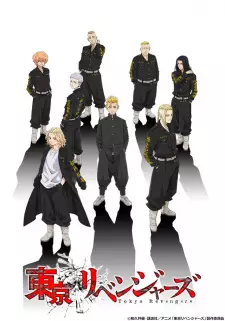
Takemichi Hanagaki's second year of middle school was the highest point in his life. He had respect, a gang of friends he could count on, and even a girlfriend. But that was twelve years ago. Today, he's a nobody: a washed-up nonentity made fun of by children and always forced to apologize to his younger boss. A sudden news report on the Tokyo Manji Gang's cruel murder of the only girlfriend he ever had alongside her brother only adds insult to injury. Half a second before a train ends his pitiful life for good, Takemichi flashes back to that same day 12 years ago, when he was still dating Hinata Tachibana. After being forced to relive the very same day that began his downward spiral, Takemichi meets Hinata's younger brother. Without thinking, he admits to his seeming death before flashing back to the past. Takemichi urges him to protect his sister before inexplicably returning to the future. Miraculously, he is not dead. Stranger still, the future has changed. It seems as though Takemichi can alter the flow of time. Given the chance to prevent his ex-girlfriend's tragic death at the hands of the Tokyo Manji Gang, Takemichi decides to fly through time to change the course of the future. [Written by MAL Rewrite]
Re:Zero kara Hajimeru Isekai Seikatsu 2nd Season
Re:zero -starting life in another world- season 2.

A reunion that was supposed to spell the arrival of peaceful times is quickly shattered when Subaru Natsuki and Emilia return to Irlam village. Witnessing the devastation left behind by the calamities known as Sin Archbishops, Subaru sinks into the depths of despair as his ability to redo proves futile. As the group makes their way to the Sanctuary in search of answers, Subaru has an unexpected encounter with the Witch of Greed—Echidna. Subjected to her untamed rhythm, he is forced to dive into the spirals of the past and future. At the same time, several mysterious threats set their sights on the Sanctuary, heralding a horrific fate for the hapless people trapped within. Everlasting contracts, past sins, and unrequited love will clash and submerge into a river of blood in the second season of Re:Zero kara Hajimeru Isekai Seikatsu. Pushed to the brink of hopelessness, how long will Subaru's resolve to save his loved ones last? [Written by MAL Rewrite]
Re:Zero kara Hajimeru Isekai Seikatsu 2nd Season Part 2
Re:zero -starting life in another world- season 2 part 2.

After a stern yet compelling speech by Otto Suwen, Subaru Natsuki solemnly swears that he will successfully make it through this timeline and save everyone he can along the way. The first step toward achieving this goal is to help Emilia work through her past; however, that is easier said than done. Feeling as if she has been lied to by everyone around her, it will be difficult for Emilia to trust anyone, even Subaru, her self-proclaimed knight. Re:Zero kara Hajimeru Isekai Seikatsu 2nd Season Part 2 presents the culmination of Subaru's experiences with the Sanctuary and its people, along with his unwillingness to give up hope on saving them. [Written by MAL Rewrite]
Steins;Gate 0

The eccentric, self-proclaimed mad scientist Rintarou Okabe has become a shell of his former self. Depressed and traumatized after failing to rescue his friend Makise Kurisu, he has decided to forsake his mad scientist alter ego and live as an ordinary college student. Surrounded by friends who know little of his time travel experiences, Okabe spends his days trying to forget the horrors of his adventures alone. While working as a receptionist at a college technology forum, Okabe meets the short, spunky Maho Hiyajo, who later turns out to be the interpreter at the forum's presentation, conducted by Professor Alexis Leskinen. In front of a stunned crowd, Alexis and Maho unveil Amadeus—a revolutionary AI capable of storing a person's memories and creating a perfect simulation of that person complete with their personality and quirks. Meeting with Maho and Alexis after the presentation, Okabe learns that the two were Kurisu's colleagues in university, and that they have simulated her in Amadeus. Hired by Alexis to research the simulation's behavior, Okabe is given the chance to interact with the shadow of a long-lost dear friend. Dangerously tangled in the past, Okabe must face the harsh reality and carefully maneuver around the disastrous consequences that come with disturbing the natural flow of time. [Written by MAL Rewrite]

Naho Takamiya's first day of her sophomore year of high school is off to an uneasy start. After waking up late, she receives a strange letter addressed to her. However, the letter is from herself—10 years in the future! At first, Naho is skeptical of the note; yet, after witnessing several events described to take place, she realizes the letter really is from her 26-year-old self. The note details that Naho's future life is filled with regrets, and she hopes that her younger self can correct the mistakes that were made in the past. The letter also warns her to keep a close eye on the new transfer student, Kakeru Naruse. Naho must be especially careful in making decisions involving him, as Kakeru is not around in the future. With the letter as her guide, Naho now has the power to protect Kakeru before she comes to regret it once more. [Written by MAL Rewrite]

Kagome Higurashi's 15th birthday takes a sudden turn when she is forcefully pulled by a demon into the old well of her family's shrine. Brought to the past, when demons were a common sight in feudal Japan, Kagome finds herself persistently hunted by these vile creatures, all yearning for an item she unknowingly carries: the Shikon Jewel, a small sphere holding extraordinary power. Amid such a predicament, Kagome encounters a half-demon boy named Inuyasha who mistakes her for Kikyou, a shrine maiden he seems to resent. Because of her resemblance to Kikyou, Inuyasha takes a violent dislike to Kagome. However, after realizing the dire circumstances they are both in, he sets aside his hostility and lends her a hand. Unfortunately, during a fight for the Shikon Jewel, the miraculous object ends up shattered into pieces and scattered across the land. Fearing the disastrous consequences of this accident, Kagome and Inuyasha set out on a challenging quest to recover the shards before they fall into the wrong hands. [Written by MAL Rewrite]
Toki wo Kakeru Shoujo
The girl who leapt through time.

Makoto Konno is in her last year of high school, but is having a hard time deciding what to do with her future. In between enduring the pressure of her teachers and killing time with her best friends, Makoto's life suddenly changes when she accidentally discovers that she is capable of literally leaping through time. Toki wo Kakeru Shoujo follows Makoto as she plays around with her newfound power. However, she soon learns the hard way that every choice has a consequence, and time is a lot more complicated than it may seem. [Written by MAL Rewrite]
Kaifuku Jutsushi no Yarinaoshi
Redo of healer.

When Keyaru acquired his powers as a Hero who specialized in healing all injuries regardless of severity, it seemed that he would walk the path to a great future. But what awaited him instead was great agony; he was subjected to years of seemingly endless hellish torture and abuse. Keyaru's healing skills allowed him to secretly collect the memories and abilities of those he treated, gradually making him stronger than anyone else. But by the time he reached his full potential, it was far too late—he had already lost everything. Determined to put his life back on track, Keyaru decided to unleash a powerful healing spell that rewound the entire world back to the time before he began to suffer his horrible fate. Equipped with the anguish of his past, he vows to redo everything in order to fulfill a new purpose—to exact revenge upon those who have wronged him. [Written by MAL Rewrite]
Vivy: Fluorite Eye's Song
Vivy -fluorite eye's song-.

When highly evolved AIs set out to eradicate mankind, the carnage that ensues fills the air with the stench of fresh blood and burning bodies. In a desperate bid to prevent the calamity from ever occurring, a scientist bets everything on a remnant from the past. Turning the clock back a hundred years, AIs are already an integral part of human society, programmed with specific missions meant to be carried out for their entire course of operation. Vivy, the first ever autonomous AI, is a songstress tasked with spreading happiness through her voice. In a theme park where she hardly ever gets a proper audience, she strives to pour her heart out into her performances, bound to repeat it day after day—that is, until an advanced AI from the future appears before her and enlists her help in stopping a devastating war a hundred years in the making. With no time to process the revelation that flips her world upside down, Vivy is catapulted into a century-long journey to avert the violent history yet to come. [Written by MAL Rewrite]
Summertime Render
Summer time rendering.

Since the death of his parents, Shinpei Ajiro had lived with the Kofune family and their two daughters—Mio and Ushio. Although he then left his home island to continue his education in Tokyo, Shinpei returns after Ushio tragically drowns during the attempted rescue of a little girl. During the funeral, his best friend informs him about bruises found around Ushio's neck, casting doubt over the cause of her death. Suspecting a murder has taken place, Shinpei reevaluates recent events, but strange incidents only continue to transpire. Disappearing people and other unexplainable occurrences lead Mio to recall an old folktale referring to entities called "Shadows," which may not be entirely fantasy. Supposedly, an encounter with one's Shadow foretells the person's impending demise. Facing the dark side of Hitogashima Island, Shinpei stands against his grim fate to fulfill Ushio's final will—to protect Mio. [Written by MAL Rewrite]
Yojouhan Shinwa Taikei
The tatami galaxy.

One autumn evening at a mysterious ramen stand behind the Shimogamo Shrine, a lonely third-year college student bumps into a man with an eggplant-shaped head who calls himself a god of matrimony. Meeting this man causes the student to reflect upon his past two years at college—two years bitterly spent trying to break up couples on campus with his only friend Ozu, a ghoulish-looking man seemingly set on making his life as miserable as possible. Resolving to make the most out of the rest of his college life, the student attempts to ask out the unsociable but kind-hearted underclassman Akashi, yet fails to follow through, prompting him to regret not living out his college life differently. As soon as this thought passes through his head, however, he is hurtled through time and space to the beginning of his years at college and given another chance to live his life. Surreal, artistic, and mind-bending, Yojouhan Shinwa Taikei chronicles the misadventures of a young man on a journey to make friends, find love, and experience the rose-colored campus life he always dreamed of. [Written by MAL Rewrite]
Steins;Gate: Oukoubakko no Poriomania
Steins;gate: egoistic poriomania.

A few months after the events of Steins;Gate, Rintarou Okabe and his group of friends are invited to tag along with their acquaintance Faris NyanNyan, who is participating in a Rai-Net battle event in the United States. There, they meet up with an old colleague: Kurisu Makise, who has been recalling fragmented memories of events that happened in the other world lines in the form of dreams. She confronts Okabe, questioning him as to whether these events—particularly the incidents between the two of them—did indeed happen. [Written by MAL Rewrite]
Shiguang Dailiren

It is said that a picture is worth a thousand words. In this case, it holds an infinite amount of secrets. These are secrets that only Cheng Xiaoshi and Lu Guang are able to find. In a small shop called "Time Photo Studio," the two friends provide a special service: using their extraordinary powers that let them enter photographs, they jump into pictures brought to them by clients in order to grant their wishes. Through the eyes of the photographer, they live through the events surrounding the picture and try to decipher how to solve their client's request. But every time they jump into a picture, they take a great risk. One wrong move and they could alter the future of the person who took the picture... and possibly countless other events too. So when the events they are forced to live through in these pictures start to become personal, it will take the utmost strength to push their feelings aside and focus on accomplishing the task they were paid to do. [Written by MAL Rewrite]
Tokyo Revengers: Seiya Kessen-hen
Tokyo revengers: christmas showdown.
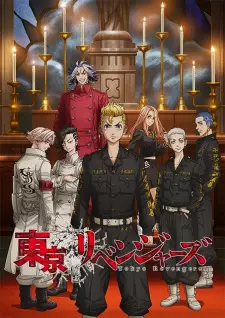
In spite of his best time-leaping efforts, Takemichi Hanagaki continuously fails to prevent the present-day death of Hinata Tachibana, his adolescent love. The adult Takemichi grapples with grief and the ramifications of the Tokyo Manji gang's criminal empire—an unintended product of his timeline meddling. Though the gang once operated under the idealistic Manjirou "Mikey" Sano, it has now been taken over by the malicious Tetta Kisaki and, as a result, has abandoned its original optimistic intent. Despite feeling hopeless, Takemichi travels to the past once again to investigate Black Dragon, a rival motorcycle gang whose actions ultimately lead to Hinata's demise. There, he meets the young Hakkai Shiba, a fellow gang member whose older brother, Taiju, tyrannically rules Black Dragon. When Taiju brutally beats Takemichi in a one-sided street brawl, Hakkai attempts to withdraw from Tokyo Manji in apology—an act that Takemichi must prevent to spare Hakkai a grim future. Through a shared tragedy, Takemichi bonds with Chifuyu Matsuno, establishing a close comradery both boys desperately need. With Chifuyu on his side, Takemichi works to unravel the fates of Black Dragon's members, fighting to create a happy future for his loved ones. [Written by MAL Rewrite]
Bokutachi no Remake
Remake our life.

Life is not going well for 28-year-old Kyouya Hashiba. Having left his office job to pursue a career in the video game industry, his internship at a popular game studio abruptly ends, leaving him unemployed and forcing him to move back in with his parents. Additionally, his jealousy toward the success of the "Platinum Generation"—a group of similarly-aged creators—has caused him to regret his decision to attend a traditional university instead of an arts college. Even though he believes there are no second chances in life, Kyouya is suddenly given one when he wakes up one day and finds himself 10 years in the past. Instead of choosing business school like he originally had, Kyouya decides to pursue his passions and attends the Oonaka University of Art. There, he meets classmate Eiko Kawasegawa, the woman who had hired him as an intern in the present, alongside his new housemates and future Platinum Generation members: underachieving artist Aki Shino, aspiring singer and actress Nanako Kogure, and naturally-gifted writer Tsurayuki Rokuonji. With each project they complete together, Kyouya and his friends venture closer to discovering their true potential as creators and remaking their lives into the ideal versions they desire. [Written by MAL Rewrite]
Irozuku Sekai no Ashita kara
Iroduku: the world in colors.

Despite the kaleidoscopic magic ingrained in everyday life, Hitomi Tsukishiro's monochrome world is deprived of emotion and feeling. On a night as black and white as any other, amidst the fireworks spreading across the sky, Hitomi's grandmother Kohaku conjures a spell, for which she has been harnessing the moon's light for 60 years, to send Hitomi back in time to the year 2018 when Kohaku was in high school. Hitomi's mission seems unclear, but her grandmother assures her that she will know when she gets there. Following a trip through time aboard a train driven by a strange yellow creature, Hitomi finds herself in stoic artist Yuito Aoi's room, and his drawings flood her world with color. What is Hitomi's purpose there, and why do Yuito's drawings return such breathtaking color to her drab world? [Written by MAL Rewrite]
Oda Nobuna no Yabou
The ambition of oda nobuna.

High school student Yoshiharu Sagara wakes up and finds himself in the middle of a raging Sengoku period battle. He is saved by the legendary Hideyoshi Toyotomi, but at the cost of the hero's life. With his dying breath, the warrior pleads for Yoshiharu to become a feudal lord in his place. Now that the course of history has been changed, Yoshiharu pledges to keep the timeline from diverging any further. Yet, after rescuing Nobuna Oda—whom he discovers is actually the fabled Nobunaga Oda's female counterpart—Yoshiharu realizes he has been transported to an alternate reality where most of Japan's historical warlords are now cute girls! To set things right and find a way back home, Yoshiharu agrees to become one of Nobuna's retainers and assist her in a conquest of Japan. As Nobuna initiates her campaign, Yoshiharu discovers that the history he learned from playing the video game "Nobunaga's Ambition" allows him to predict future events and turn the tide of war. Using this invaluable gift to aid the Oda clan's beautiful generals, Yoshiharu hopes to help his new lord fulfill her dream and win the hearts of women everywhere. [Written by MAL Rewrite]
InuYasha: Kanketsu-hen
Inuyasha: the final act.

Thwarted again by Naraku, Inuyasha, Kagome Higurashi, and their friends must continue their hunt for the few remaining Shikon Jewel shards, lest they fully form into a corrupted jewel at the hands of Naraku. But Naraku has plans of his own to acquire them, and will destroy anyone and anything standing in his way—even his own underlings. The persistent, unyielding danger posed by Naraku forces Sango and Miroku to decide what is most important to them—each other or their duty in battle. Meanwhile, Inuyasha must decide whether his heart lies with Kikyou or Kagome, before fate decides for him. Amid the race to find the shards, Inuyasha and his brother Sesshoumaru must also resolve their feud and cooperate for their final confrontation with Naraku, as it is a battle they must win in order to put a stop to his evil and cruelty once and for all. [Written by MAL Rewrite]
Steins;Gate: Kyoukaimenjou no Missing Link - Divide By Zero
Steins;gate: open the missing link - divide by zero.
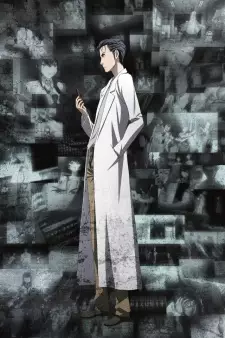
Having reached his emotional breaking point, Rintarou Okabe refuses to continue aiding time traveler Suzuha Amane in her mission to prevent World War III, believing any further efforts to save Makise Kurisu will be in vain. Shortly after, Okabe abandons his mad scientist persona and becomes a seemingly regular university student. Okabe's close friend Mayuri Shiina perceives him to be recovering from his trauma and is visibly happy. However, something still seems to be bothering Okabe. Steins;Gate: Kyoukaimenjou no Missing Link - Divide By Zero marks the beginning of a critical divergence—a timeline in which the burden of fate escalates beyond one's limits. [Written by MAL Rewrite]
Naruto: Shippuuden Movie 4 - The Lost Tower
Naruto shippuden the movie 4: the lost tower.

Led by Yamato, Naruto Uzumaki, Sakura Haruno, and Sai are assigned to capture Mukade, a rogue ninja who is pursuing the ancient chakra Ryuumyaku located underneath the Rouran ruins. While the Ryuumyaku has been sealed by the Fourth Hokage, the group fails to prevent Mukade from releasing its power. Consequently, a strong energy burst engulfs both Naruto and Yamato before they can escape. As he awakens in a magnificent yet hostile kingdom, Naruto meets its young queen Saara and three Konohagakure ninjas on a top-secret mission. They reveal to him that he has time-traveled to Rouran 20 years into the past! To make matters worse, Mukade has already infiltrated the royal court, becoming the naive queen's most trusted minister under the alias Anrokuzan. Joining forces with the three ninjas, Naruto must protect Saara's life without fail to stop the villain's plans and return to the present. [Written by MAL Rewrite]
Gintama Movie 2: Kanketsu-hen - Yorozuya yo Eien Nare
Gintama: the movie: the final chapter: be forever yorozuya.

When Gintoki apprehends a movie pirate at a premiere, he checks the camera's footage and finds himself transported to a bleak, post-apocalyptic version of Edo, where a mysterious epidemic called the "White Plague" has ravished the world's population. It turns out that the movie pirate wasn't a pirate after all—it was an android time machine, and Gintoki has been hurtled five years into the future! Shinpachi and Kagura, his Yorozuya cohorts, have had a falling out and are now battle-hardened solo vigilantes and he himself has been missing for years, disappearing without a trace after scribbling a strange message in his journal. Setting out in the disguise given to him by the android time machine, Gintoki haphazardly reunites the Yorozuya team to investigate the White Plague, and soon discovers that the key to saving the future lies in the darkness of his own past. Determined to confront a powerful foe, he makes an important discovery—with a ragtag band of friends and allies at his side, he doesn't have to fight alone. [Written by MAL Rewrite]

After escaping a bus hijacking with the help of masked superhero Strange Juice, Yuuta Iridatsu finds his soul separated from his body and in the care of a perverse cat spirit, Chiranosuke. As a spirit, Yuuta wanders around his residence, the Korai House, aiming to regain his body and observe the other residents: Meika Daihatsu, a genius inventor; Mikatan Narugino, a cheerful idol; Ito Hikiotani, a shut-in NEET; and Rabura Chichibu, a spiritual medium. After catching a glimpse of Narugino's undergarments, Chiranosuke reveals to Yuuta that he becomes exponentially stronger upon seeing panties. However, if he sees another pair while he is still a spirit, his power will cause an asteroid to crash into the earth, ending the world and killing his friends. Punch Line follows Yuuta as he unravels the mysteries surrounding Korai House, its residents, and a villainous organization attempting to end the world. Will Yuuta be able to save everyone, or will the ever-present threat of panties result in their doom? [Written by MAL Rewrite]
Fate/Grand Order: First Order
Fate/grand order -first order-.

In 2015, the Chaldea Security Organization draws on experts of both the magical and mundane fields to observe the future of mankind for possible extinction events. Humanity's survival seems assured for the next century—until the verdict suddenly changes, and now eradication of the species awaits at the end of 2016. The cause is unknown, but appears to be linked with the Japanese town of Fuyuki and the events of 2004 during the Fifth Holy Grail War. In response, Chaldea harnesses an experimental means of time travel, the Rayshift technology. With it, Ritsuka Fujimaru, a young man newly recruited to the organization, and the mysterious girl Mash Kyrielight, can travel back to 2004 and discover how to save humanity. A grand order to fight fate has been declared—an order to change the past and restore the future. [Written by MAL Rewrite]
Tokyo Revengers: Tenjiku-hen
Tokyo revengers: tenjiku arc.

After succeeding in their winter conflict against Taiju Shiba and his Black Dragons, the Tokyo Manji Gang absorbs their group's remaining members. Due to his heroic courage and indomitable spirit, Takemichi Hanagaki should have accomplished his goal of defeating the tragic fate awaiting his girlfriend, Hinata Tachibana. In reality, Takemichi's troubles are far from over. Although Takemichi's actions have exposed Tetta Kisaki's treachery, the conniving schemer has found power elsewhere: Tenjiku, a dangerous gang led by the enigmatic Izana Kurokawa. Izana sets his sights on Manjirou "Mikey" Sano, pursuing a vicious interest in the Tokyo Manji Gang's aloof leader. In the future, Takemichi discovers that the machinations of Izana and Kisaki led to Mikey's moral ruin—a downfall that directly results in Hinata's death. Unfortunately, a terrible loss robs Takemichi of his time-leaping ability, stranding him in the past with one final chance to rescue everyone he loves. [Written by MAL Rewrite]
Kamisama Hajimemashita: Kako-hen

While playing in the snow one day at her shrine, the land god Nanami Momozono witnesses her familiar—the fox youkai Tomoe—collapse, with dark markings appearing on his body. Tomoe's former master, Lord Mikage, appears after his long absence and places Tomoe into a magical pocket mirror in order to stave off his ailment. Mikage explains that long ago, before he and Tomoe had met, the fox youkai was in love with a human woman. Seeking to live as a human with his beloved, he made a deal with a fallen god, but he only ended up cursed and dying. When Mikage discovered Tomoe, the god made the youkai forget his human love as a quick solution. However, something has changed recently to reactivate the curse; Tomoe has fallen in love with his new human master, Nanami. Since there is no way to stop the curse, Nanami wants to stop Tomoe from getting cursed in the first place by traveling back through time, even if it means they may never meet. As Nanami travels back hundreds of years to save her precious familiar, she discovers that she is far more closely bonded to Tomoe than she previously thought. [Written by MAL Rewrite]
Re:Zero kara Hajimeru Isekai Seikatsu 3rd Season
Re:zero -starting life in another world- season 3.

3rd Season of Re:Zero kara Hajimeru Isekai Seikatsu
Sakurada Reset
Sagrada reset.

Kei Asai lives in the oceanside city of Sakurada—a town where the inhabitants are born with strange abilities. On the school rooftop one day, he meets Misora Haruki, an apathetic girl with the power to reset anything around her up to three days prior. While no one knows when she has reset, not even Haruki, Kei can retain everything before the reset thanks to his own ability: photographic memory. After they successfully help someone by combining their powers, they join the Service Club to aid others in their town. However, their club becomes involved with and begins completing missions for the mysterious Administration Bureau—an organization that focuses on managing the abilities in Sakurada and manipulating the town's events for their own ends. They may find out that there are more things at work in Sakurada than the machinations of the uncanny organization. [Written by MAL Rewrite]
Mirai no Mirai

In a quiet corner of the city, four-year-old Kun Oota has lived a spoiled life as an only child with his parents and the family dog, Yukko. But when his new baby sister Mirai is brought home, his simple life is thrown upside-down; suddenly, it isn't all about him anymore. Despite his tantrums and nagging, Mirai is seemingly now the subject of all his parents' love. To help him adapt to this drastic change, Kun is taken on an extraordinary journey through time, meeting his family's past, present, and future selves, as he learns not only what it means to be a part of a family, but also what it means to be an older brother. [Written by MAL Rewrite]
Loop 7-kaime no Akuyaku Reijou wa, Moto Tekikoku de Jiyuu Kimama na Hanayome Seikatsu wo Mankitsu suru
7th time loop: the villainess enjoys a carefree life married to her worst enemy.

Rishe Irmgard Weitzner finds herself in a familiar situation: her fiancé is publicly breaking off their engagement, and her ducal family is about to disown her in shame. However, Rishe is not distraught; she has already had six chances to rebuild her life and chase a different passion each time. But she would always get swept up in a war and die, so now she wishes for her seventh reincarnation to be easygoing and uneventful. What Rishe does not take into account is the presence of Arnold Hein, the crown prince of the Galkhein Kingdom. He is destined to usurp the throne and become a tyrant who starts a large-scale invasion of neighboring countries. To make their encounter worse, Arnold is the one who killed Rishe in her previous life. That is why it is all the more shocking when he proposes to Rishe on the spot. In pursuit of her desired life, Rishe must consider accepting Arnold's proposal and discover the reasons behind his brutal actions to stop the war from ever happening. [Written by MAL Rewrite]
Orange: Mirai
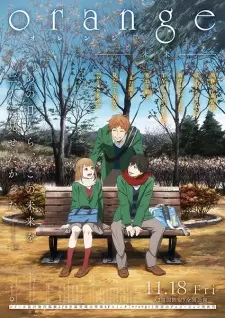
Twenty-six-year-old Hiroto Suwa; his wife, Naho; and their old high school classmates—Takako Chino, Azusa Murasaka, and Saku Hagita—visit Mt. Koubou to view the cherry blossoms together. While watching the setting sun, they reminisce about Kakeru Naruse, their friend who died 10 years ago. Mourning for him, they decide to visit Kakeru's old home, where they learn the secret of his death from his grandmother. Filled with regret, Suwa and his friends decide to write letters to their 16-year-old past selves to set their hearts at rest. With the knowledge contained in the letter from his future self, 16-year-old Suwa has the chance to rewrite the future. What choices will he make? What will happen in this new future? [Written by MAL Rewrite]
Island (TV)

On a remote island far from the mainland named Urashima, a man washes ashore, with no recollection of his name or homeland. What he does recall, however, is that he is a time traveler with a mission: to save a certain girl from harm. As nightfall arrives, he meets Rinne Ohara, a girl who sings a tune that reminds him of a specific name—Setsuna—and decides to use it as his own. Knowing another "Setsuna" herself, Rinne takes him to her household as a servant, hoping that he is the same one she remembers. On the other hand, Setsuna continues to learn more about Urashima, desiring to identify his lost past. He comes to know about the island's folklore, its three great families, and the endemic disease that prevents anyone afflicted from stepping out into the daylight. As the mysteries of his missing memories and Urashima itself unfold, Setsuna must remember his purpose and fulfill his mission as soon as possible. But, as he witnesses the myriad of troubles plaguing the island, Setsuna begins to question—is his temporal displacement merely an effort to change a single girl's fate? [Written by MAL Rewrite]
Hanyou no Yashahime: Sengoku Otogizoushi
Yashahime: princess half-demon.
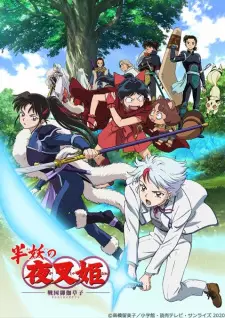
Half-demon twins Towa and Setsuna were always together, living happily in Feudal Japan. But their joyous days come to an end when a forest fire separates them and Towa is thrown through a portal to modern-day Japan. There, she is found by Souta Higurashi, who raises her as his daughter after Towa finds herself unable to return to her time. Ten years later, 14-year-old Towa is a relatively well-adjusted student, despite the fact that she often gets into fights. However, unexpected trouble arrives on her doorstep in the form of three visitors from Feudal Japan; Moroha, a bounty hunter; Setsuna, a demon slayer and Towa's long-lost twin sister; and Mistress Three-Eyes, a demon seeking a mystical object. Working together, the girls defeat their foe, but in the process, Towa discovers to her horror that Setsuna has no memory of her at all. Hanyou no Yashahime: Sengoku Otogizoushi follows the three girls as they endeavor to remedy Setsuna's memory loss, as well as discover the truth about their linked destinies. [Written by MAL Rewrite]
Kikansha no Mahou wa Tokubetsu desu
A returner's magic should be special.

After a decade spent fighting monsters in the Shadow Labyrinth—a growing dark cloud of magic that threatens to engulf the world and destroy all life—mage Desir Herrman and his five companions finally face their last foe: the dragon of destruction Boromir Napolitan. Although the group of heroes manages to slay this formidable opponent, the tremendous amount of mana stored within the dragon's body is released in an unstoppable explosion that annihilates the rest of the world. However, instead of dying, Desir is sent back 10 years into the past with complete memories of events to come. He enrolls at Hebrion Academy, determined to put an end to the classist prejudice plaguing the magical world that will ultimately lead to the demise of humanity. Unfortunately, his struggle begins early on during the entrance exams; although he is ranked first of his group, Desir is assigned to the Beta Class, the default class for commoners. Now, Desir's next objective is to rally someone to his cause that he could not save in his previous life: the wind mage Romantica Eru. Then, Desir will have to show his worth to the Alpha Class with his newly formed party if he wants to ultimately save as many lives as possible. [Written by MAL Rewrite]
Sora no Aosa wo Shiru Hito yo
Her blue sky.

High school student Aoi Aioi lives with her elder sister, Akane, after a tragic accident took their parents away 13 years ago. Because Akane has since been taking care of her single-handedly, Aoi wants to move to Tokyo after her graduation to relieve her sister's burden and pursue a musical career, inspired by Akane's ex-boyfriend Shinnosuke "Shinno" Kanamuro. Shinno was part of a band until he left for Tokyo to become a professional guitarist after the sisters' parents passed away, and he was never to be seen again. One afternoon, while Aoi practices her bass in a guest house, she gets startled by the 18-year-old version of Shinno from 13 years ago! As if by coincidence, the current 31-year-old Shinno also returns to the town, but he has changed drastically. There are now two Shinno's in existence, but why is the Shinno from the past present? Sora no Aosa wo Shiru Hito yo revolves around these four individuals as they confront their inner feelings toward each other and make decisions that will affect their lives from here on out. [Written by MAL Rewrite]
Shiguang Dailiren II
Link click season 2.

The attempt to capture the mysterious perpetrator who possesses people ends tragically: Lu Guang is rushed to the hospital in a critical state, while Cheng Xiaoshi is arrested for the alleged crime. In light of recent events, the father of Liu Min unleashes his skilled, ruthless lawyer—Qian Jin—after Police Chief Li Xiao, who is spearheading the investigation related to the photo studio owned by Qiao Ling. It appears that no one is safe from the unpredictable and fatal attacks of the adversary who painstakingly hides their identity. As he tries to learn from his past mistakes, Cheng Xiaoshi must act swiftly and decisively to put an end to this devastating trail of death. [Written by MAL Rewrite]
InuYasha Movie 2: Kagami no Naka no Mugenjou
Inuyasha the movie 2: the castle beyond the looking glass.

Fortune smiles on Inuyasha and his allies when they finally defeat their nemesis Naraku, who has caused them unrelenting hardships. Overjoyed by the long-awaited victory, they all hurry to resume their former lives, unaware that danger still lurks around. Kanna and Kagura, two of Naraku's subordinates, make arrangements to set free a sealed demonic entity that claims to be Kaguya, the legendary Princess of the Heavens. Although preoccupied with their own endeavors, Inuyasha's group members reunite by a string of unusual coincidences involving Kanna and Kagura along with an inexplicable phenomenon of repeated full-moon nights. Upon realizing that Kaguya is behind the troubling events and that she holds a terrible power, they join forces once more to stop the disastrous fate she has planned for the world. [Written by MAL Rewrite]
Seikimatsu Occult Gakuin
Occult academy.
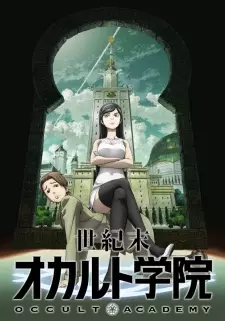
The story revolves around Maya, the daughter of the former Headmaster of Waldstein Academy, and a time traveling agent Fumiaki Uchida. In the year 2012, the world had been invaded by aliens and time travelers were sent back to the year 1999 in order to find and destroy the Nostradamus Key, which Nostradamus Prophecy foretold as what would bring about the apocalypse. The series then turns to the year 1999, where Maya returns to the Academy with the intention of destroying the Academy by superseding her late father's position as the principal. Her plan was interrupted when she meets Fumiaki and learns of the forthcoming destruction. Despite being distrusting towards Fumiaki, they form a pact to look for the Nostradamus Key. In order to find the Nostradamus Key, time agents were provided with specially created cell phones. When a user finds an object of interest, by thinking of destroying it and taking a photo, and if the resulting image is that of a peaceful world, then the subject is the Nostradamus Key. Conversely, if the subject is not the Nostradamus Key, then the photo displays destruction. By using the phone, Maya and Fumiaki investigates occult occurrences as they occur in the town. (Source: Wikipedia)
InuYasha Movie 1: Toki wo Koeru Omoi
Inuyasha the movie: affections touching across time.

During their quest in the feudal era to recover the shards of the miraculous Shikon Jewel, Inuyasha, Kagome Higurashi, and their friends become the target of Menoumaru Hyouga—a demon awakened by one of the Shikon fragments, now in pursuit of Inuyasha's heirloom sword Tessaiga. Following a clash between the fathers of Inuyasha and Menoumaru, the weapon is the only means to restore Menoumaru his rightful family heritage. However, upon ambushing Inuyasha, Menoumaru discovers that Tessaiga's owner alone can wield it. Determined to achieve his objective regardless, he kidnaps Kagome to force Inuyasha to use his blade and release the sealed powers of the Hyouga clan. With their dependable companions' assistance, Inuyasha and Kagome oppose Menoumaru, unaware that his sinister intentions and alarming potential will endanger not only their world but also its distant future. [Written by MAL Rewrite]
InuYasha Movie 3: Tenka Hadou no Ken
Inuyasha the movie 3: swords of an honorable ruler.
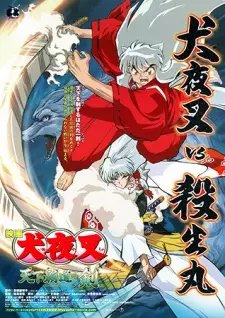
Following Inu no Taishou's death, his swords Tenseiga and Tessaiga were passed on to his sons, Sesshoumaru and Inuyasha respectively. However, there exists one more blade. During a visit to his friend Kagome Higurashi in modern times, Inuyasha encounters Sounga—his father's third sword. Found by one of Kagome's ancestors inside the old well that connects the past to the future, Sounga has been kept for years as a treasured artifact at the Higurashi shrine. Nevertheless, it soon reveals itself to harbor an evil spirit with a terrible urge to kill. While struggling to subdue its calamitous nature, Inuyasha manages to bring Sounga back to the feudal era where he must confront his brother Sesshoumaru, who has always desired to possess it. But when they lose track of the sword during their fight, the siblings engage in a fervent competition to find it, still unaware of its secret and the legacy that Inu no Taishou has left for them. [Written by MAL Rewrite]
InuYasha Movie 4: Guren no Houraijima
Inuyasha the movie 4: fire on the mystic island.

Hourai is a mysterious island that appears for a limited period once every 50 years. Some say that the isle holds the secret of eternal youth; others believe that it brings disaster to their land. When Inuyasha's group saves a half-demon child from being hunted by a monstrous creature, they learn that her name is Ai and that she fled from Hourai. Surprisingly, the girl is an acquaintance of Inuyasha and begs him to rescue her friends, who are being held prisoner by vicious demons calling themselves the Four War Gods—an enemy Inuyasha remembers well. Upon reaching Hourai, Ai's guests are horrified to discover that only a handful of orphans still inhabit the island and are destined to become sacrifices to increase the Four War Gods' powers. Furthermore, the victims bear their oppressors' enchanted mark, which prevents them from escaping. Defeating the four demons remains Inuyasha's most viable option, but their superiority in strength will require daring initiatives achievable only by the group's combined teamwork. [Written by MAL Rewrite]
Ushinawareta Mirai wo Motomete
In search of the lost future.

Kaori Sasaki—a member of Uchihama Academy's Astronomy Club—confesses to Sou Akiyama, but later that evening, she dies in a tragic road accident. Her friends and fellow club members mourn her death in a local hospital. Yet she shows up to school the following day, and no one senses anything amiss. The day finishes without any unusual incidents, and the group of friends plans for the upcoming cultural festival. Suddenly, the room is shaken by an unnatural earthquake. Everyone splits up to investigate—except for Nagisa Hanamiya, who stays behind. As everyone leaves, Nagisa notices that the odd relic-like cube that she was toying with starts emitting a strange blue light. Meanwhile, Sou stumbles upon an unconscious, naked girl lying in a pool of water. Ushinawareta Mirai wo Motomete follows the Astronomy Club's increasingly bizarre adventures—from dealing with ghosts to quelling unrests between student clubs. All the while, they unravel the circumstances behind the sudden appearance of a new transfer student. [Written by MAL Rewrite]
Noein: Mou Hitori no Kimi e
Noein: to your other self.

During their last summer of elementary school, four friends decide to undertake a test of courage at their local graveyard. Before the test begins, Haruka Kaminogi makes a last effort to pull Yuu Gotou away from his controlling mother. While doing so, Haruka suddenly has a strange vision of blue snow followed by the appearance of an imposing silver-haired man. Later, a similar vision occurs at the graveyard to both Haruka and her friends before they try to escape what they assume are ghosts. Unbeknownst to the children, the people who appeared before them are Dragon Soldiers: an elite military group from a dimension known as La'cryma. The soldiers have traveled to this dimension to secure the "Dragon Torque"—an entity they believe to be their last hope for survival. However, both the Dragon Soldiers and Haruka are shocked to learn that the Dragon Torque is Haruka herself. She attempts to escape from the Dragon Soldiers as she finds her own last ray of hope—the strange silver-haired man who claims to be another version of Yuu himself. [Written by MAL Rewrite]
Buddy Complex

When ordinary high school student Aoba Watase is suddenly targeted by a giant robot known as a "Valiancer," he is saved by his mysterious classmate Hina Yumihara. After revealing that she and their robotic enemy are from the future, Hina suddenly propels Aoba 70 years forward in order to prevent his death. Upon arrival, Aoba finds himself in the cockpit of a Valiancer called "Luxon," stuck in the midst of a firefight between the military forces of the Free Pact Alliance (FPA) and Zogilia Republic. After he shows high compatibility with an FPA pilot named Dio Weinberg, the two perform a successful "coupling," allowing them to share experiences and subsequently increase their capabilities and skills. Although Aoba is able to survive this unexpected battle, he is taken into custody by the FPA ship Cygnus, who wishes to interrogate him. While the student's main concern is whether he will ever be able to return home, what he doesn't realize is that he is about to get caught up in a war to protect the world. [Written by MAL Rewrite]
Nobunaga-sensei no Osanazuma
Nobunaga teacher's young bride.

"One day, a girl who loves me will suddenly appear before me"—Middle school teacher Nobunaga has always been dreaming of such a gal game-like situation. However, the one who appeared before him was Kichou, a 14-year-old girl who proclaims herself as his wife. Appearing to have arrived from the Sengoku era, she mistakes Nobunaga as Nobunaga Oda and urges him to conceive a child with her. Thus begins the age-difference love comedy between a gal game-loving teacher and a Sengoku era expert princess. (Source: MAL News)
Tearmoon Teikoku Monogatari: Dantoudai kara Hajimaru, Hime no Tensei Gyakuten Story
Tearmoon empire.

Due to poor finances, an epidemic, and famine, the once prosperous Tearmoon Empire ultimately falls to a revolution instigated by its citizens and supported by neighboring nations. The rebellion also brings dire consequences for Mia Luna Tearmoon, the empire's extremely spoiled princess, who endures three years in the dungeons before facing execution. By some miracle, Mia finds herself reincarnated as her 12-year-old self, retaining full memories of everything that had transpired. With the pain of the guillotine blade freshly imprinted on her neck, Mia is determined to use this second chance at life to avoid the grim fate that awaits her. She utilizes all her knowledge to improve the state of the kingdom and gather personal allies, inadvertently winning over the people's hearts and becoming beloved as a saint. [Written by MAL Rewrite]
Inazuma Eleven Go: Chrono Stone

Inazuma Eleven Go: Chrono Stone is set after the Holy Road Soccer Tournament. The hero of of the moment, Tenma Matsukaze, traveled all over Japan to teach soccer to kids. He returns to Raimon Junior High School after completing his mission, but to his surprise, it's no longer the same Raimon Junior High that he remembers. The soccer club is non-existent, and the members of the champion team in the Holy Road Soccer Tournament have no recollection of taking part in the tournament. They neither remember Tenma nor the game of soccer they loved. As Tenma is baffled by this twist, Alpha, the leader of the Route Agents and captain of Protocol Omega team, suddenly appears before him. Alpha declares that he and his team are responsible for wiping out passion for soccer in Raimon along with the memories of the soccer club members: and Tenma himself is next. That's when a strange boy named Fei Rune appears just in time to save him. Just who is Fei, and why does Alpha want to eliminate soccer for good? Tenma knows that he needs to do everything in his power to emerge victorious. It's a battle that could seal the fate of soccer forever.
Nobunaga Concerto

"Who cares about what happened in Japan's past? It has nothing to do with my life." With these words, carefree high school student Saburou finds himself unceremoniously thrown back in time to the Sengoku Era, landing directly in front of the legendary general Nobunaga Oda. Nobunaga, on the run from his retainers and wishing to rest due to his frailty, beseeches Saburou to take his place, as the two bear an uncanny resemblance. Although Saburou is still confused by his surroundings, Nobunaga hurriedly provides the boy with the necessary items to prove that he is the bona fide feudal lord and makes a hasty getaway. Now a stand-in for someone he doesn't even know all that much about—though his modern experiences and knowledge are sure to help him—Saburou begins his unexpected quest to pose as the man who attempted to unite all of Japan. [Written by MAL Rewrite]
Ninja Batman
Batman ninja.

At Arkham Asylum, Batman clashes with Gorilla Grodd while trying to destroy Grodd's newest invention: the Quake Engine. Amidst the chaos, the engine activates, and the entire asylum suddenly vanishes into thin air—Batman along with it. Once the dust settles, Batman finds himself standing in the middle of an unfamiliar road. He soon realizes that he is no longer in Gotham City—but instead in Feudal Japan! The amazement quickly fades as samurai descend upon him, seeking to take his life. Later on, Batman's investigation leads him to discover that the one responsible for the kill order is none other than his archnemesis, the Joker. Following an encounter with Catwoman, he learns that the asylum's criminals had teleported there two years earlier—each ruling over a piece of Japan with Joker being the dominant warlord. In order to return home, Batman must reactivate the Quake Engine, situated in the remnants of the asylum, now known as Arkham Castle. However, there is one problem: aside from his gadget belt, the arsenal that was once at his fingertips is all but gone. Ninja Batman follows the Dark Knight as he traverses a strange new environment, facing off against familiar foes in a bid to return to Gotham in one piece. [Written by MAL Rewrite]

Tokidoki Rikugou is a history-hating student who flunks out of his Japanese History course; his high school forces him to make up for his failed grade by attending a special museum lecture. Its star exhibit, a vast recreation of the Edo Period, promises to alleviate the delinquent student's poor grades with an elaborate simulation of the Tokugawa Shogunate: the Edo Bakumatsu Walking Tour and Exhibition. Knowing next to nothing about samurai culture or the times he's walked into, he is quickly surprised to learn of the superstitious nature of Japan during the 1600s. Quickly dismissing the existence of gods and demons, he is shocked when confronted by a demon on a bridge, who attacks the unsuspecting high-schooler. Saved by a mysterious swordsman named Kuchiha, he discovers that he can no longer escape the simulation at the history museum. Meeting another swordsman named Kon Shinonome, he discovers another contemporary that was trapped in the simulation before him. Quickly adjusting to his new home, Tokidoki must now help protect the village from demons, while uncovering the mystery of both the simulation and the company that created it. [Written by MAL Rewrite]
Meiji Tokyo Renka

Mei Ayazuki is just your ordinary, everyday high-school girl. That is until one night, when the moon is full and red, she’s transported through time to the Meiji Period by Charlie, a self-proclaimed magician. She ends up in a strange, Meiji-era ‘Tokyo’ where the existence of ghosts is accepted. Led by Charlie, she finally arrives at the Rokumeikan. There, waiting for her to arrive, are the historical figures Ougai Mori, Shunsou Hishida, Otojirou Kawakami, Kyouka Izumi, Gorou Fujita, Yakumo Koizumi, and Tousuke Iwasaki. Whilst interacting with these men, she discovers she is a Tamayori - someone who can see ghosts - a skill that is highly valued in the Meiji Period. Due to these powers, her relationship with the men begins to change… As she gets to know these handsome men in a new era she just can’t get used to, a love begins to grow within her. Will Mei be able to return to her time? What will become of her love - a love that crosses the boundaries of time and space? (Source: Honey's Anime)
Natsu no Arashi!
Summer storm.

In modern-day Japan, 13-year-old Hajime Yasaka moves to the countryside to stay with his grandfather. On the way to his new home, a lost Hajime finds himself in a cafe called Ark, where he immediately falls in love with one of the waitresses: the gorgeous Sayoko "Arashi" Arashiyama. While Arashi is initially unconcerned with the boy, her attitude quickly changes after she grasps Hajime's hand, leading her to believe they are "connected." As it turns out, Arashi is anything but a regular teenager—in reality, she is the ghost of a girl who perished in World War II. By touching a man she connects with, she gains the ability to travel back in time. Delighted to have found someone who can unlock her powers, Arashi asks Hajime to help with her mission: to save civilians from the carnage of the war that claimed her life. Smitten with Arashi, Hajime readily agrees. But as the two get further involved with Arashi's past, they soon discover that she is not the only one able to transcend time. [Written by MAL Rewrite]
16bit Sensation: Another Layer

Konoha Akisato's love for bishoujo games—a type of entertainment focused on interactions with beautiful girls—has always nurtured her aspiration of becoming a popular artist. However, as Konoha secures her first job as a sub-illustrator at the game company Blue Bell, she confronts the harsh reality surrounding her favorite genre. In 2023, the bishoujo game industry is overrun with cheap, repetitive, and low-effort releases, with Blue Bell at the core of the problem. After stumbling upon a vintage game store and reminiscing about the impressive titles of the past, Konoha suddenly winds up in the year 1992—just as the bishoujo game industry was beginning to flourish. Konoha struggles to accept her new circumstances until she joins Alcohol Soft, a small game company willing to employ her as an illustrator. Although she believes her skills from the future will propel her to success, technology and illustration are considerably old-school, and she must promptly adapt if she wishes to fulfill her dreams. [Written by MAL Rewrite]

Yu☆Gi☆Oh! Movie: Chou Yuugou! Toki wo Koeta Kizuna
Yu-gi-oh 3d: bonds beyond time.

While riding with Jack Atlas and Crow Hogan, Yuusei Fudou's Stardust Dragon is captured by Paradox, a mysterious Turbo Duelist from the future, during a Turbo Duel and turned into a Sin Monster. With the help of the Crimson Dragon, Yuusei chases after Paradox as he enters a time slip, ending up in the past. During this time, Paradox duels against Jaden Yuki, who is still able to use the powers of Yubel and The Supreme King. However, by this time Paradox had also captured Cyber End Dragon and Rainbow Dragon and overwhelms Jaden. He is saved thanks to Yuusei and the Crimson Dragon. Jaden informs Yuusei of Paradox's true intentions. By stealing various monsters from across time and turning them dark, he plans to kill Maximillion Pegasus, the creator of Duel Monsters, preventing the game from being created and causing the events of all three series to never happen. Yuusei and Jaden agree to pursue Paradox, which leads them to the past and causes a meeting with the King of Games, Yuugi Mutou. However, by the time Yuusei and Jaden arrive, Paradox had already attacked his time, supposedly killing both Pegasus and Yuugi's grandpa, and had also managed to steal Blue-Eyes White Dragon and Red-Eyes Black Dragon. After explaining everything to Yuugi, he agrees to fight with Yuusei and Jaden against Paradox in the ultimate three-on-one duel to free the trapped monsters and save both the world and time itself before it's too late. (Source: Wikipedia)
Sengoku Otome: Momoiro Paradox
Battle girls: time paradox.

Yoshino Hide is an average girl who always seems to find trouble wherever she goes. One day Yoshino visits a local shrine to pray in order to pass her upcoming test. However, Yoshino sees a blue light coming from inside the Shrine and looks inside to find a mysterious person performing a magic spell. In a stroke of bad luck, Yoshino trips on a small bell and crashes into the shrine, prompting the stranger to catch her. Upon Yoshino's capture, the magic spell spirals out of control and sends Yoshino back in time to the Sengoku Era. Yoshino then encounters Akechi Mitsuhide and Oda Nobunaga. But unlike what really happened during the era, Hideyoshino realizes that everyone in the world is female. She then decides to help Oda Nobunaga find the Crimson Armor which is said to allow the person wearing the armor to conquer all of Japan.
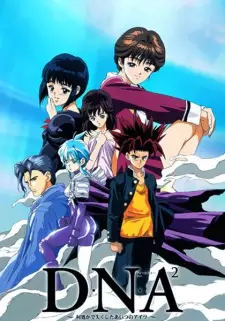
Karin, a DNA operator from the future, is on a mission to change the course of History by stopping Junta Momonari from becoming the Mega-Playboy who fathered 100 children and led to the overpopulation of the world. But Junta is no playboy; in fact he is allergic to girls. But when Karin shoots him with the wrong DNA-altering bullet, he starts sporadically becoming the Mega-Playboy capable of charming any woman. Karin must try to restore the situation to normal before the change to Mega-Playboy becomes irreversible. (Source: ANN)
Hanyou no Yashahime: Sengoku Otogizoushi - Ni no Shou
Yashahime: princess half-demon: the second act.

Second season of Hanyou no Yashahime: Sengoku Otogizoushi.
Yojouhan Time Machine Blues
The tatami time machine blues.

On a hot summer day in Kyoto, a young man walks toward his apartment, dreaming of turning on the air conditioner and cooling down. But before he can turn his dream into reality, disaster naturally strikes in the form of Ozu, who spills soda all over the remote. With the air conditioner rendered completely unusable, the man and his friends are left to suffer in the terrible August heat. Just when all hope seems lost, the group finds a true-to-life time machine in their storage room. Not knowing the dire consequences of doing so, they decide to travel back to the past and grab the remote before Ozu even has a chance to destroy it. What awaits them on the other side is a staggering adventure none of them are prepared for. [Written by MAL Rewrite]
Shiguang Dailiren Fan Wai Pian: Biwu Zhaoqin
Link click episode 5.5.

At the Time Photo Studio, partners Lu Guang and Cheng Xiaoshi accept jobs of a peculiar nature. With the aid of their complementary abilities, they are able to leap into photographs—thereby entering the past. One such case involves Liu Siwen, whose only wish is to marry his one true love, Ou Yang. However, her martial arts master father is apprehensive of a suitor who is an outsider and refuses to give his permission unless Liu Siwen defeats him in an honest duel. After years of trying and failing miserably because of his less-than-impressive skills, Liu Siwen finds himself seeking the help of Lu Guang and Cheng Xiaoshi. The two hatch a plan to outwit Ou Yang's father, but what seems simple in theory is rarely as easy to execute in reality… [Written by MAL Rewrite]
InuYasha: Kuroi Tessaiga

Sesshoumaru has never approved of his half-demon younger brother Inuyasha inheriting their father's prized sword, Tessaiga, while he was left with the restorative Tenseiga blade. Upon learning that even Tenseiga's one destructive technique—which he himself perfected—was designed to be transferred to Tessaiga, Sesshoumaru grows even more bitter as he feels disowned in favor of an unworthy mongrel. Meanwhile, Inuyasha's archenemy Naraku unscrupulously takes advantage of Sesshoumaru's grievance to tempt him with a means of stealing Tessaiga's powers. Pitted against each other, the siblings cross blades in a fight that will decide whether Inuyasha will thwart Naraku's dirty scheme and earn Sesshoumaru's acknowledgment or die at the hands of his own flesh and blood. [Written by MAL Rewrite]
Boku dake ga Inai Machi Recaps
Erased digest.

Recap episodes of Boku dake ga Inai Machi covering episodes 1 to 6 and episodes 7 to 11.
Thermae Romae

Lucius Modestus, an ancient Roman architect, finds himself job-hunting due to having trouble coming up with new ideas. As his demeanor and personality become dismal, his friends try taking him to a bathhouse for him to relax. Unable to unwind in the bustling and crowded bath, Lucius dips his head in the water. Down there, he finds a secret tunnel that transports him to a modern-day Japanese bathhouse, providing him the inspiration he needed to make a new creation. Loaded with what seems to be knowledge way ahead of his time, Lucius does his best to try and recreate his findings, usually inferior in quality due to his circumstances. However, the sheer ingenuity may be just enough to gain the attention of the citizens and regain his reputation as an architect. [Written by MAL Rewrite] Note: MAL considers this show to be three episodes and not five. See More Info for additional details.
Buddy Complex: Kanketsu-hen - Ano Sora ni Kaeru Mirai de

The two part finale of Buddy Complex television series deals with the final battle between the Free Treaty Alliance and the space division of Zogiria, lead by an elderly Bizon, as Earth and time itself hang in the balance.
Meng Qi Shi Shen
Cinderella chef.

Ye Jiayao is a young and talented cook who dreams of becoming a renowned chef one day. As luck would have it, she's magically transported back in time to Imperial China, and in the body of an extremely useless girl. Ye Jiayao is immediately kidnapped and held for ransom, but she manages to use her wits (and her sense of humor) to get whatever she wants. (Source: CBR)
Mujaki no Rakuen
Paradise of innocence.

Shouta Handa is a jobless 25 year old who is sick and tired of his boring life. One evening, at the class reunion, he gets to meet all of the cute girls that used to be his classmates. He soon discovers that they are all successful with interesting careers, and even more importantly—really beautiful now, with bigger curves. Unfortunately, it seems that they are all aware of his boring, unsuccessful life, so they mock him and call him a loser, just like in the old days. Everything changes when Shouta goes for a walk to have a smoke and accidentally falls into the school swimming pool. This triggers a supernatural phenomenon that takes him back ten years into the past. He finds himself in the same swimming pool during swimming class, surrounded by his female classmates in bikinis. How is Shouta going to deal with their cuteness and closeness now that he is a grown man in a boy's body?
Thermae Romae Novae

Lucius Modestus, an ancient Roman architect, finds himself job-hunting due to having trouble coming up with new ideas. As his demeanor and personality become dismal, his friends try taking him to a bathhouse for him to relax. Unable to unwind in the bustling and crowded bath, Lucius dips his head in the water. Down there, he finds a secret tunnel that transports him to a modern-day Japanese bathhouse, providing him the inspiration he needed to make a new creation. Loaded with what seems to be knowledge way ahead of his time, Lucius does his best to try and recreate his findings, usually inferior in quality due to his circumstances. However, the sheer ingenuity may be just enough to gain the attention of the citizens and regain his reputation as an architect. [Written by MAL Rewrite]

Beautiful sisters Ai, Mai, Mii, their android maid Mea and slippery pet ferret Unagi make an amazing journey together through time and space without ever leaving their beloved mansion behind! Following the clues of the strange dandelion-like "Popotan," the girls are theoretically seeking the person who has the answers to their most personal questions, but they seem to have more than enough time to take side trips, meet new friends, visit hot springs and occasionally operate the X-mas shop they keep in the house along the way! Yet, the girls' ultimate destiny holds more than a few surprises of its own, and not every moment is filled with hilarity, as moving through time means having to leave friends behind as well. (Source: RightStuf)
Butlers: Chitose Momotose Monogatari
Butlers x battlers.

Butlers: They are guardians that hold a thousand-year history and a certain fate. Jay lived in peace with his little sister Tenna and a fellow Butler named Hayakawa. However, those peaceful days came to a sudden end. Tenna was swallowed up into the void and Jay was sent a hundred years into the future. Jay finds there is now an academy called Koyomi Academy standing in the place where his mansion once stood. Jay took up the name Jinguji Koma and became the student council president of the school as he looks for clues about the past. Jay will eventually find out the truth behind this world. (Source: Crunchyroll)
Stand By Me Doraemon 2

After reminiscing about his late grandmother, Nobita Nobi wishes to see her again and asks Doraemon to return them to the past. Following the wholesome reunion of the two, Nobita's grandmother confesses that she hopes to meet his future bride. Nobita accepts her request out of filial love and quickly scrambles into the time machine as he and Doraemon journey forward in time. However, when the duo warps to Nobita's wedding day, they discover that the future Nobita is missing from the ceremony! Determined to set things right, Doraemon and Nobita embark on a mission to search for Nobita's future self and encourage him to discover the happiness he deserves. [Written by MAL Rewrite]

The Bakumatsu was an era in which the souls of young men burned with anxiety for their country's future. Takasugi Shinsaku, a soldier of fortune from Choshu, sneaks aboard a government ship with his comrade Katsura Kogorou in search of a mysterious "timepiece" with the power to manipulate time that he fears the government wishes to keep for themselves. Rather than allow such power to fall into the wrong hands, Takasugi plans to destroy the artifact, but having obtained it, the artifact is quickly stolen, forcing the pair to follow the mysterious thief to the seat of government in Kyoto. However, when they arrive in the capital, they discover that the government has been overthrown and the deity Susanoo now reigns in its place. The streets of the city and the people in them are much different than Takasugi and Katsura remembered. The times may have changed but their mission hasn't - Takasugi and Katsura resolve to reset time and save their nation from the nefarious forces trying to hijack it. (Source: Tokyo Otaku Mode)
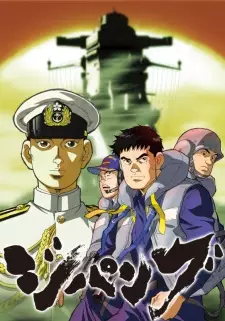
A Ripple in Time Turns the Crucial Tide of WWII. Scheduled for routine military exercises, Commander Kadomatsu and the crew of Japan's newest and most modern Battlecruiser, The Mirai, are ready to test out the ship's state-of-the-art Aegis System. Instead, they find themselves transported back to June 4th, 1942—date of the crucial Battle of Midway, where the Japanese fleet was dealt a crippling blow. When an overzealous Kadomatsu rescues one of the battle's victims, Kusaka, from a sinking zero fighter, the Mirai's fate is sealed. The crew pledges not to do anything to alter the past further. However, they're now forced to fight a U.S. submarine in a battle that should never have occurred. Thus setting off a chain of events that may forever change the flow of history! (Source: Geneon Entertainment USA, edited)
Kikansha no Mahou wa Tokubetsu desu 2nd Season
A returner's magic should be special season 2.

Second season of Kikansha no Mahou wa Tokubetsu desu.
Natsu no Arashi! Akinaichuu
Summer storm open for business.

The summer of a man's boyhood memories continue. Still on the cusp between childhood and being a man, he has linked with the ghost of a young woman from the World War 2 era. She, and the ghosts of other young ladies from that time, continue adventures alongside their linked partners, learning more about each other and travelling through time via their supernatural connection. While he struggles to see his crush on her come to fruition, meanwhile his friend—a girl his age, pretending to be a boy—seeks his attention as well. (Source: ANN)
Arata naru Sekai: World's/Start/Load/End
World's end.

Four high school girls in uniforms walk silently on the barren earth. These girls are time travelers who had been sent 6000 years into the future, from their present in which the same day is endlessly repeated, in order to evade human extinction. They studied time travel in school, were examined by the aptitude test, and were sent to the future as told. What should they do now? They had no idea. The only thing they could take with them from the present was a light, toy-like cellphone. Of course, it receives no signal here. As the girls are walking, they see strange birds flying in the sky, and a discolored river in the distance. Then, one girl finds an abandoned house, and recognizes the name inscribed on the front gates.
Vivy: Fluorite Eye's Song - To Make Everyone Happy With My Singing

Recap of all 13 episodes of Vivy: Fluorite Eye's Song.
Time Travel Shoujo: Mari Waka to 8-nin no Kagakusha-tachi
Time travel girl.

Time Travel Shoujo is based on a 1983 book titled Jishaku to Denki no Hatsumei Hakken Monogatari by Japanese educator Kiyonobu Itakura. It is part of the Hatsumei Hakken Monogatari Zenshuu series which describes the story of various scientific discoveries and inventions throughout history. The 1983 book focuses on discoveries related to magnetism and electricity.
Doraemon Movie 26: Nobita no Kyouryuu 2006
Doraemon the movie: nobita's dinosaur 2006.

Nobita finds a fossilized dinosaur egg by accident, and with the help of Doraemon's tools, they hatched the egg and began raising the dinosaur. Knowing that they can't keep the dinosaur forever, Nobita was forced to send it back to prehistoric times where a group of hunters from the future threatens to endanger the dinosaurs. Determined to save the dinosaurs from the claws of the hunters, Doraemon and the gang returns to the past and sets out in a prehistoric adventure. (Source: ANN)
Shiguang Dailiren: Yingdu Pian
Link click: yingdu chapter.

(No synopsis yet.)
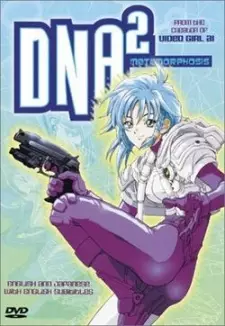
Junta's great granddaughter goes back in time in order to make Junta stay as the Mega-Playboy so she can continue to exist. Along with her comes an old man with the intention of making Junta stay as the Mega-Playboy forever for his own purposes.When Junta starts getting attacked, he has no choice but to return to being the Mega-Playboy in order to protect his loved ones.
Tsuyokute New Saga

After a fierce battle, Magic swordsman Kyle finally killed the Demon Lord after being seriously injured in the battle. Kyle on the verge of death approaches a relic which was in possession of the Demon Lord and it sends him to the past. After recovering from the initial shock, he decides to use this opportunity to avoid making the same mistakes of the past and become stronger. (Source: MU)
Bokutachi no Remake Recap
Remake our life recap.

Recap of the first 6 episodes of Bokutachi no Remake.
Meiji Tokyo Renka Movie 1: Yumihari no Serenade

On an evening lit by a crimson full moon, an ordinary high school girl named Mei Ayazuki meets a self-proclaimed magician named Charlie at a festival. Through Charlie's magic, she time-travels to the Meiji era in Tokyo, where she meets and falls in love with various great historical figures from that time period. (Source: ANN)
Bakumatsu Crisis

Jikuu Tantei Genshi-kun
Flint the time detective.

It is the 25th century. The dark lord has 'infected' history with time-devices that could damage history beyond repair. Genshi and his father lived in the prehistorics when they got turned into fossiles. They are discovered and Genshi gets turned back to his original state. With the help of his father, a boy Tony and a girl Sara he has to travel trough time to bring the time-devices back to the land of time so history will be saved. (Source: ANN)
Generator Gawl

Ryo, Gawl and Koji are 3 young boys who travel back into the past with only 1 objective: change history. In their time they discover that their country, Kubere, uses genetically enhanced persons called generators as a military tool. These generators are the cause for the Third War which kills most of the human population. Now Koji, Ryo and Gawl are there to change all the events. (Source: ANN)
Oda Nobuna no Yabou Recap
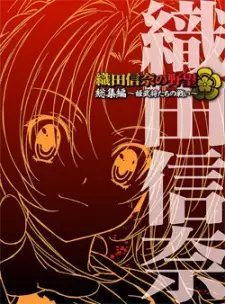
A summary episode of the whole series.
Shiguang Zhaoxiangguan de Richang
Link click: the daily life in lightime.

Chibi-styled episodes of daily life at the photo studio.
Ushinawareta Mirai wo Motomete: Ushinawareta Natsuyasumi wo Motomete

Upon regaining her senses, Yui Furukawa discovers that the current day is July 13—a starting point that she has never experienced prior. However, despite the unfamiliar circumstances, she resolves to spend her summer vacation with the other members of the Astronomy Club at Nagisa Hanamiya's family villa. The house and its surrounding area have a rich history; a renowned scientist, Nagisa's great-grandmother researched and developed technology at the nearby military manufacturing plant. While the Astronomy Club is having fun at the beach, a sudden storm stops their plans short. Left with no other choice, the group takes shelter at the abandoned factory, eventually leading them to explore a hidden underground bunker. What they encounter there may reveal an unprecedented connection to a lost future. [Written by MAL Rewrite]
Doraemon Movie 01: Nobita no Kyouryuu
Doraemon the movie: nobita's dinosaur.

Natsu-iro no Sunadokei
Sandglass of summer colors.

Makimura Koutarou has made up his mind: during the summer vacation, he is going to confess his love to the seemingly unapproachable Serizawa Kaho. Yet, on the night before, he has a run-in with a strange girl - an encounter which propels him into the future. There, he learns that not only has Kaho-chan become his girlfriend, but she has also died in a tragic accident. Returning to his own time, Koutarou sets out to change the future and save his love. (Source: ANN)
Kono Yo no Hate de Koi wo Utau Shoujo YU-NO: Mugen no Heiretsu Sekai

Unaired episode included with the third Blu-ray volume.
Tsuki wa Higashi ni Hi wa Nishi ni: Operation Sanctuary

Naoki Kuzumi, a junior in high school, had lost his parents in an accident five years ago, and is living with his aunt, uncle, and cousin Matsuri. He always thought his life was ordinary, besides the fact that he can't remember what happened in his youth. One sunny day as he is taking a nap on a bench, a redheaded girl -- Mikoto -- literally falls on him from the sky. For some reason, she thinks he's her younger brother. Naoki's time period is a temporal shelter for those in the future, when many are suffering from an incurable disease. When she heard her younger brother Yuusuke had been taken to Naoki's time, Mikoto herself had gone back in time. (Source: ANN)
Meng Qi Shi Shen: Zaijie Liangyuan
Cinderella chef: adorable food goddess.

Ye Jiayao is a modern-day celebrity chef who loves traditional Chinese recipes and often experiments with them. However, when a food experiment goes wrong, she travels back in time to the ancient times, where she becomes the daughter of a magistrate with the name Ye Jin Xuan. When she wakes up she is suddenly kidnapped to Hei Fang Camp where she meets the leader of the bandits, Xia Chun Yu, the young master of the Jing An Marquis manor, who is actually an undercover agent for the king. He had infiltrated the Black Wind Fortress bandits to investigate a plot to overthrow the king. The two then get engaged in a fake marriage. Ye Jia Yao starts to win over hearts, including Xia Chun Yu's, with her superb cooking skills and modern street smarts. (Source: Wikipedia)
Nijiiro Hotaru: Eien no Natsuyasumi
Rainbow fireflies.

Yuuta was 12-year-old boy, who had lost his father in the traffic accident one year ago. In the summer vacation, he visited a deserted dam deep in the mountains, where he had a good time with his father before. Suddenly a thunder storm occurred and he slipped on the ground. He lost consciousness and woke up to find a girl and an unfamiliar village. He time-traveled 30 years and reached a village, which sank at the bottom of the dam. This is Yuuta's precious memory of "another" summer vacation.
Magic Tree House

Based on The Magic Tree House series, award winning series of children books written by American author Mary Pope Osborne.
Yarinaoshi Reijou wa Ryuutei Heika wo Kouryakuchuu
The do-over damsel conquers the dragon emperor.

Jill Savelle—fiancée of the crown prince Gerald de Kleitos and known as the "Lady Goddess of War"—is being hunted down by the same country she swore to protect. Betrayed by her betrothed, she is framed as a traitor and imprisoned. In her last moments, Jill is filled with regret, but just as death approaches, she awakens six years in the past. This time, she will not be a mere pawn. Now as a 10-year-old girl, Jill resolves to escape her imminent engagement to the prince. To this end, she jokingly professes her love to the 19-year-old dragon emperor Hades Theos Rave, who will one day stain the land in blood due to madness. But against all expectations, he accepts! In contrast to the tyrant from Jill's memories, the Hades of this time is a kind albeit unfortunate emperor. Can Jill prevent Hades from descending down the same dark, villainous road, or is he bound to an inevitable future? [Written by MAL Rewrite]
Lupin III: Kiri no Elusive
Lupin iii: elusiveness of the fog.

On the ocean floor, Lupin is once again seeking a treasure hoping to get on Fujiko's good side. As Zenigata chases them on sea and land, people around the gang begin to vanish mysteriously. The fog rolls in and Mamo Kyosuke appears in a burst of light; he claims to be from the future and seeks revenge on Lupin III for what Lupin XIII has done to him. Mamo hurls Lupin, Jigen, Goemon, and Zenigata 500 years into the past; as two warring factions fight over a legendary shrine dedicated to time travel, Lupin must find a way to survive the past to ensure his future. (Source: Lupin III Encyclopedia) This movie is a remake of episode 13 in the original Lupin III series.
Shiguang Dailiren Special: Xiaoyao Sanren de Weituo
Link click: troubles of ordinary people.
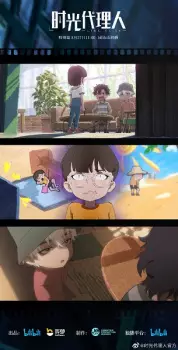
Chibi-style special episode of Shiguang Dailiren.
More Top Anime
- 1 Sousou no Frieren
- 2 Fullmetal Alchemist: Brotherhood
- 3 Steins;Gate
- 5 Shingeki no Kyojin Season 3 Part 2
More Top Airing Anime
- 1 One Piece
- 2 Hibike! Euphonium 3
- 3 Kono Subarashii Sekai ni Shukufuku wo! 3
- 4 Doupo Cangqiong: Nian Fan
- 5 Mushoku Tensei II: Isekai Ittara Honki Dasu Part 2
More Most Popular Characters
- 1 Lamperouge, Lelouch
- 3 Monkey D., Luffy
- 4 Lawliet, L
- 5 Roronoa, Zoro

10 Best Anime Movies For Children, Ranked
- Anime movies captivate children with vibrant animation, imaginative plots, and memorable characters.
- These movies entertain and impart valuable life lessons about friendship, courage, and perseverance.
- Some of the best anime movies for children include Mary and the Witch's Flower, Mirai, and Lu Over the Wall.
Anime movies offer a unique world of storytelling that captivates children's attention with vibrant animation, imaginative plots, and memorable characters. From the enchanting forests of My Neighbor Totoro to the magical adventures of Kiki's Delivery Service, these films open up a universe of wonder and excitement.
10 Best Whimsical Anime, Ranked
These movies entertain and impart valuable life lessons about friendship, courage, and perseverance with diverse themes, ranging from whimsical tales in fantastical settings to heartwarming stories. In this list of the best anime movies for children, we explore films that have won the hearts of young audiences worldwide and are well-known for their artistic merit and storytelling brilliance.
Mary And The Witch's Flower (2017)
My anime list (mal) score - 7.26, mary and the witch's flower.
Release Date 2017-06-08
Runtime 103 minutes
Genres Family, Animation, Adventure
Why Watch Mary And The Witch's Flower?
- Engaging a mix of fantasy and reality
- Promotes self-discovery and confidence
Mary and the Witch's Flower is a captivating children's anime movie about Mary Smith, a young girl who moves to the English countryside to live with her Great-Aunt Charlotte. Feeling bored and restless, Mary follows a mysterious cat into the forest, where she discovers a strange, glowing flower known as the Fly-by-Night, which only blooms once every seven years.
Upon touching the flower, Mary gains temporary magical powers and finds herself whisked away to Endor College, a school for witches in the sky. The film combines elements of magic, mystery, and self-discovery, creating a story that is not only engaging but also thrilling for children.
Mirai (2018)
My anime list (mal) score - 7.28.
Release Date 2018-07-20
Runtime 98 minutes
Genres Drama, Animation, Adventure
Why Watch Mirai?
- Time-travel adventure
- Teaches children about loving family
Mirai is a delightful and imaginative anime movie for children that revolves around Kun, a young boy who feels neglected by the arrival of his baby sister, Mirai. His life takes a magical turn when he discovers a mysterious garden in his house that serves as a gateway to time travel.
9 Best Time Travel Anime
Kun meets various family members at different points in their lives, including a teenage version of his sister Mirai, his mother as a little girl, and his great-grandfather as a young man. These encounters offer Kun new perspectives on his family. The film subtly teaches important life lessons about family and understanding others' perspectives, making it enjoyable and educational.
Lu Over The Wall (2017)
My anime list (mal) score - 7.39, lu over the wall.
Release Date 2017-05-19
Runtime 112 minutes
Genres Animation, Adventure, Fantasy
Why Watch Lu Over The Wall?
- Fun-filled experience for children
- Upbeat and catchy music
Lu Over the Wall is a vibrant and unconventional anime movie about Kai, a gloomy high school student, and Lu, a cheerful mermaid with a love for music. Kai's life changes when he joins a band with his classmates and discovers his passion for music. During a band practice session by the sea, the music attracts a peculiar and energetic Lu.
What makes this film particularly appealing to children is its colorful and dynamic animation style, which brings the underwater world and its quirky, playful characters to life. The music is another highlight, featuring catchy and upbeat tunes that kids can enjoy and sing along.
Okko's Inn (2018)
My anime list (mal) score - 7.50.
Release Date 2018-06-11
Runtime 94 minutes
Why Watch Okko's Inn?
- Imparts valuable life lessons
- Relatable character experiences
Okko's Inn is a heartwarming anime movie that centers around Okko, a young girl who goes to live with her grandmother at a traditional Japanese inn after a family tragedy. What makes this movie particularly appealing to children is its unique blend of real-life issues and supernatural elements.
Okko's encounters with friendly spirits who guide her in running the inn add an element of magical adventure. The bright and colorful animation captures the charm of traditional Japanese settings. The film teaches valuable life lessons about kindness, understanding, and overcoming challenges, making it a relatable and enjoyable experience for young audiences.
Penguin Highway (2018)
My anime list (mal) score - 7.55, penguin highway.
Release Date 2018-08-07
Runtime 117 minutes
Why Watch Penguin Highway?
- Playful penguins bring joy
- Educational and fun for children
Penguin Highway is a whimsical and imaginative anime movie for children. The story revolves around Aoyama, a bright and curious fourth-grader who investigates the sudden appearance of penguins in his suburban town. This unusual phenomenon will spark children's imagination as the penguins bring a touch of the Antarctic into a familiar, everyday setting.
This film is appealing to children because of its portrayal of the world through the eyes of a child scientist. Aoyama's methodical approach to solving the mystery is entertaining and educational, encouraging young viewers to question and explore their surroundings. The animation is colorful and lively, with the playful penguins providing comic relief and visual delight.
A Letter To Momo (2012)
My anime list (mal) score - 7.58, a letter to momo.
Release Date 2012-04-21
Runtime 120 minutes
Genres Animation, Comedy, Adventure
Why Watch A Letter To Momo?
- Heartwarming tale of coping with loss
- Mischievous goblins add playful charm
A Letter to Momo is a touching story about a young girl named Momo who is struggling to cope with her father's sudden death. After his passing, Momo finds an unfinished letter addressed to her, with only the words Dear Momo written on it. The story takes a magical turn when Momo and her mother move from Tokyo to a remote island.
What captivates children most are the three mischievous and comical goblins that Momo encounters on this island, bringing a blend of fun and whimsy to the story. These goblins, with their quirky personalities and humorous antics, provide laughter and lighten the film's more serious moments.
The Cat Returns (2002)
My anime list (mal) score - 7.72, the cat returns.
Release Date 2002-06-20
Runtime 75 minutes
Why Watch The Cat Returns?
- Whimsical magical kingdom of cats
- Charming and humorous characters
The Cat Returns starts as a fanciful tale with Haru, a high school student, who rescues a cat from an oncoming truck. Unbeknownst to her, the cat she saves is Prince Lune, the heir to the throne of the Cat Kingdom. As a token of gratitude, the cats shower Haru with gifts and then unexpectedly offer her Prince Lune's hand in marriage.
Haru's sudden engagement to a cat and her journey to the Cat Kingdom lead to a series of whimsical adventures. The movie is filled with adventure and light-hearted humor, keeping children engaged and entertained. The characters, especially the elegant and dapper cat Baron, are memorable and add to the film's charm.
The Secret World Of Arrietty (2010)
My anime list (mal) score - 7.89, the secret world of arrietty.
Release Date 2010-07-17
Why Watch The Secret World Of Arrietty?
- Enthralling miniature world
- Beautiful animation of lush, vibrant scenes
The Secret World of Arrietty by Studio Ghibli is a charming tale about a family of tiny people known as Borrowers. These Borrowers live secretly in the walls and floors of a human household. The story revolves around Arrietty, a spirited and adventurous young Borrower whose peaceful life changes when Arrietty is discovered by a human boy, Shawn.
The intricate details of how the Borrowers navigate and utilize everyday objects as part of their miniature lives will spark a child's curiosity and wonder. For instance, borrowers repurpose tissue paper for various needs, including bedding. Overall, The Secret World of Arrietty is a visually stunning film that offers a glimpse into a hidden world of wonder.
Kiki's Delivery Service (1989)
My anime list (mal) score - 8.22, kiki's delivery service.
Release Date 1989-07-29
Genres Family, Animation, Fantasy
Why Watch Kiki's Delivery Service?
- Inspiring tale of independence
- Picturesque European settings
Kiki's Delivery Service tells the adventures of Kiki, a young witch. Based on witch tradition, at the age of 13, Kiki must leave home for a year to live independently and hone her witchcraft. With her talking black cat, Jiji, Kiki flies to a far-off city on her broomstick. Settling in a beautiful seaside town , Kiki starts a flying delivery service, using her broomstick to deliver goods.
9 Best Witches in Anime
The film's bright and inviting animation portrays the picturesque seaside town and charming European-style settings. Kiki, as a young witch-in-training, is an inspiring character for children. Her journey is filled with challenges and triumphs, offering valuable lessons about perseverance and confidence.
My Neighbor Totoro (1988)
My anime list (mal) score - 8.25, my neighbor totoro.
Release Date 1988-04-16
Runtime 86 minutes
Genres Family, Animation, Comedy
Why Watch My Neighbor Totoro?
- Enchanting to all ages
- Captures childhood wonder beautifully
My Neighbor Totoro is ranked #1 on the list because it's a timeless and beloved anime movie for children. The story follows Satsuki and Mei, two young girls who, along with their father, relocate to a rural area to be closer to their sick mother. The girls quickly adapt to their new surroundings, full of lush landscapes and intriguing wildlife.
In their explorations, they encounter Totoro, a large, friendly forest spirit who can only be seen by children. Totoro, with his large, cuddly appearance and playful nature, has quickly become a favorite among young viewers. Additionally, the movie captures the innocence and wonder of childhood, where the boundaries between reality and fantasy.
10 Best 90s Anime Movies
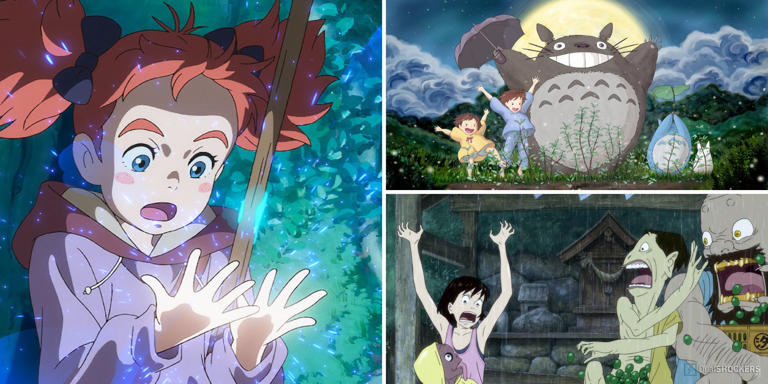
Awesome, you're subscribed!
Thanks for subscribing! Look out for your first newsletter in your inbox soon!
The best things in life are free.
Sign up for our email to enjoy your city without spending a thing (as well as some options when you’re feeling flush).
Déjà vu! We already have this email. Try another?
By entering your email address you agree to our Terms of Use and Privacy Policy and consent to receive emails from Time Out about news, events, offers and partner promotions.
- Things to Do
- Food & Drink
- Arts & Culture
- Time Out Market
- Coca-Cola Foodmarks
- Los Angeles
Get us in your inbox
🙌 Awesome, you're subscribed!

Revealed: the best low-cost airlines in 2024
AirlineRatings.com has analysed passenger reviews, fleet age and safety ratings to determine which budget operators are worth the bargain

Copping a super-cheap flight might seem like a good idea when you’ve finally had that annual leave approved, but the reality of flying on a budget can lead to everything from enduring terrible legroom to succumbing to hidden fees .
Thankfully, AirlineRatings.com has conducted some analysis into the world’s best low-cost airlines, to make those annoyances a little less likely. The platform has evaluated 12 criteria, including passenger reviews, product offerings, safety and incident ratings and the age of an operator’s fleet, awarded each airline a score out of seven, and the results have landed.
Europe did well overall, with nine low-cost airlines making the top 25, including Transavia , easyJet and Air Baltic , but Vietjet , a Vietnamese operator, won two awards in total: best ultra low-cost airline and best low-cost airline online hospitality.
Is your go-to airline for budget flights on the list? Take a look below.
The 25 best low-cost airlines in the world (in alphabetical order)
- AirAsia Group
- Air Canada Rouge
- Cebu Pacific
- Jetstar Group
More on air travel news
We bring you all the latest on air travel, from the world’s most turbulent flight paths and the new passport-free boarding process being trialled to the world’s best and the world’s busiest airports. Oh, and news on all the strikes in Europe that you need to know, too.
Did you see that these streets have been named the most beautiful in the world ?
Plus: These are the world’s smartest cities, apparently .
Stay in the loop: sign up to our free Time Out Travel newsletter for all the latest travel news.
- Liv Kelly Contributing Writer
Share the story
An email you’ll actually love
Discover Time Out original video
- Press office
- Investor relations
- Work for Time Out
- Editorial guidelines
- Privacy notice
- Do not sell my information
- Cookie policy
- Accessibility statement
- Terms of use
- Modern slavery statement
- Manage cookies
- Advertising
Time Out Worldwide
- All Time Out Locations
- North America
- South America
- South Pacific
Naperville Sun Opinion | Vickroy: Those books you truly love give you…
Share this:.
- Click to share on Facebook (Opens in new window)
- Click to share on X (Opens in new window)
- Click to print (Opens in new window)
- Click to email a link to a friend (Opens in new window)
- Naperville Sun Sports
Naperville Sun Opinion
- All Suburbs
Naperville Sun
Naperville sun opinion | vickroy: those books you truly love give you new insight into it — and yourself — every time you reread it.

The quest brings choices, dilemmas, compromises, danger, disappointment, love, mystery, near-death experiences and, finally, the revelation that throughout his long, arduous trek, his treasure was always close at hand.
Paulo Coehlo’s enchanting story has captivated readers for decades.
I just finished reading it — for the fourth time.
Its simple yet profound plot, its compelling characters, its magic and charm are still intriguing. Each time I read it I discover something new, but perhaps the find is in me, not the book.
I love stories about treasure hunts because, almost always, they are metaphors for other, more important quests. They are about our universal need to find purpose and through that, happiness.
A good book can have lifelong effects. It can reveal truths in you as it sends others on a journey. I first realized this many years ago when I read “The Hobbit” by J.R.R. Tolkien. Bilbo’s quest for treasure soon became my search for meaning.
Over the years, I’ve read “The Hobbit” four times, including once to my daughter when she was in grade school.
As this year’s crop of graduates sets off in search of their “treasure,” aka the key that unlocks the purpose of their life, the ubiquitous phrase “follow you heart” becomes almost cloyingly obnoxious.
And yet sometimes a cliché is overused for a reason: It conveys a truth. The quest for purpose, for meaning, for your raison d’etre can be an exhaustive, never-ending one. And yet, so frequently, it can be found right inside your own heart.
I love books that make me wonder and wander among those thoughts. I love to venture into another world, all the while taking a deep dive into my own. I love to walk in a character’s shoes so that I might better appreciate my own.
For me, reading is both a pleasure and a quest … of knowledge, wisdom, wordsmithery and self-actualization. It is a hunt for treasure, real and metaphoric, defined by plot, setting, tone and point of view. It can come in the form of a slow awakening or a quick study, but I refuse to let it become a contest.
I don’t care how many books I read a year. I want to linger in the good ones, take my time on the journeys, reread passages, re-appreciate plot twists and turns of phrases. Sometimes I love a story so much, I never want to close the book on it.
We’re all seekers, of understanding, connection and an explanation for the inexplicable. And we all have a quest to become who we’re wired to be. For it is not what’s in the treasure chest that will transform our existence; it is what we believe the contents will enable us to become.
Published in 1988, “The Alchemist” is a relatively short book with a long shelf life. My first read was soon after it was released. I reread it after my mother borrowed my copy and remarked how much she loved it. I read it again in 2012, after my mother died. And I reached for it most recently after my sister died and I began planning a trip to Andalusia, Spain, where the story takes place.
Each reading brought a different focus because each time I read it, I was different. Over this time, I have lost family members, left a career and struggled with very difficult missions. The hardships have simultaneously made me feel both destroyed and blessed beyond measure. They have been lessons in the evolving nature of happiness.
I embrace books by degrees. Some are fun. Some are informative or terrifying or infuriating. But the ones I prize the most are the ones in which I find a piece of myself.
Those include “Braiding Sweetgrass” by Robin Wall Kimmerer, “Tuesdays with Morrie” by Mitch Albom, “The Old Man and the Sea” by Ernest Hemingway, “Travels with Charley” by John Steinbeck, “Beloved” by Toni Morrison and “To Kill a Mockingbird” by Harper Lee.
Each of these books moved me to a new place. Each presented characters who made me see through a new lens.
When I finish a work that is inspiring, I need a minute, or sometimes a lifetime, to absorb and dissect and just live with the prose.
Of course, I pluck from the best-seller lists as much as the next reader. I enjoyed Stephen King’s “Fairy Tale” and Hernan Diaz’s “Trust,” James McBride’s “The Heaven & Earth Grocery Store,” Barbara Kingsolver’s “Demon Copperhead,” and Gabrielle Zevin’s “The Storied Life of A.J. Fikry.”
But I don’t feel the need to read them again.
Each book has its own mission, to entertain, inform, scare the hell out of you, maybe make you weep. And each will certainly make you think.
The best books utilize empathy, imagery, mystery and effective dialogue to transport you, and sometimes change you.
They are impossible to forget. And yet, each time you read them, it’s like you’ve never read them before.
They are portals. They are works of genius.
They are, in fact, the treasure.
Donna Vickroy is an award-winning reporter, editor and columnist who worked for the Daily Southtown for 38 years. She can be reached at [email protected] .
More in Naperville Sun Opinion

Naperville Sun Opinion | Decent: Felines can be trained to be certified therapy cats, as 7-year-old Sputnik can attest

Naperville Sun Opinion | Vickroy: In the world of gardening, what you don’t kill — and doesn’t kill you — will bloom

Naperville Sun Opinion | Decent: Traumatic brain injuries a very real thing in the military, says Naperville woman whose Navy Seal husband took his own life

Naperville Sun Opinion | Vickroy: Wherever you may travel, the old maxim is right: there’s no place like home
Trending nationally.
- Brooklyn boy, 12, charged with manslaughter in ‘nightmare’ shooting of 15-year-old cousin
- From robocalls to fake porn: Going after AI’s dark side
- 20 years after a bulldozer rampage in a small Colorado town, the legacy of the “killdozer” lives on
- Jewzz: A new dating app for Jewish singles from Matzoball founder
- A woman made an offer on a Virginia Beach condo. Then the seller learned she’s Black.
Appreciation: For ‘Alienist’ author Caleb Carr, rescuing a cat meant rescuing himself
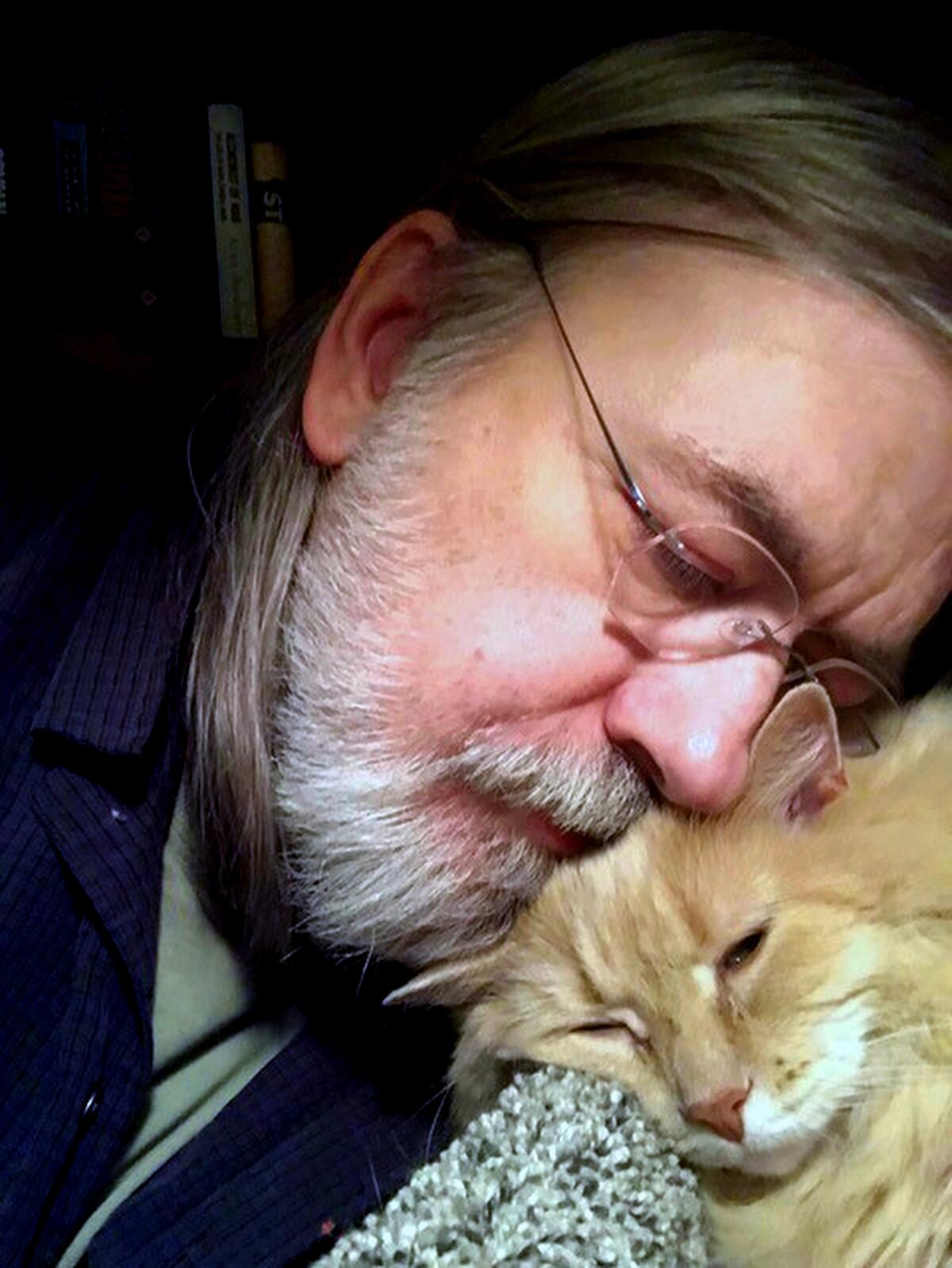
- Show more sharing options
- Copy Link URL Copied!
Caleb Carr, the novelist and military historian who died of cancer Thursday at age 68 , was best known for exploring the darker angels of human nature. His breakout novel, “The Alienist” (1994), helped pioneer the historical thriller as we know it, telling the grisly tale of a child psychiatrist tracking a killer of young male prostitutes in 1890s New York. His other books include a sequel, “The Angel of Darkness” (1997), and a historical study of terrorism and warfare, “Lessons of Terror” (2002).
But when I had a late-night, hourlong conversation with Carr in late January, we mostly talked about our mutual love of cats.
Carr, his illness already far along, was eagerly awaiting the publication of what he correctly figured would be his final book, “My Beloved Monster.” It’s the story of his bond with Masha, the Siberian forest cat with whom he shared his fortress of a home in upstate New York, near a ridge called Misery Mountain. Contracted to do a third “Alienist” book, Carr instead called an audible, choosing to write his first memoir. Dipping briefly into his tortured childhood — he was regularly beaten by his father, the journalist and Beat poet muse Lucien Carr, and grew up in hardscrabble bohemian conditions on Manhattan’s Lower East Side — the book’s primary subject is how Carr found solace in the unconditional love of animals, and with his grief for Masha, who died in April 2022.
Staring down death, talking about grief, he was casually, effortlessly, macabrely funny that night. He spoke of how he argued with his publisher, Little, Brown, to forgo the standard “Author of ‘The Alienist’” tag on the front cover, which features a photo of his blond, fluffy rescue cat: “I thought, ’Guys, they’re going to think I wrote a book about murdering cats or some horrible thing.’” He discussed the challenges of getting cat lovers to read a Caleb Carr book: “We may have to convince them. These may not be people who spend their time reading grim stories about serial killers 130 years ago.”

‘Alienist’ author Caleb Carr — grieving his late cat — reflects on his life amid battle with cancer
Caleb Carr discusses grief and dying — subjects that linger over his new nonfiction book, “My Beloved Monster,” and now loom over what might be the final months of his life.
April 15, 2024
And we talked a lot about what animals can teach us, and how they can even provide a kind of love that many of us didn’t know growing up. Even in childhood, when his father was knocking him down flights of stairs, Carr had pets to comfort him. “It’s amazing to think about it now, but there were cats, and other animals, that were trying to make me feel better,” he said. “The idea of that was so at odds with everything I was experiencing.”
I didn’t realize how much I had in common with the guy who wrote “The Alienist,” a book I admire for its vivid, doggedly researched detail but whose author I hadn’t studied. We were both basketball freaks; when we spoke, Carr’s beloved Knicks were on a roll (“They’re doing scarily well,” he said). We both survived childhoods fraught with danger, though mine wasn’t as dramatic or brutal as Carr’s. And we have both found comfort in the companionship of cats, known for self-sufficiency but also, quiet as it’s kept, quite loving and dependable when the chips are down. If you have a cat, and you’re not feeling well, that cat won’t stray far.
As we talked, my attention-hogging, gray-and-white tuxedo cat, Mr. Kitty, strolled in front of my laptop camera. “He’s cool-looking!” Carr enthused, the energy in his voice rising. I explained that he was a good cat but could also get pretty aggressive with his teeth and claws. He likes human flesh. “Well, they’re hunters,” Carr replied. “They’re wildlings. Sitting inside, being all the things that they’re pictured as being in Victorian literature, is not their nature.” Over the years I have always tried not to get mad at my cats for being cats — knocking things over, going on the attack when I least expect it. Carr’s words have actually helped me succeed in this endeavor.
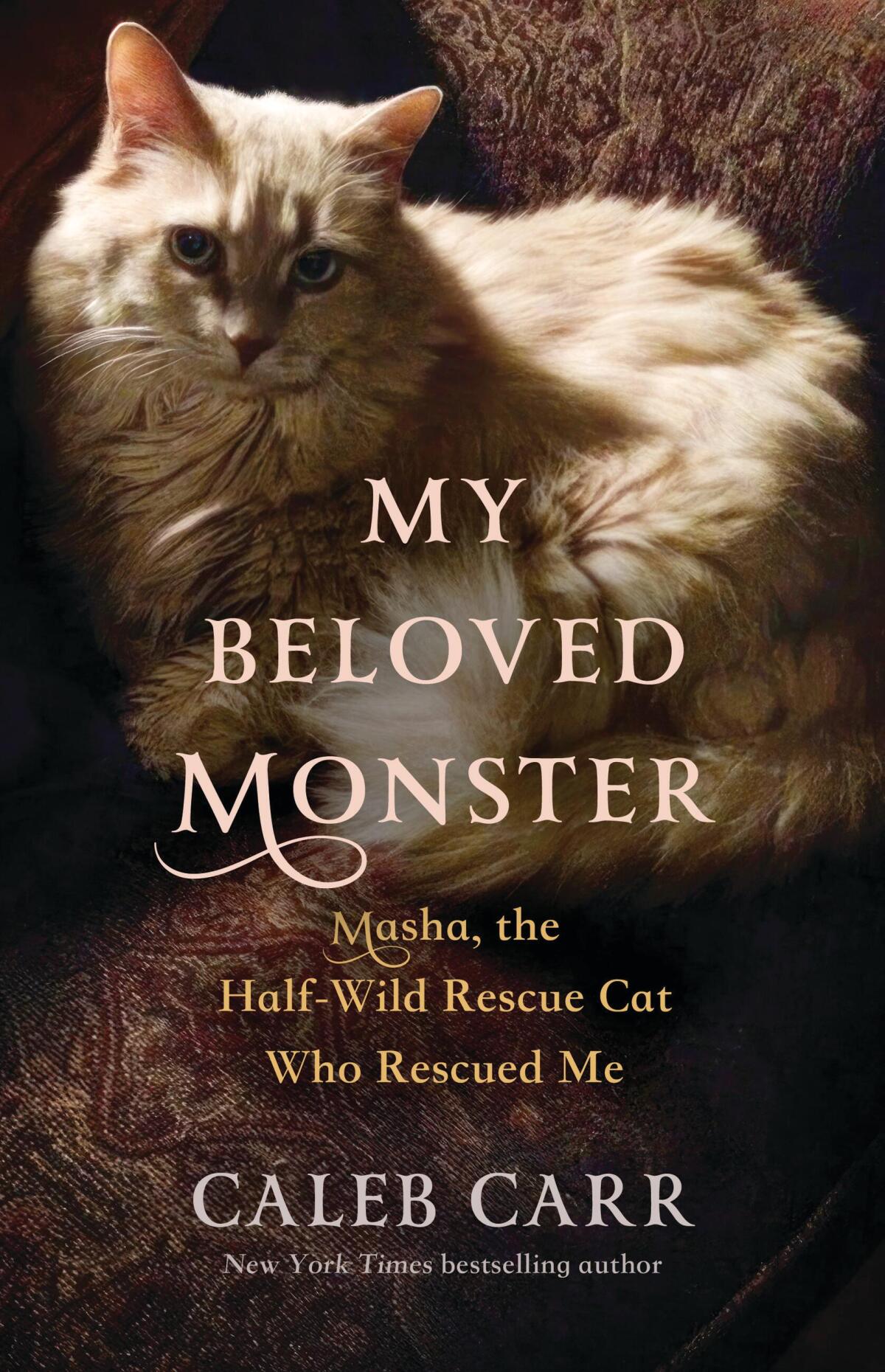
Carr, too, could have been a wildling. “I could have been one of those dead-eyed drone troublemakers that comes out of an abusive household very easily, if it hadn’t been for cats,” he told me. His childhood home life was chaos, but he and his siblings always had pets. “All the animals we had really did teach us enough about love that we understood it outside of any human definition, although this was never something I talked about with anybody,” he said.
Carr’s longtime agent, Suzanne Gluck, was also a friend since they were both in high school at Friends Seminary in Manhattan. The irony of a future military historian attending a Quaker school is not lost on Gluck. “He was such a square peg in a round hole,” Gluck said in an interview the day after Carr’s death. “The administration really didn’t know what to make of him.”
He didn’t talk much about his home life then. And he was no misanthrope. “He was this pied piper,” Gluck said. “He was this very vibrant, interesting, thoughtful, charismatic guy with a lot of friends. He wasn’t someone sitting in the corner, troubled and wanting to be alone.”
Gluck recalls her response when Carr told her he was writing about Masha instead of serial killers: “This might be where the music stops.” The assignment, after all, called for more “Alienist.” But Bruce Nichols, then the publisher at Little, Brown and Carr’s editor, loved the story of Masha. (As the husband of a veterinary behaviorist , his might have been the perfect pair of eyes for the project.)
“When I read it, I just stopped thinking about ‘The Alienist,’ ” Nichols said. “I stopped thinking about fiction and just thought about all the great books that had been written as memoirs by dog and cat owners”— books like “Merle’s Door,” Ted Kerasote’s account of lessons learned from his Labrador mix. Carr, and Masha, got the go-ahead.
Readers should be thankful for that. Carr wasn’t in need of redeeming in his final years, but “My Beloved Monster” is nonetheless an act of redemption. It gives specific life, and teeth and claws, to that old cliché about how we don’t rescue animals; they rescue us.
More to Read

Greg Iles almost died writing his latest book: ‘This might be the last thing I ever do’
May 23, 2024

Paul Auster, postmodern author behind ‘The New York Trilogy’ and ‘Smoke,’ dies at 77
May 1, 2024

Espionage fiction writers pick their favorite fictional spies
Feb. 27, 2024

Opinion: Is your cat bad? The problem is likely not with Fluffy — it could be you
Feb. 16, 2024

Company Town
Author Gabe Hudson’s cause of death revealed
Feb. 4, 2024

N. Scott Momaday, Pulitzer Prize winner and giant of Native American literature, dies at 89
Jan. 29, 2024

Katherine Min was ahead of her time. Four years after her death, her second novel proves it
Jan. 18, 2024

Big cats, little cats, weird cats collide at this purrfect L.A. experience
Jan. 16, 2024
Sign up for our Book Club newsletter
Get the latest news, events and more from the Los Angeles Times Book Club, and help us get L.A. reading and talking.
You may occasionally receive promotional content from the Los Angeles Times.
More From the Los Angeles Times

We’re living in a new age of McCarthyism, says author Patrick Nathan
June 3, 2024

L.A. Influential
Amanda Gorman: America’s future tense
June 2, 2024

A harrowing look at drummer Jim Gordon’s descent from rock talent to convicted murderer
May 31, 2024

16 romance novels to heat up your summer
share this!
May 30, 2024
This article has been reviewed according to Science X's editorial process and policies . Editors have highlighted the following attributes while ensuring the content's credibility:
fact-checked
trusted source
Fossil places extinct saber-toothed cat on Texas coast
by University of Texas at Austin
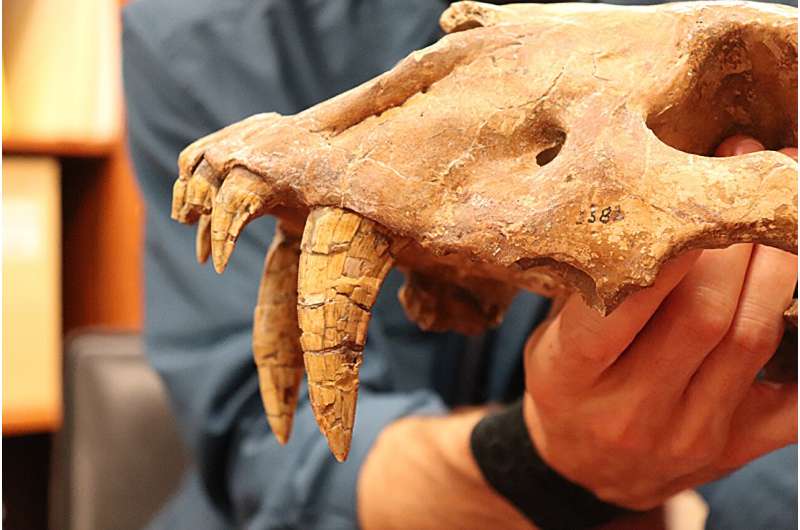
Important scientific finds don't always come in the biggest, buzziest packages. Sometimes new discoveries come in little ugly rocks. Such is the case of a 6-centimeter-wide, nondescript mass of bone and teeth that helped a scientist at The University of Texas at Austin expand the geographic footprint of a large cat that roamed the Earth tens of thousands of years ago.
"You can't even tell what it is, let alone which animal it came from," said John Moretti, a doctoral student at the UT Jackson School of Geosciences who led the research. "It's like a geode. It's ugly on the outside, and the treasure is all inside."
The research was published in the May issue of The Anatomical Record .
The fossil looks like a lumpy, rounded rock with a couple of exposed teeth that are a little worse for wear, having been submerged and tumbled along the floor of the Gulf of Mexico for thousands of years before washing up on a beach. But when the fossil was X-rayed at the Jackson School's University of Texas Computed Tomography Lab, Moretti saw there was more to the fossil that met the eye: a hidden canine tooth that had not yet erupted from the jaw bone.
It was just what Moretti needed to identify the fossil as belonging to a Homotherium, a genus of large cat that roamed much of the Earth for millions of years. Because this specific cat wasn't fully grown when it died, its distinctive saber-like canine tooth had not fallen into its permanent position. Nestled inside the jaw, the tooth was protected from the elements.
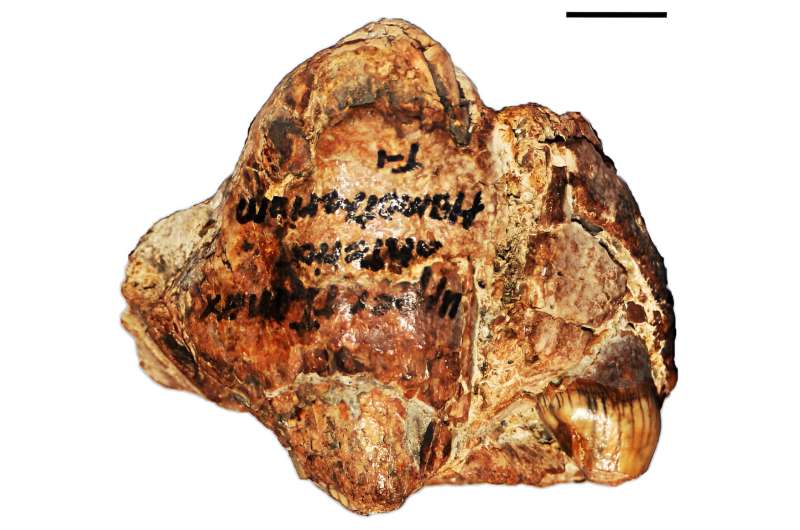
"Had that saber tooth been all the way erupted and fully in its adult form, and not some awkward teenage in-between stage, it would have just snapped right off," Moretti said. "It wouldn't have been there, and we wouldn't have that to use as evidence."
Homotherium spanned across habitats in Africa, Eurasia and the Americas. It was a large, robust cat about the size of a jaguar, with an elongated face, lanky front legs, and a sloping back that ended in a bobtail. Their serrated canine teeth were covered by large gum flaps, similar to domestic dogs today.
Their fossils have been found in several areas of Texas, but this fossil shows for the first time that the big cat roamed the now-submerged continental shelf that connects Texas and Florida. Scientists hypothesize that this stretch of land was a Neotropical corridor. Animals such as capybaras and giant armadillos that wouldn't have ventured farther north used this strip of humid grassland to move from Mexico to Texas to Florida.
The discovery that Homotherium lived along this corridor gives scientists a small glimpse into the ecology of this landscape during the Late Pleistocene, Moretti said. Big carnivores such as these cats helped shape the broader animal community, tamping down prey-animal populations and influencing regional biodiversity.
The fossil specimen was discovered more than 60 years ago on McFaddin Beach, south of Beaumont, by Russell Long, a professor at Lamar University, but was donated by U.S. Rep. Brian Babin, a former student of Long's who worked for 38 years as a dentist. Babin said that his training in paleontology and dentistry helped him recognize that what seems like a strange rock at first glance is actually an upper jaw bone and teeth.
The research is part of a larger initiative on McFaddin Beach fossils started in 2018 by William Godwin, curator at the Sam Houston State University Natural Science Museum and a co-author of the study. Co-authors also include Deanna Flores, Christopher J. Bell, Adam Hartstone-Rose, and Patrick J. Lewis.
Provided by University of Texas at Austin
Explore further
Feedback to editors

Craft unfurls China's flag on the far side of the moon and lifts off with lunar rocks to bring home
46 minutes ago

Informal water contracts could provide quicker, cheaper ways to reduce impact of droughts

Three boys found a T. rex fossil in North Dakota. Now a Denver museum works to fully reveal it

New 3D-printed microscale photonic lantern opens opportunities for spatial mode multiplexing
6 hours ago

New catalyst brings commercial high-efficiency zinc-air batteries closer to reality
12 hours ago

Scientists call for conservation of Amazon's unseen water cycle

Study shows electric vehicles can have positive impact on air quality and public health in some cities, but not all

Study reveals reversible assembly of platinum catalyst
13 hours ago

Study finds industrial air pollution contributes to New Mexico's low birthweight

Shape and depth of ocean floor profoundly influence how carbon is stored there, study shows
Relevant physicsforums posts, a dna animation.
May 29, 2024
Probability, genetic disorder related
May 28, 2024
Looking For Today's DNA Knowledge
May 27, 2024
Covid Vaccines Reducing Infections
Human sperm, egg cells mass-generated using ips, and now, here comes covid-19 version ba.2, ba.4, ba.5,....
May 25, 2024
More from Biology and Medical
Related Stories

Evidence suggests saber-toothed cats held onto their baby teeth to stabilize their sabers
Apr 30, 2024

Ice Age manatees may have called Texas home
Oct 1, 2020

How the first cat-like saber-tooth predator was discovered, and why it differs from modern cats
Mar 31, 2022

Bizarre snake-like worm's secrets revealed in CT scans
Feb 12, 2024

Beaver fossil named after Buc-ee's
Mar 27, 2023

Ancient DNA offers new view on saber-toothed cats' past
Oct 19, 2017
Recommended for you

Captivating blue-colored ant discovered in India's remote Siang Valley
16 hours ago

Discovery of 48-million-year-old daddy longlegs with their iridescent, metallic appearance intact
18 hours ago

Scientists find evidence of hot spring oasis during last ice age in central Europe
19 hours ago

Greener, more effective termite control: Natural compound attracts wood eaters
Jun 1, 2024

Novel technique uncovers clues to disappearance of North America's large mammals 50,000 years ago
May 31, 2024
Let us know if there is a problem with our content
Use this form if you have come across a typo, inaccuracy or would like to send an edit request for the content on this page. For general inquiries, please use our contact form . For general feedback, use the public comments section below (please adhere to guidelines ).
Please select the most appropriate category to facilitate processing of your request
Thank you for taking time to provide your feedback to the editors.
Your feedback is important to us. However, we do not guarantee individual replies due to the high volume of messages.
E-mail the story
Your email address is used only to let the recipient know who sent the email. Neither your address nor the recipient's address will be used for any other purpose. The information you enter will appear in your e-mail message and is not retained by Phys.org in any form.
Newsletter sign up
Get weekly and/or daily updates delivered to your inbox. You can unsubscribe at any time and we'll never share your details to third parties.
More information Privacy policy
Donate and enjoy an ad-free experience
We keep our content available to everyone. Consider supporting Science X's mission by getting a premium account.
E-mail newsletter

IMAGES
VIDEO
COMMENTS
Catway is a Super Rare Cat that can be unlocked when beating the stage Clionel Ascendant appearing on the 7th, 8th, 21st and 22nd of every month. True Form increases health and attack power. This unit was later added into The Battle Cats Unite via the 1.0.7 September 15, 2023 Live Download Patch and the stage to unlock him is permanent. Evolves into Drone Cat at level 10. Evolves into Time ...
Clionel Dominant has finally been DOMINATED! The pain has ended, and now I have Catway's true form. 😍More Battle Cats • https://www.youtube.com/playlist?lis...
Weirdly cute cats run rampant across the galaxy! Here's your chance to raise and play with them for free! [Tutorial] Guide on how to time travel in battle cats. A guide to time travelling! Sometimes missing bomber awakens are just a pain and you don't want to wait for weeks again, or the 1 hour xp festival/catfruit buffet is just not enough for ...
I do know that Lucas IV made a Wide Putin meme with TF of Modern Cat (don't know it's name tho oof) 5. Reply. Share. maglev-whale. • 3 yr. ago. Cool fact: Future Cat has human teeth, look at their KB. 4.
DISCORD: https://discord.gg/PuszvcCdmAmusic: https://youtu.be/ExCw0t6_feIyes i rewrote the intro to "re-enter" because someone complained about it
Courier and pizza completely outshine 2 of his niches. Cyborg and slapstick have better generalist value than him. If only he was a rare unit, he would've been a really useful anti-angel ranged attackers for 4 crowns. Right now, in most of the player's accounts, there is no real reason to really put time traveller in any late game loadout. 1 ...
Stray x Travel Cat Harness & Leash Set - Limited Edition $39.99. Save $18.00. Argylle x Travel Cat "Spy" Cat Backpack Complete Collection Bundle $169.95 $187.95. Stray x Travel Cat Backpack - Limited-Edition $139.99. The Jackson Galaxy Convertible Cat Backpack Carrier $139.99. Argylle x Travel Cat Collar & Bandana Set - Officially Licensed $14.99.
I will start reviewing more advents units later..
In True Form, Time Traveller Cat gains a more usable 10.6k HP (26.6k effective) and DPS of 2200 (3900 effective). Time Traveller is viable as a general attacker in midgame now, with durability on par with Drama and better DPS. In lategame, however, it falls behind again as Slapsticks becomes available with far superior general stats.
The Irish episode in Time Cat brings together St Patrick and his mission, the folk belief of Ireland overridden with snakes until St Patrick banishes them (there's an excellent scene of Gareth fighting a snake), and an element of romance between Jason and Diahan.Diahan is actually very much a prototype for Eilonwy. She is feisty, strong-minded, has "red-gold hair tossed about her soldiers ...
Jason learns that his cat, Gareth, is able to talk and has the power to travel to nine different points in world history (his "nine lives"). Jason convinces Gareth to take him along and their adventures begin where cats are considered divine, in Ancient Egypt in the year 2700 BC. Subsequently, they visit Rome, where they are taken in by the Old ...
167 ratings21 reviews. Topher's cat, Ka, is not always who she seems to be. Sometimes she disappears for days and all that Ka has left by his bedside is a little stone carving of a cat. One days Ka leaves a clue on Topher's computer. She types Bubastis and soon Topher finds himself time-travelling to Ancient Egypt where Ka is in terrible danger.
Cat Info. Compare all cats from The Battle Cats with My Gamatoto. From ubers to crazed and more, check out all their stats including range, damage, and abilities. Find out which are the best cats today!
Paperback. $6.88 14 Used from $3.08. Audio CD. $24.97 2 New from $20.99. Topher and his father are trying to get over the death of Topher's mother, an Egyptologist, when they take in a stray cat. This cat bears an uncanny resemblance to a cat ornament given to Topher by his mother, and so they name it Ka, meaning double.
H. G. Wells' Time Traveller inhabits uniform Newtonian time. Where relativistic/quantum travelers into the past follow spacetime curvatures, past-bound Wellsians must reverse their direction of travel relative to absolute time. William Grey and Robin Le Poidevin claim reversing Wellsians must overlap with themselves or fade away piecemeal like the Cheshire Cat. Self-overlap is physically ...
It's "time travels with Schrödinger's cat." The Benevolent Grandfather Paradox. Let us recall briefly the grandfather paradox from an earlier chapter. A time traveler goes back in time and kills his own grandfather. A contradiction ensues. For if the grandfather is killed; the grandson is never born; there is no time traveler and the ...
A TikTok 'time traveller' said to be sent back from the future has informed us of five important dates to put in our calendars. To see the dates, watch video below: The self-proclaimed 'Time ...
The Tower of Time is a building that allows cats to feel the building where time flows, with flowing line structures dotting the landscape: When the sunlight shines into the open space of the upper spiral. Feel the flow of time in the changing light and shadow. Sleek and sinuous curves. Creating the beauty of organic living.
99K subscribers in the battlecats community. Weirdly cute Cats run rampant across the galaxy! Here's your chance to raise and play with them for free!
Discover more Time Travel anime on MyAnimeList, the largest online anime and manga database in the world! Hide Ads ... Yuuta Iridatsu finds his soul separated from his body and in the care of a perverse cat spirit, Chiranosuke. As a spirit, Yuuta wanders around his residence, the Korai House, aiming to regain his body and observe the other ...
Traveler-Feather is about the never ending time loop of pain and revenge that Jayfeather and Fallenleaves are trapped in until one of them finally decides to...
Time-travel adventure Teaches children about loving family Mirai is a delightful and imaginative anime movie for children that revolves around Kun, a young boy who feels neglected by the arrival ...
The 25 best low-cost airlines in the world (in alphabetical order) AirAsia Group. Air Baltic. Air Canada Rouge. Cebu Pacific. easyJet. Eurowings. FlyDubai. FlyNAS.
On May 24, 2024, a Singapore Airlines flight from Singapore to London encountered severe Clear Air Turbulence (CAT). Despite being in clear skies, the aircraft experienced sudden and intense turbulence, leaving one dead (due to a suspected heart attack) while leaving other passengers and crew members severely injured.This followed another incident on May 26, 2024, when 12 people (including six ...
Over this time, I have lost family members, left a career and struggled with very difficult missions. The hardships have simultaneously made me feel both destroyed and blessed beyond measure.
I can time travel backwards by changing my timezone to Midway (GMT -11:00) allowing me to reach January 01, 4:00 AM (GMT -11:00) . THE "-2 +2" TRICK or THE ENERGY GLITCH. Exit Battle Cats completely. This step may be unnecessary for some users but might be necessary for others. Try it out yourself to see what works for you.
A self-portrait of author Caleb Carr and his cat Masha at his home in Cherry Plain, N.Y. Carr died of cancer on May 23, 2024. Caleb Carr, the novelist and military historian who died of cancer ...
How the first cat-like saber-tooth predator was discovered, and why it differs from modern cats Mar 31, 2022 Bizarre snake-like worm's secrets revealed in CT scans
CEO Jensen Huang declared the beginning of a new industrial revolution where Nvidia was helping turn $1 trillion of data centers into "AI factories," as its already meteoric stock topped $1,000.